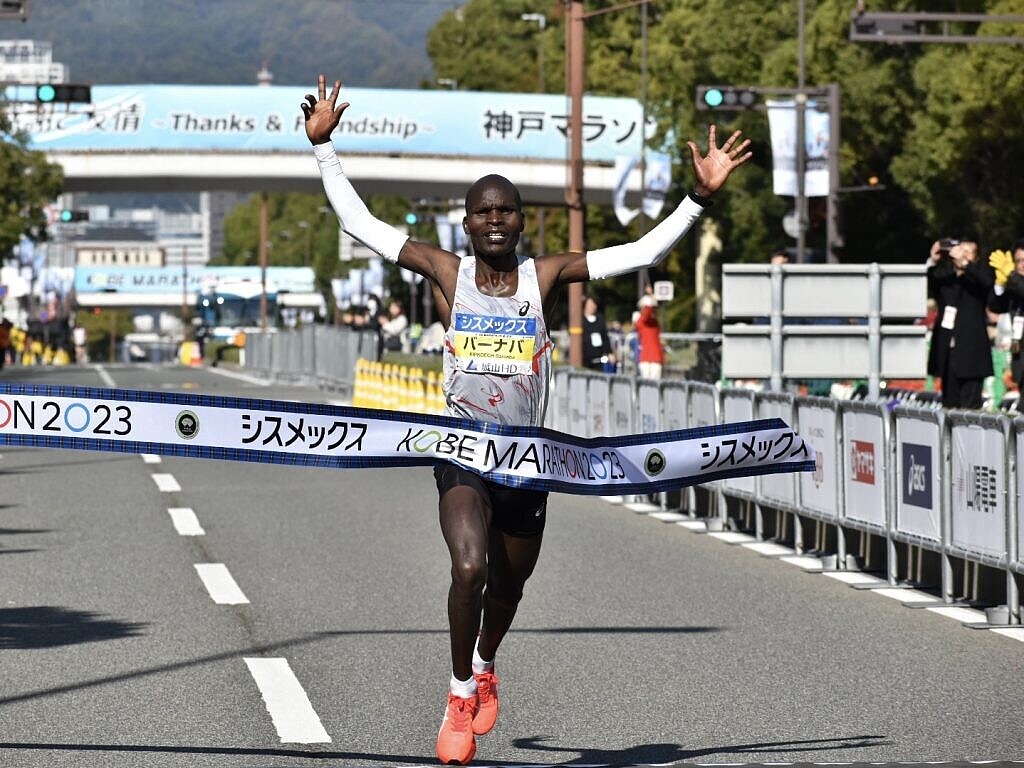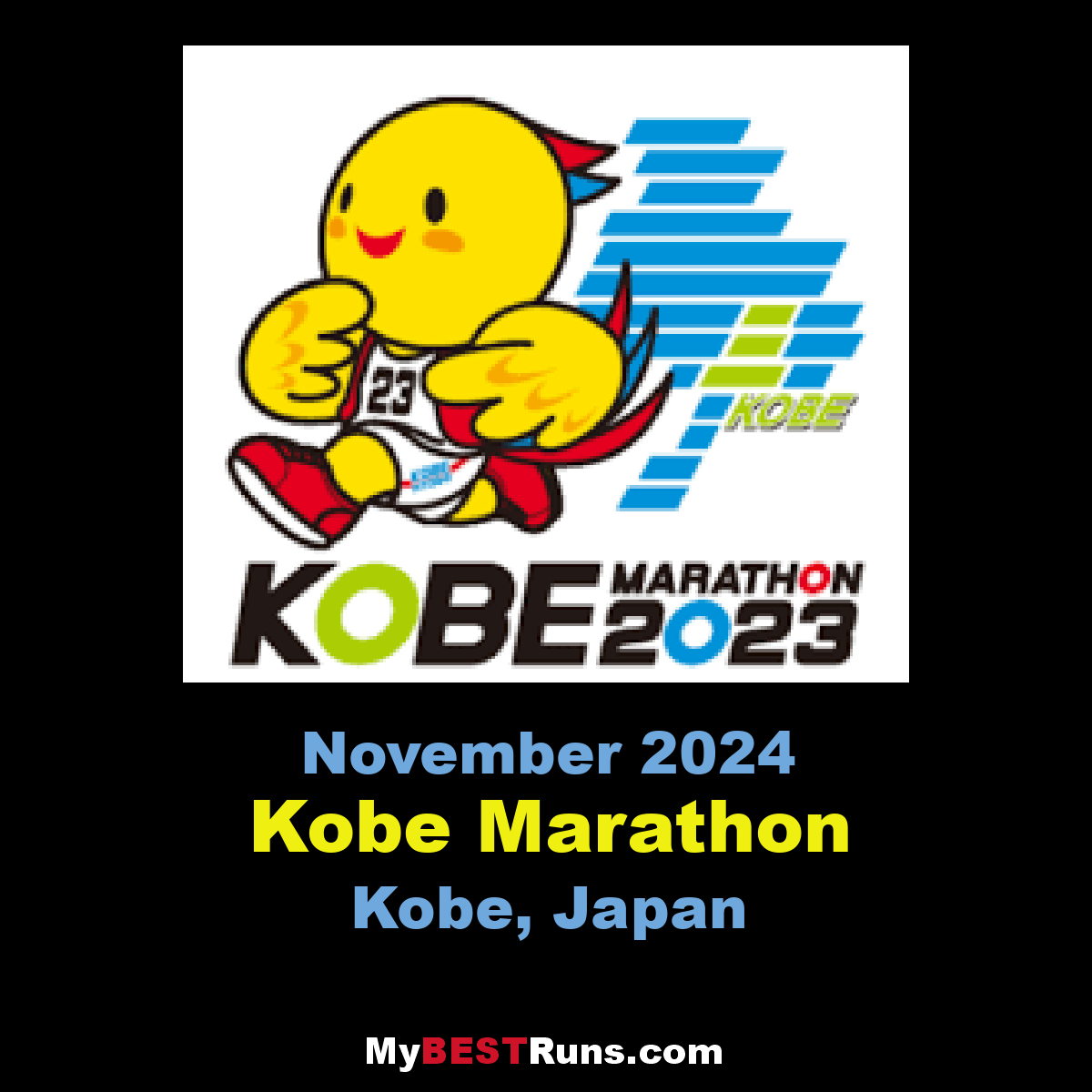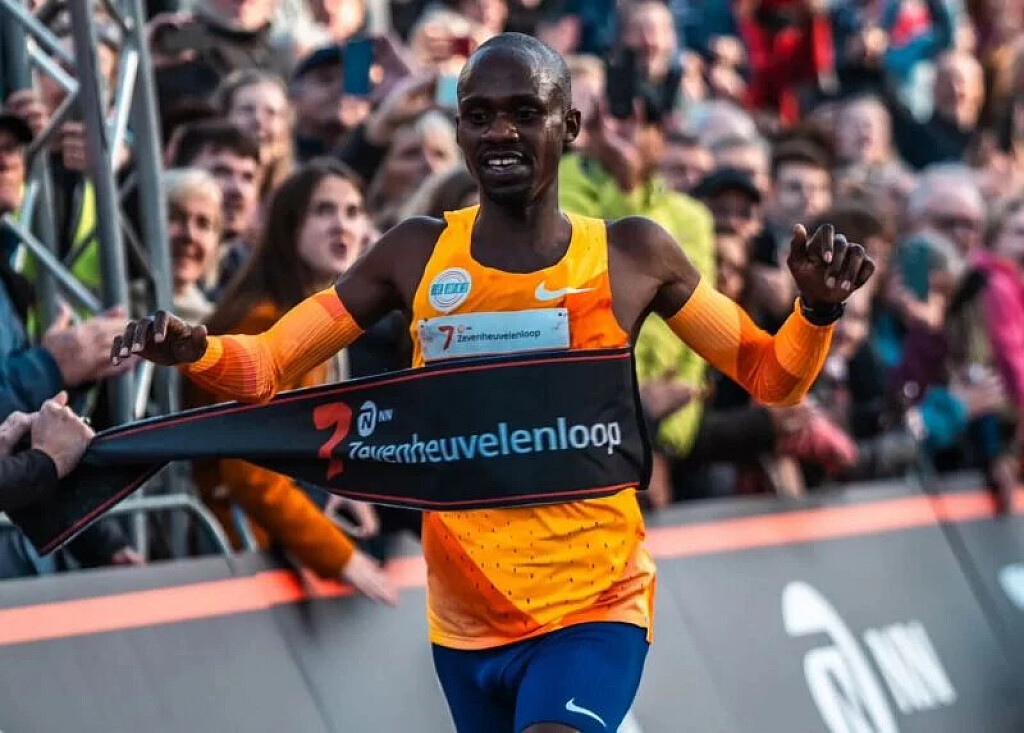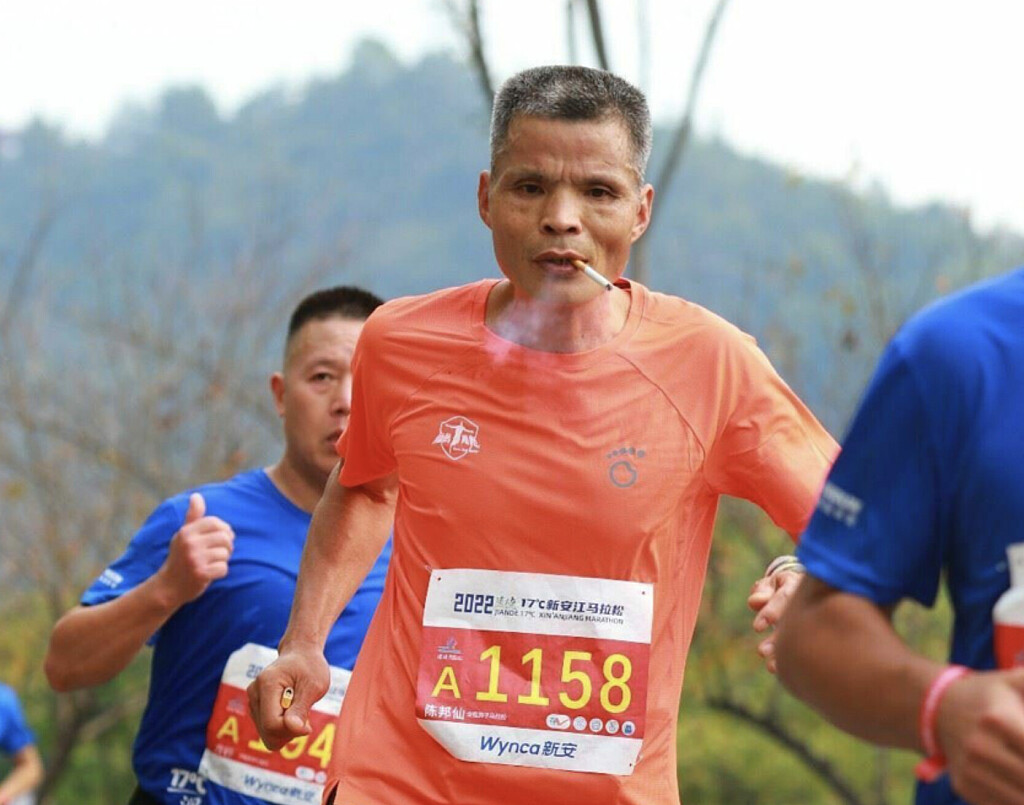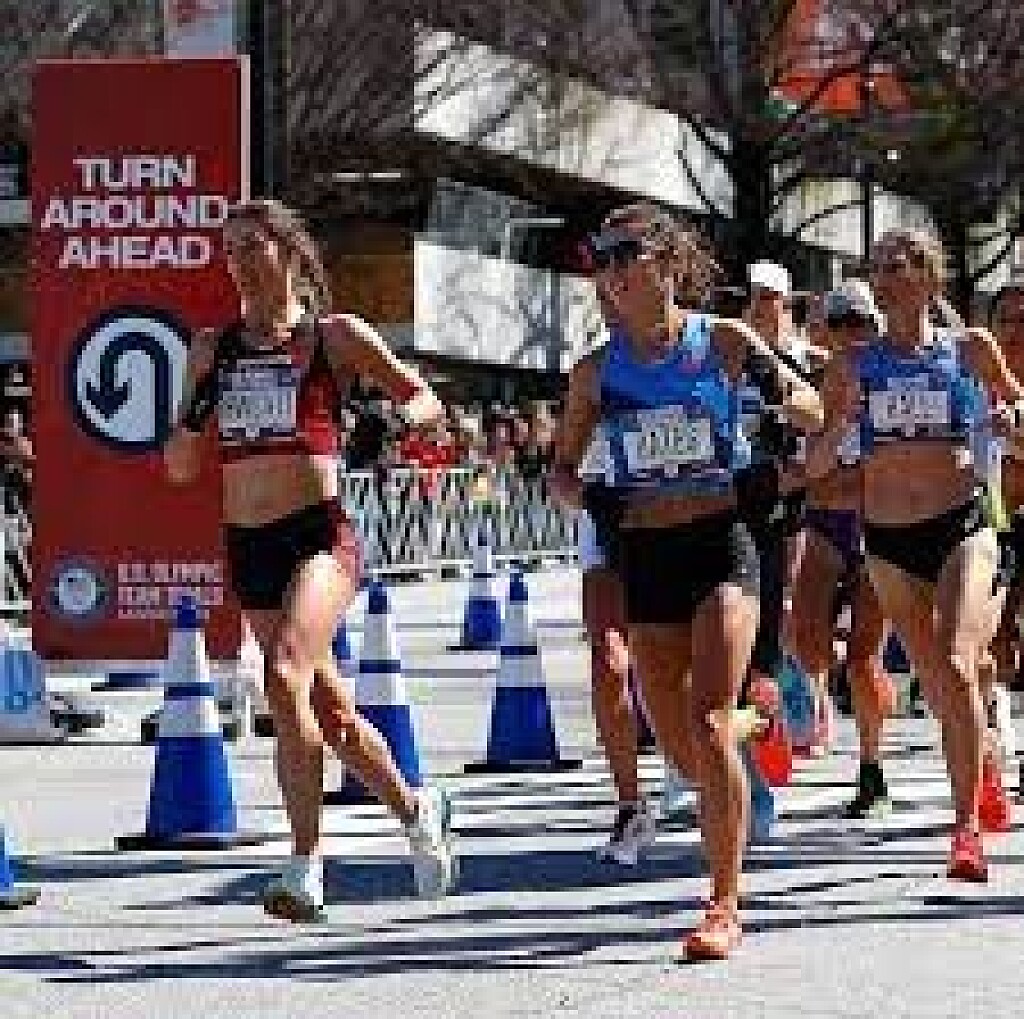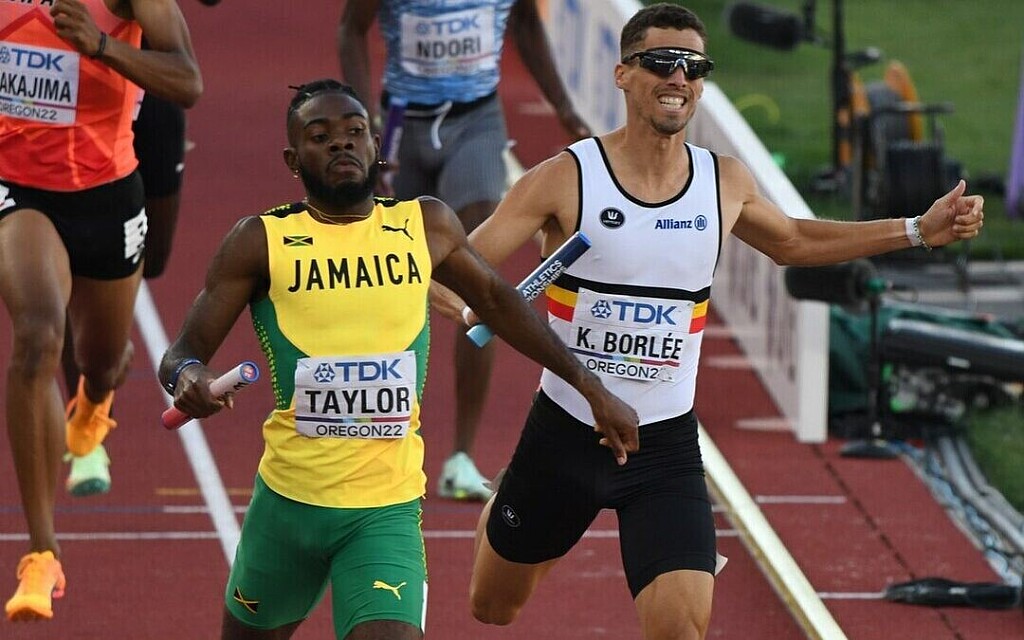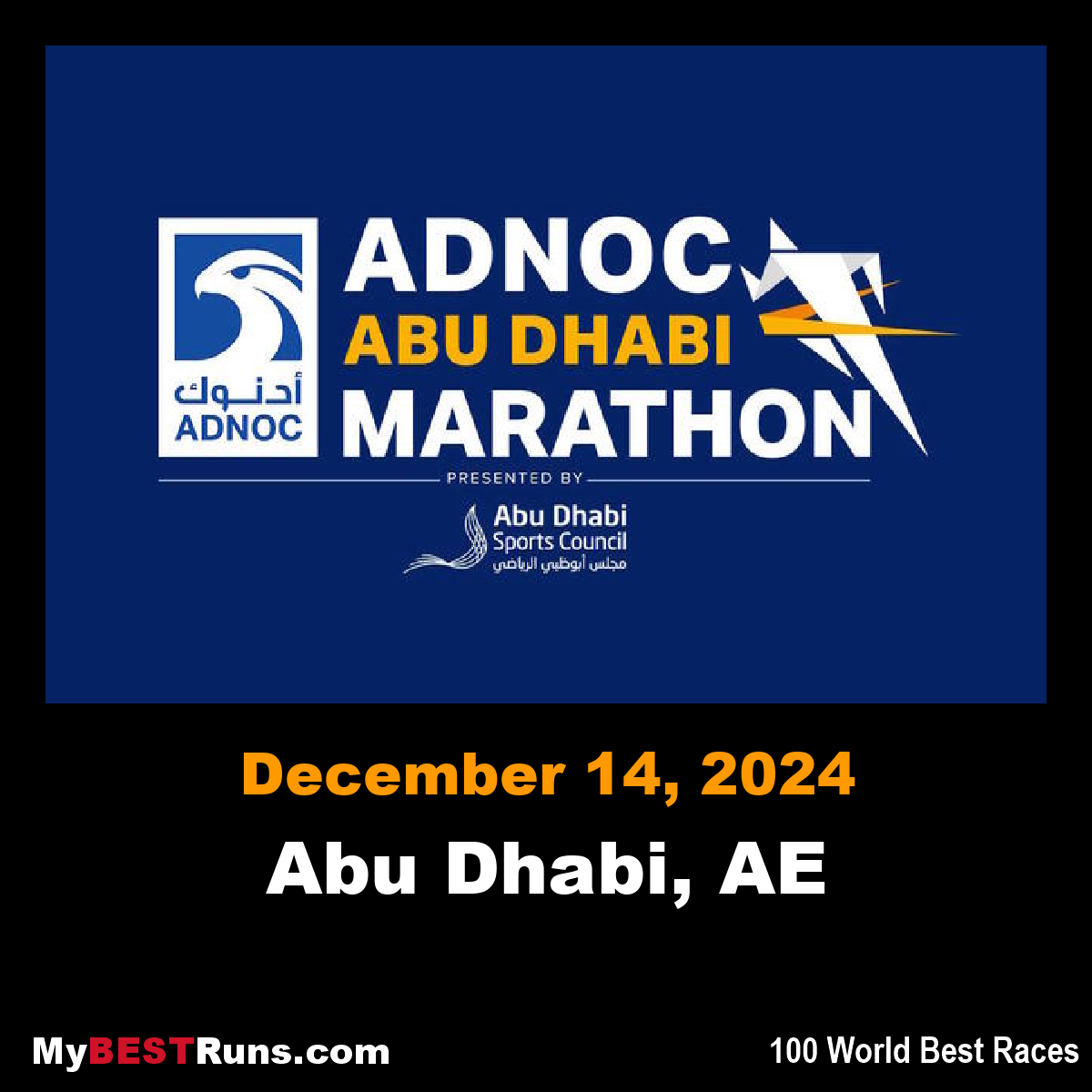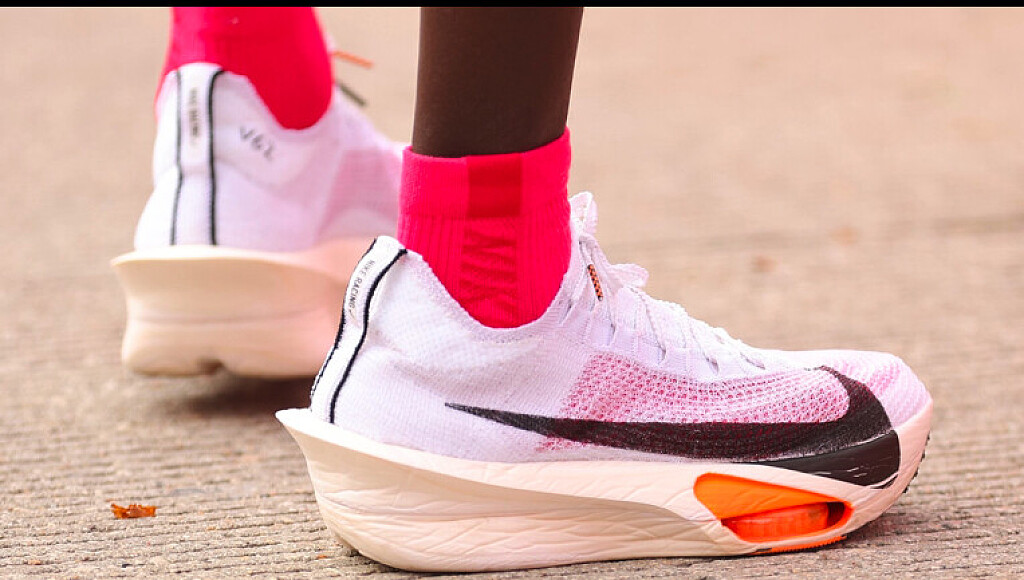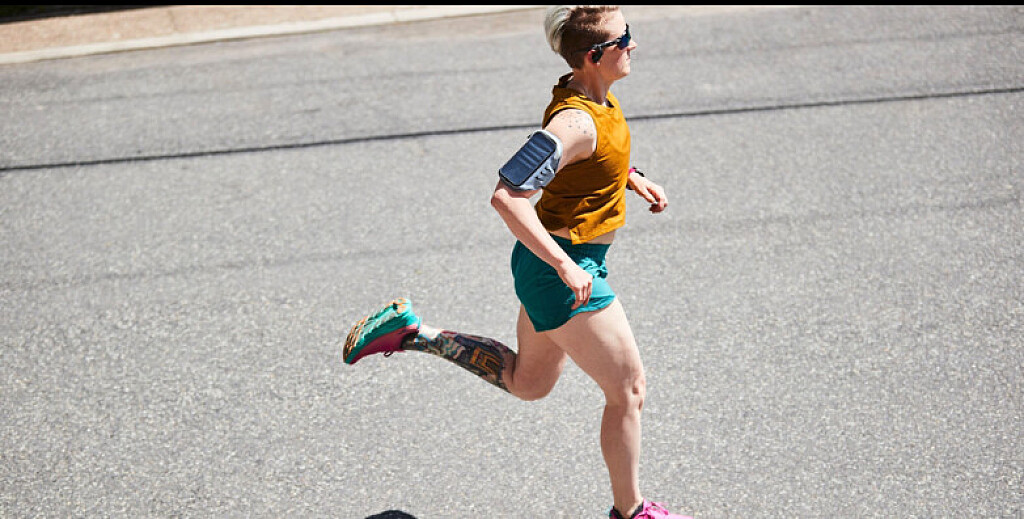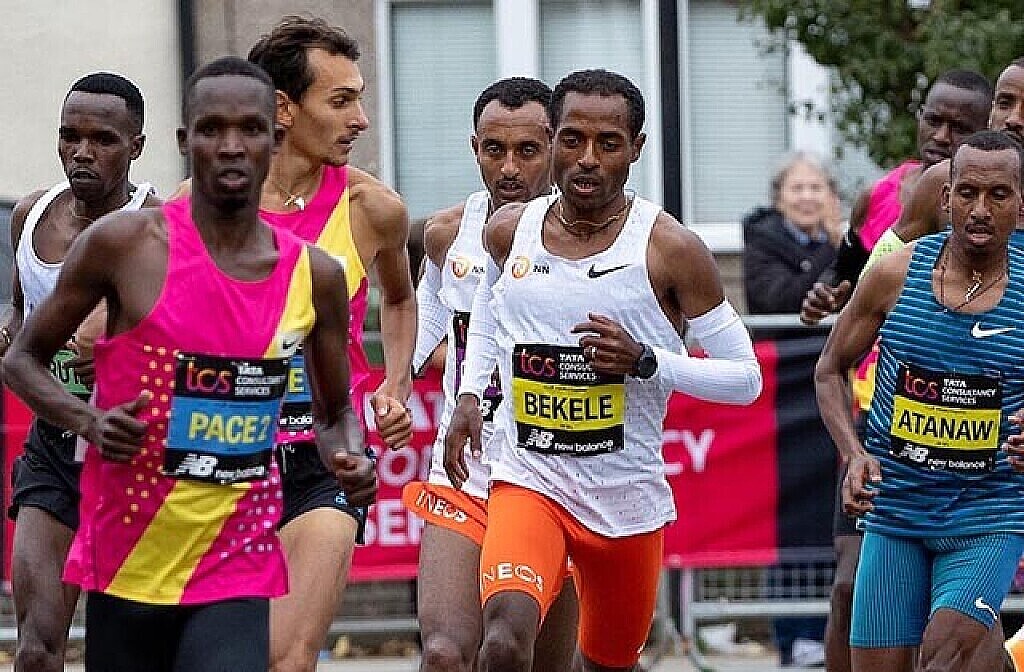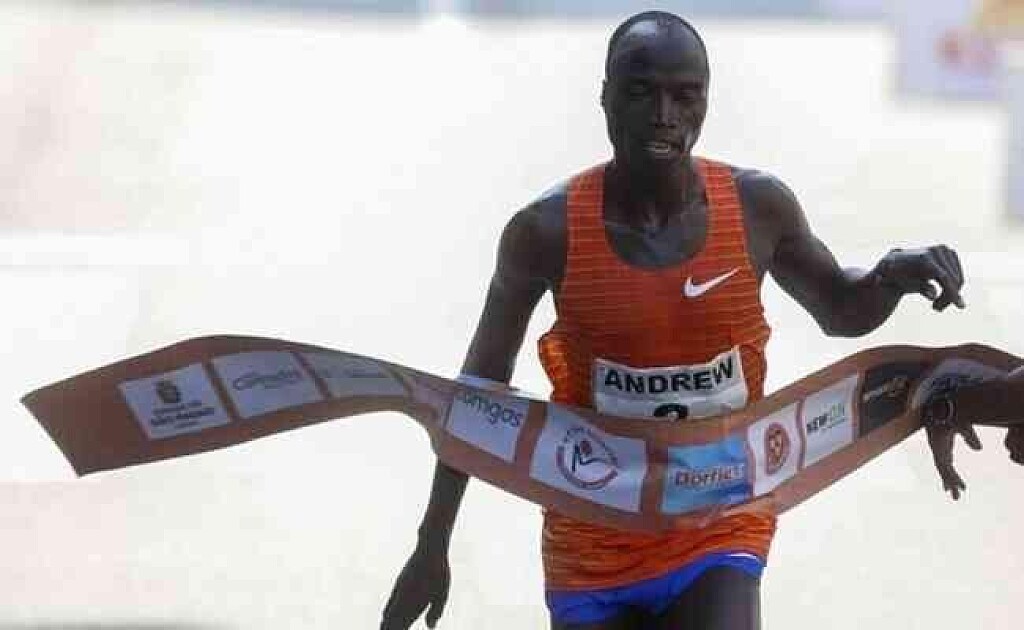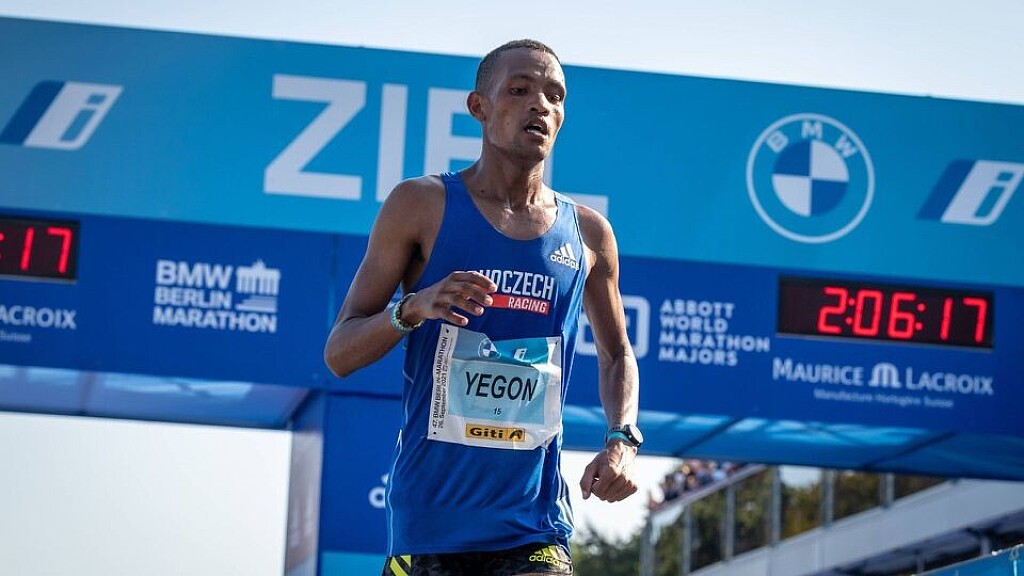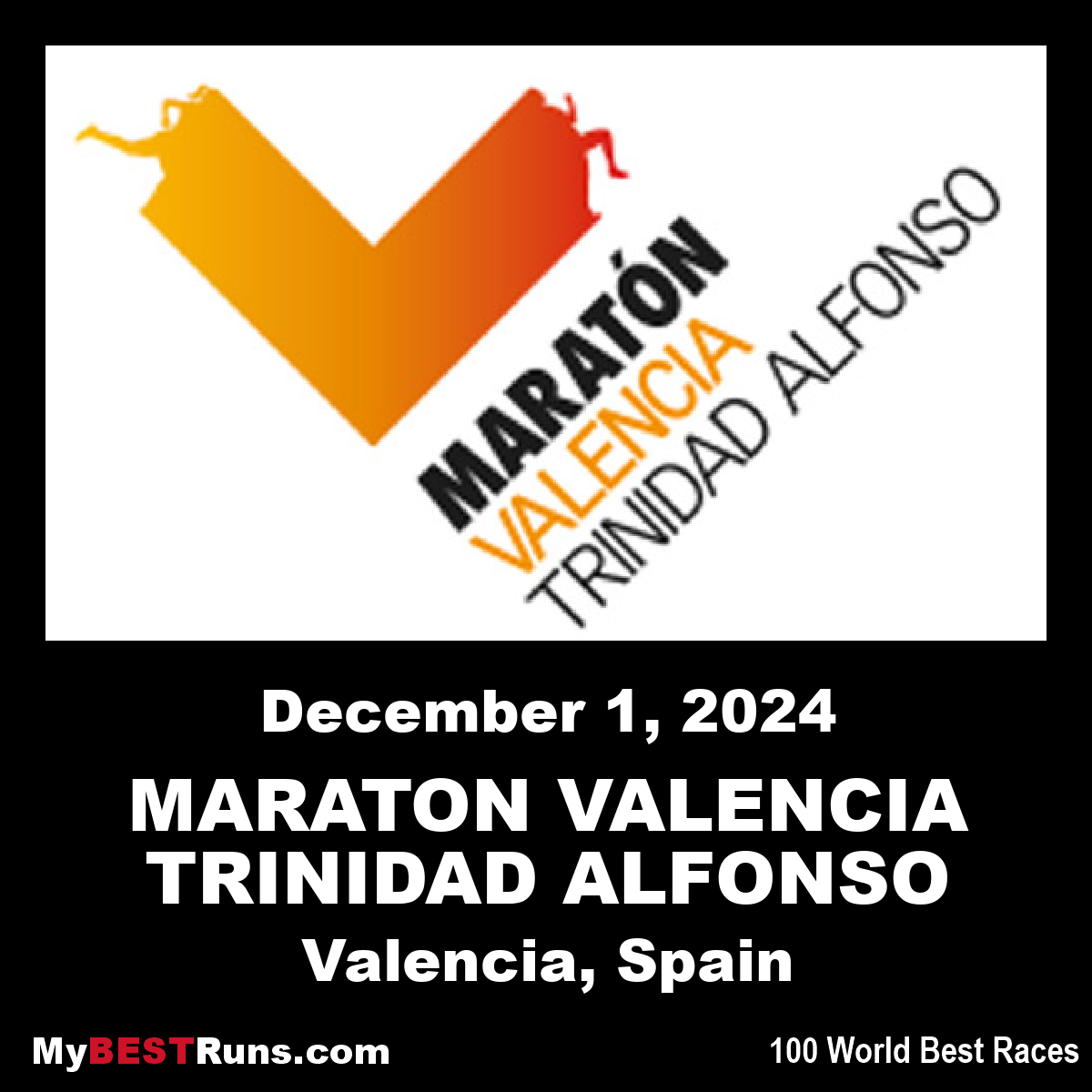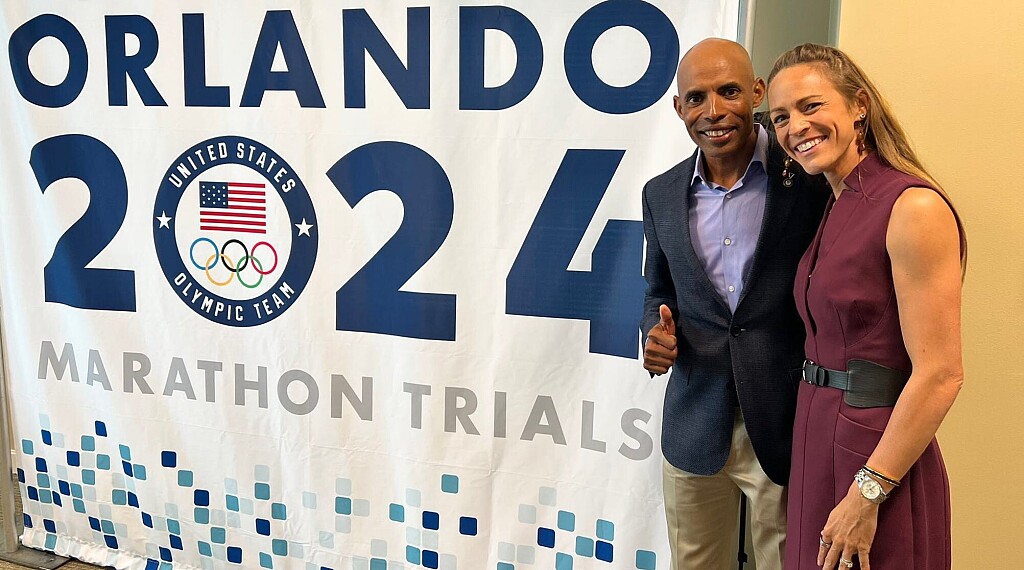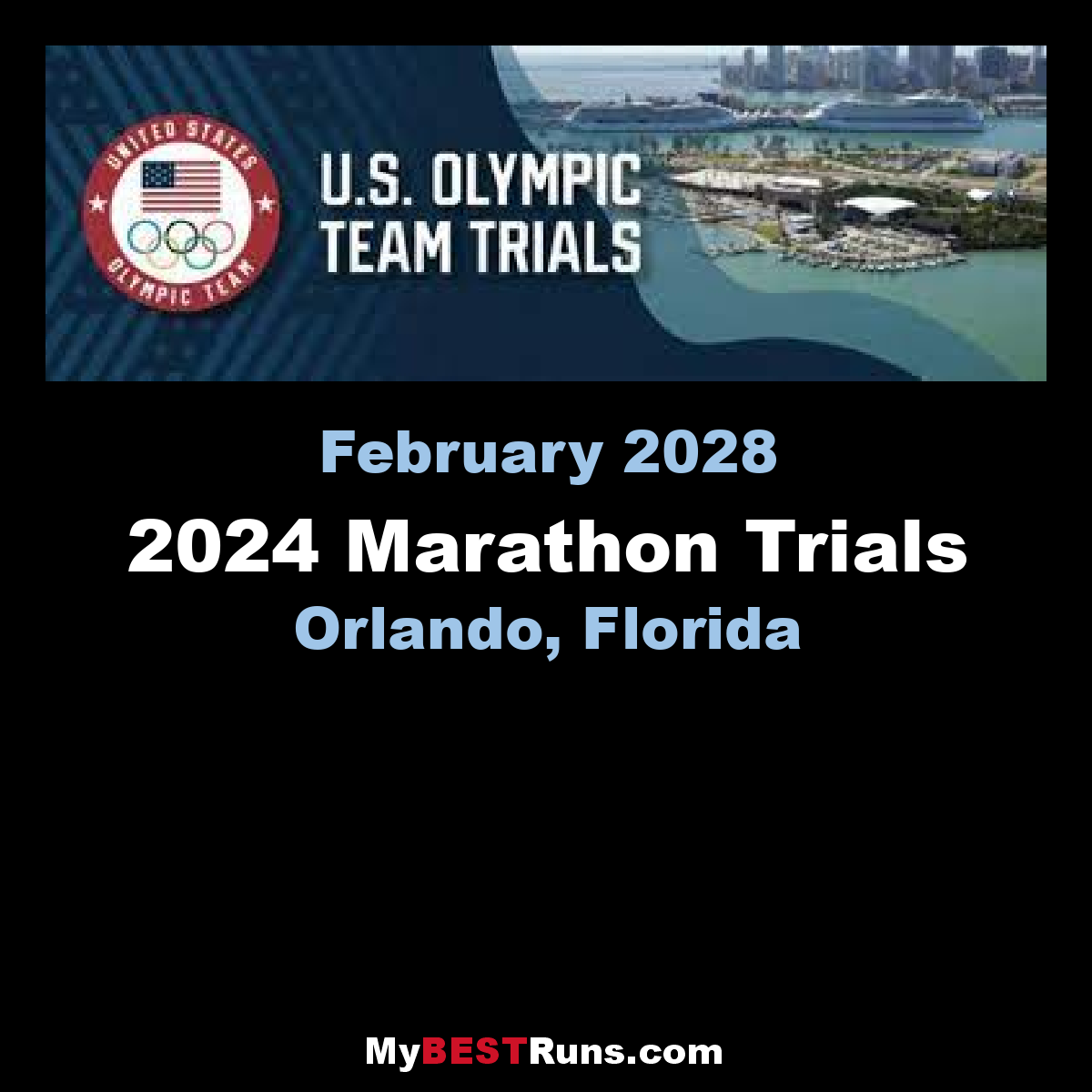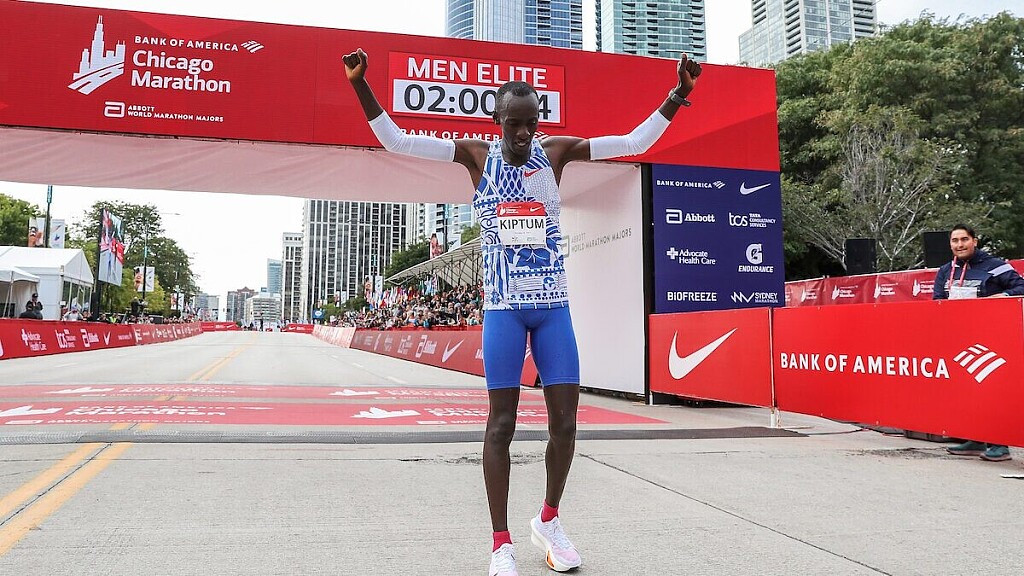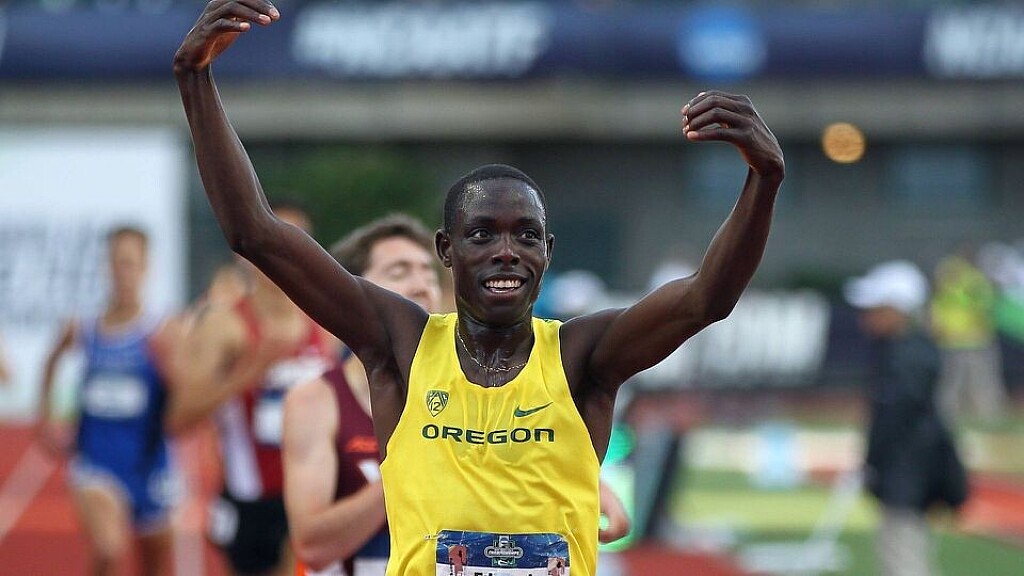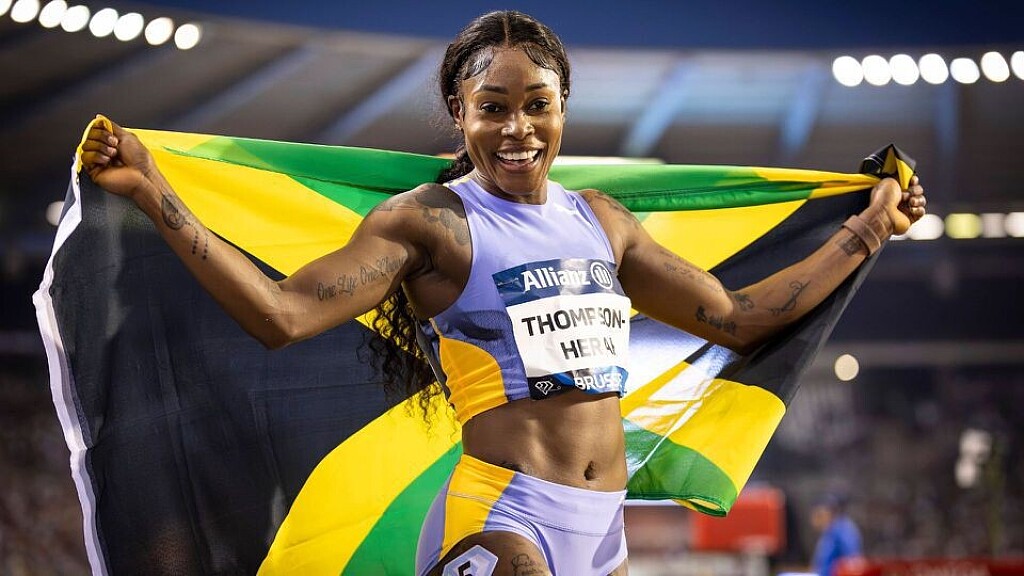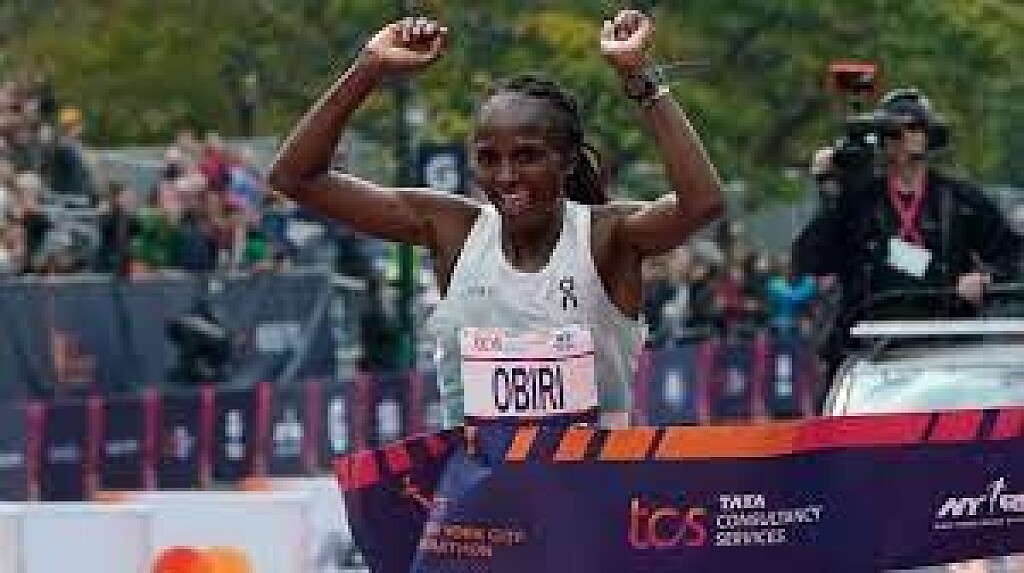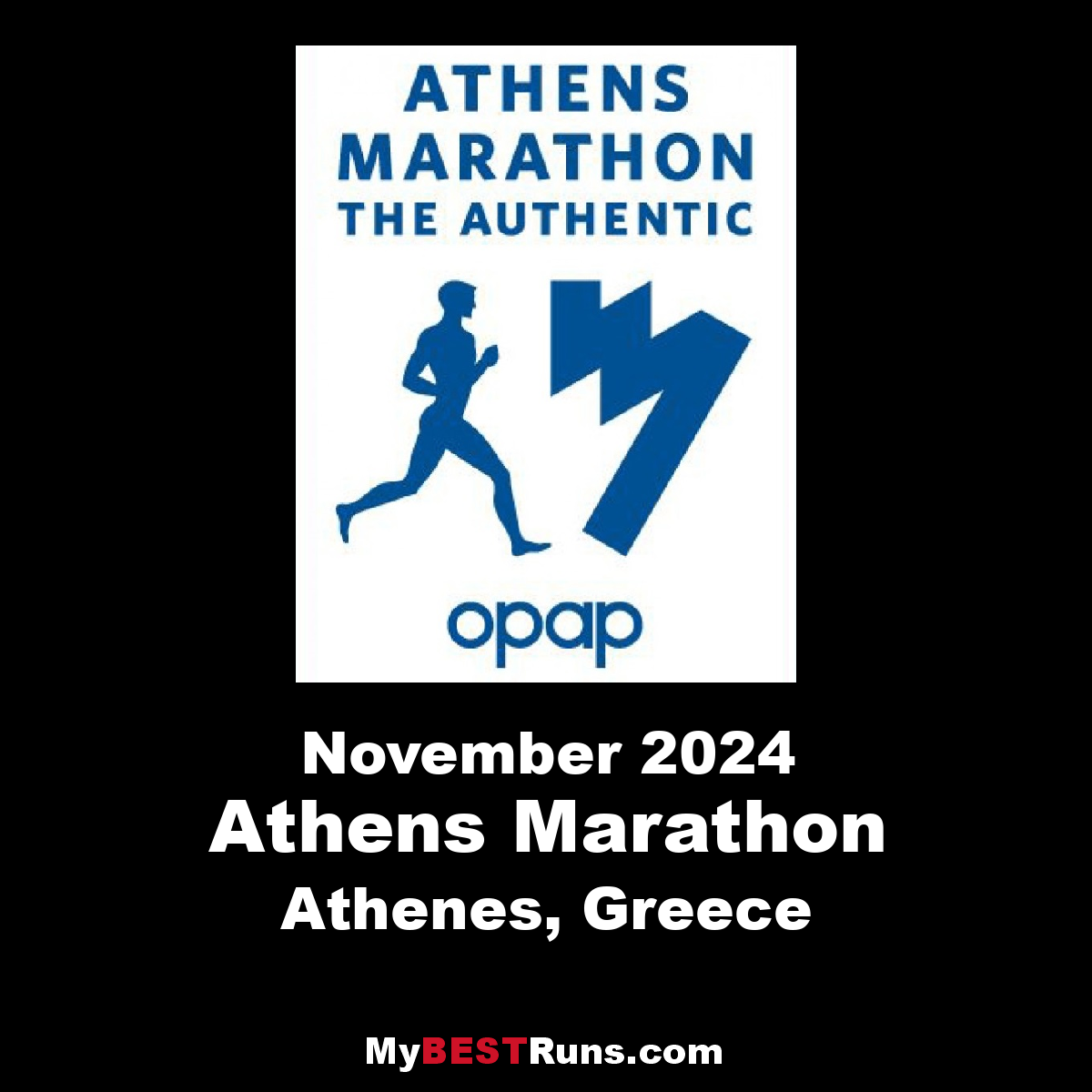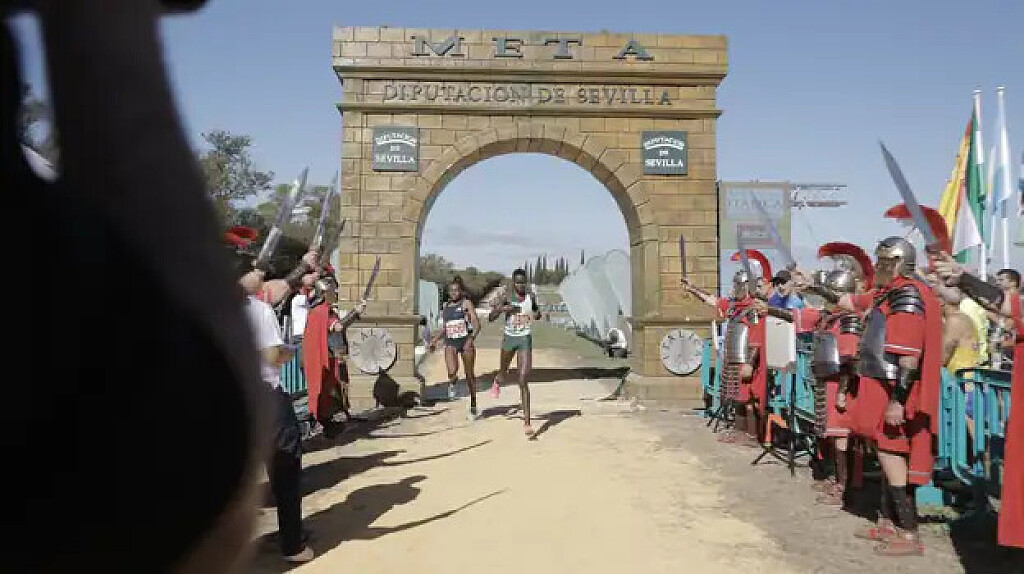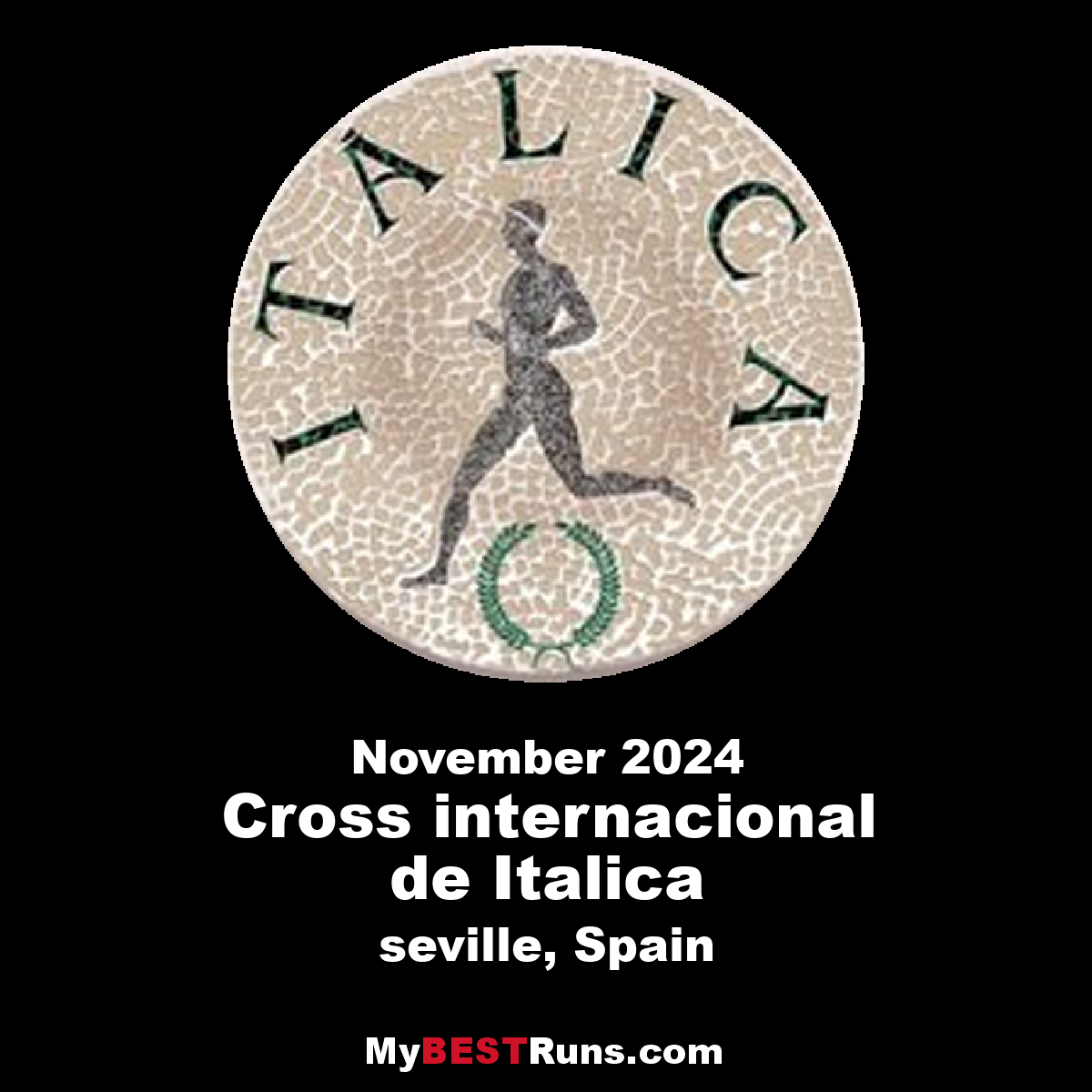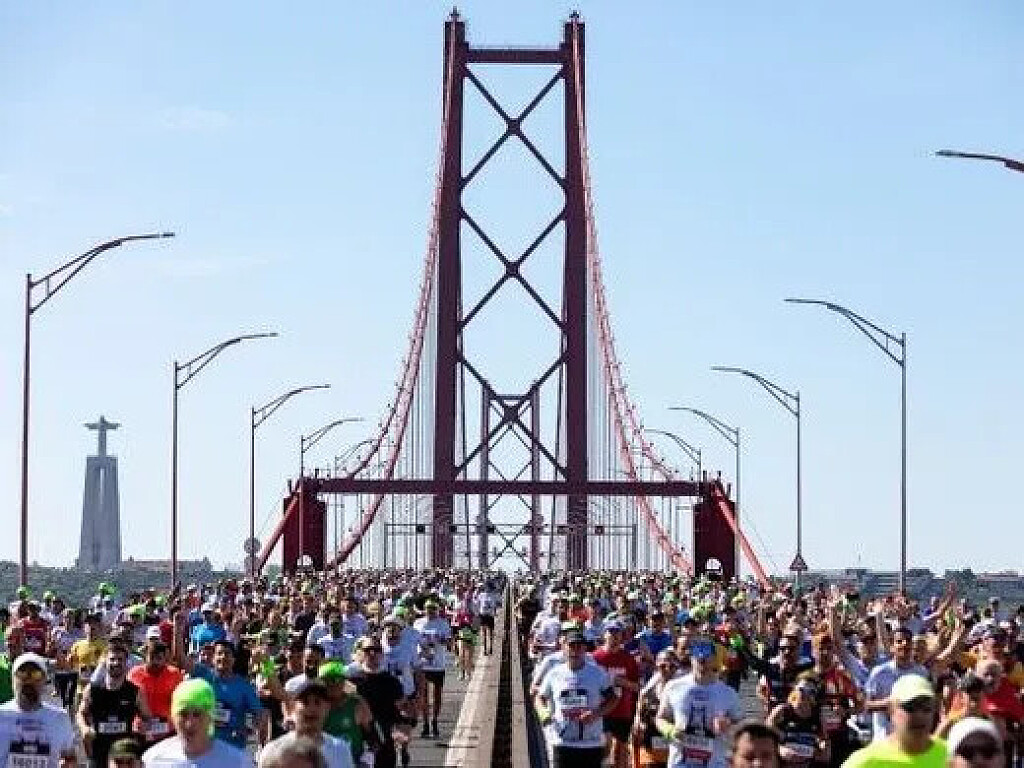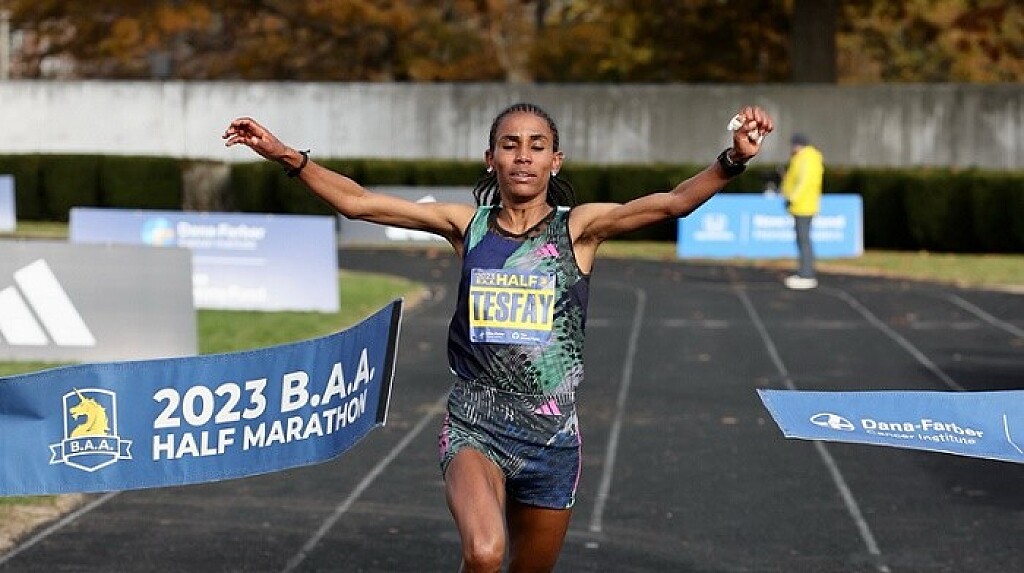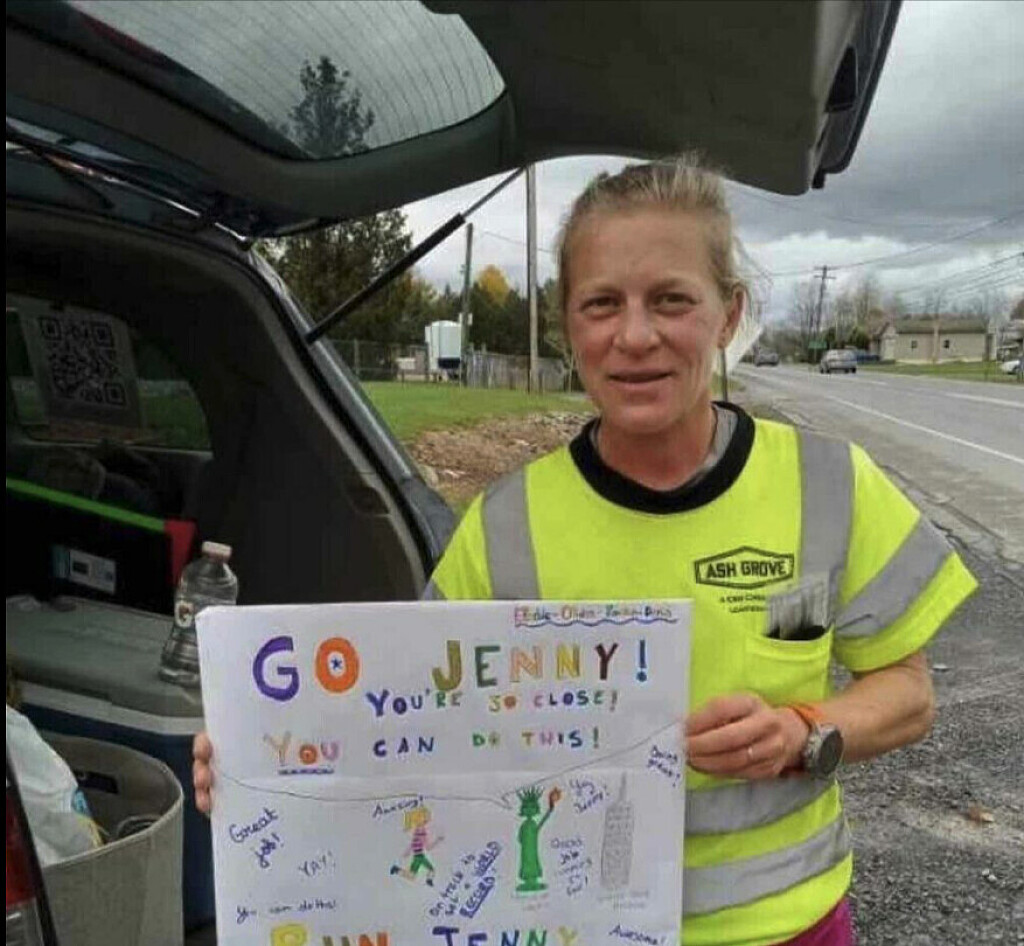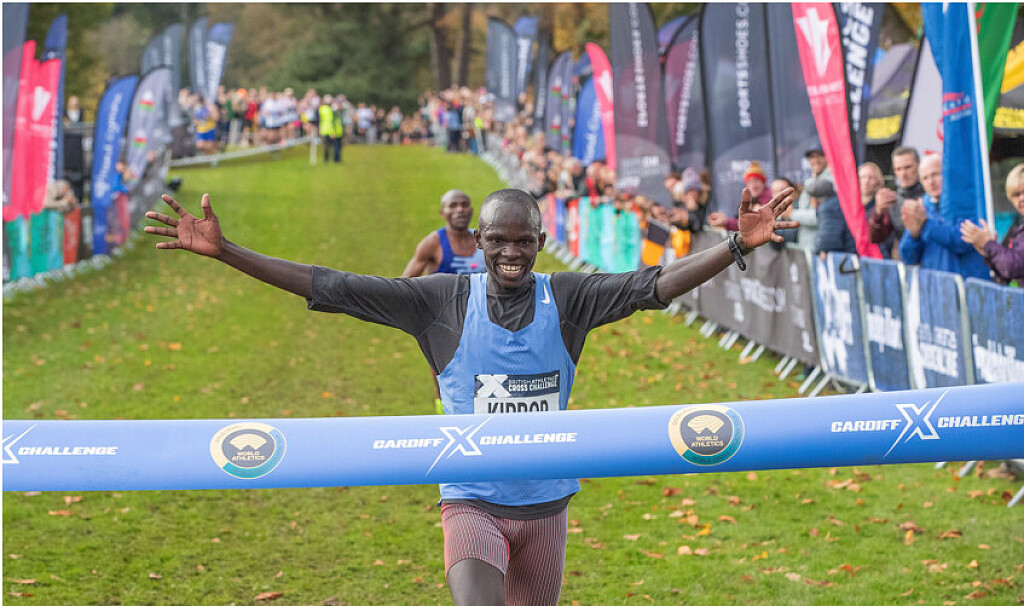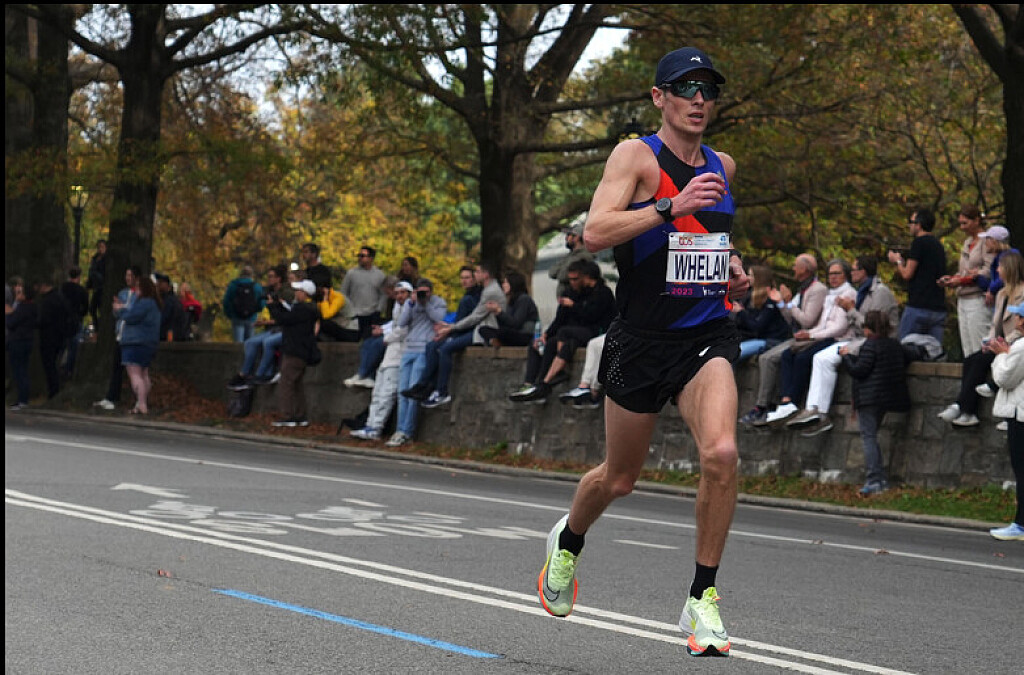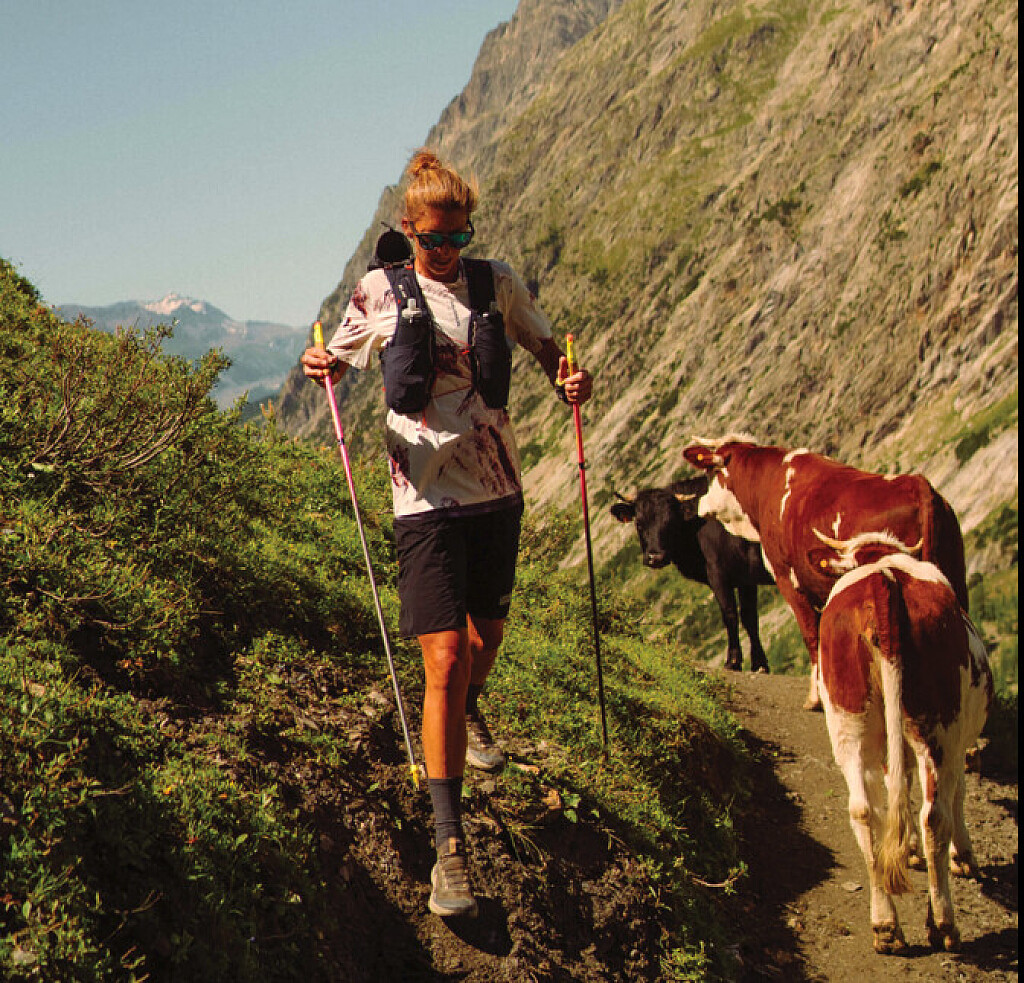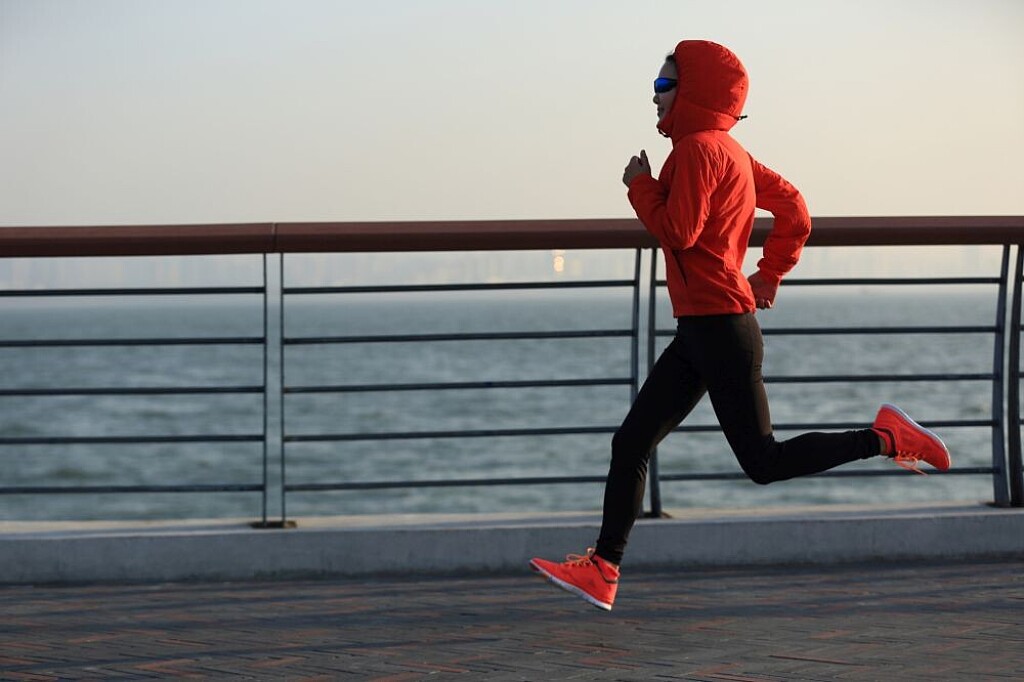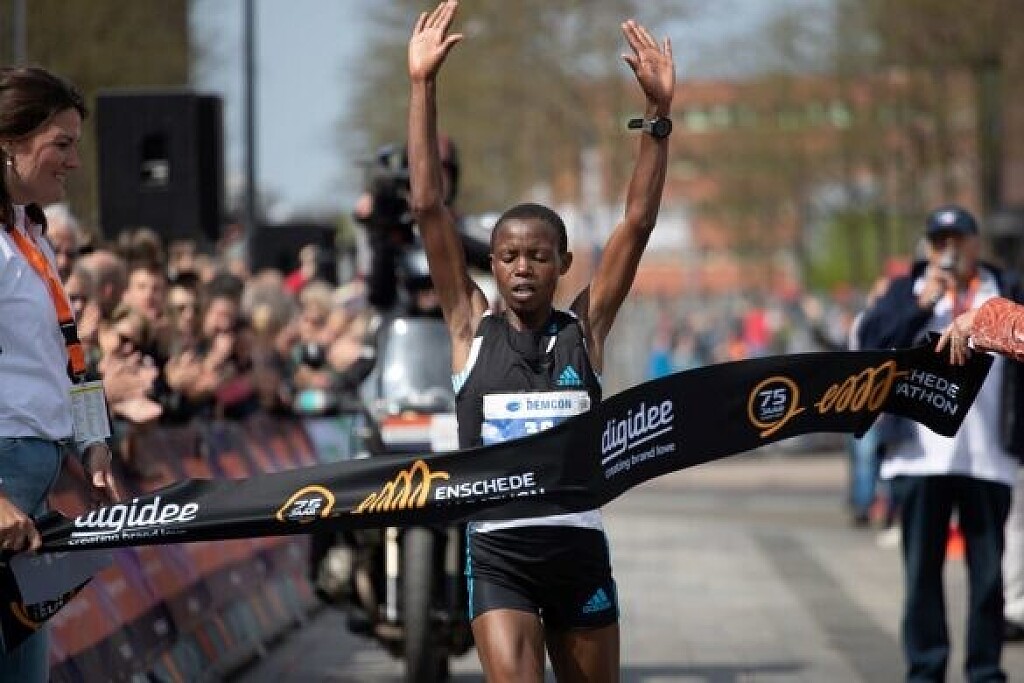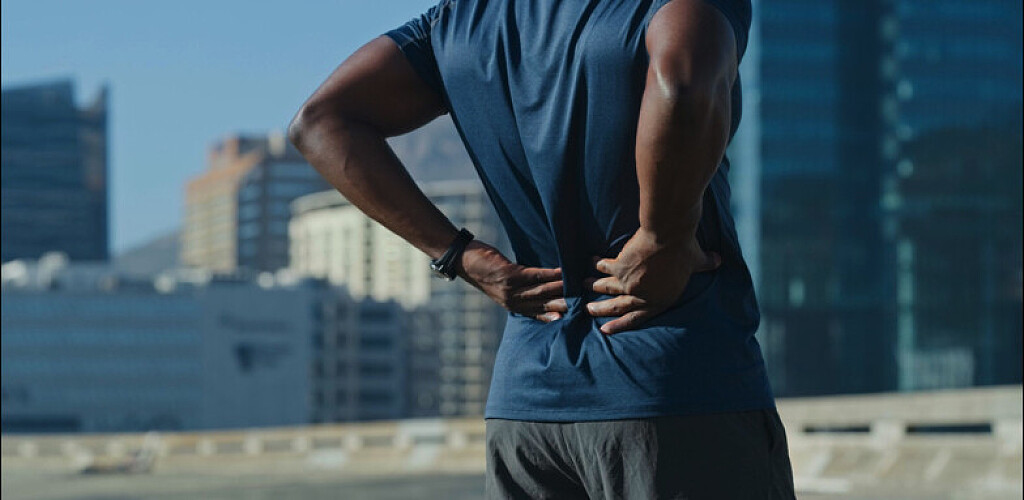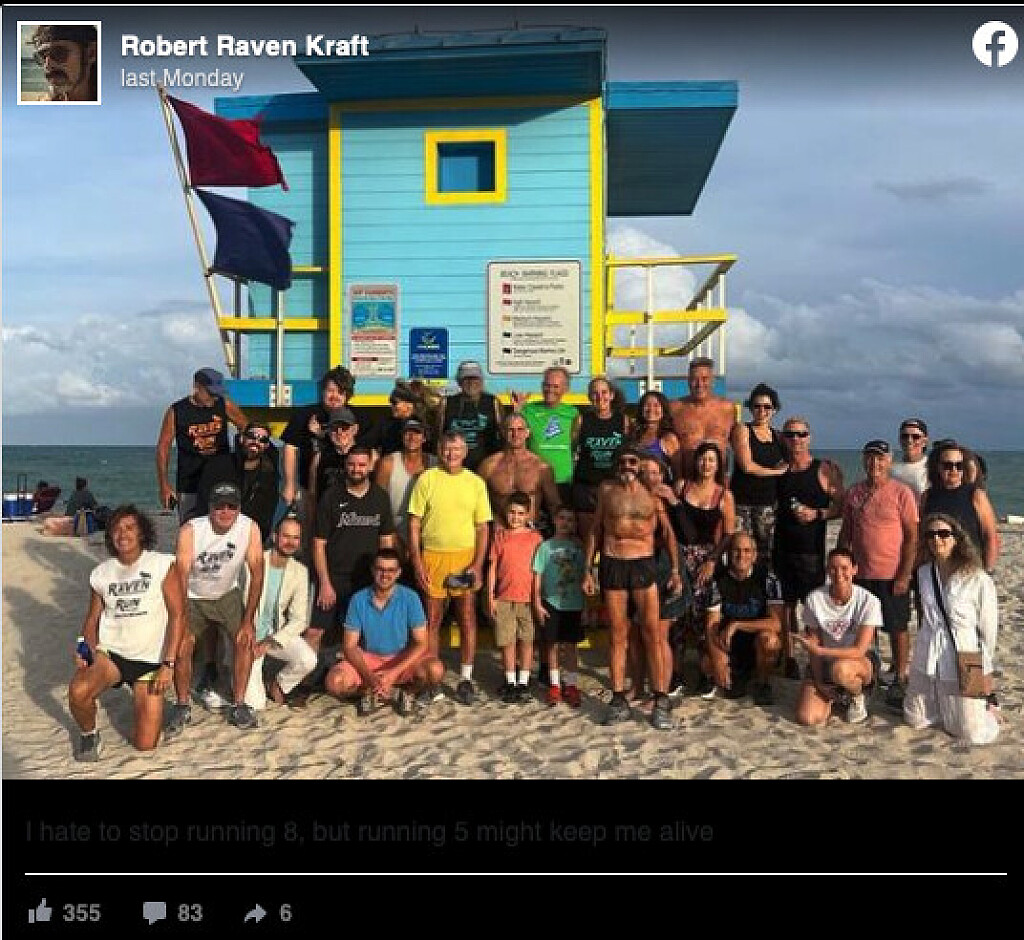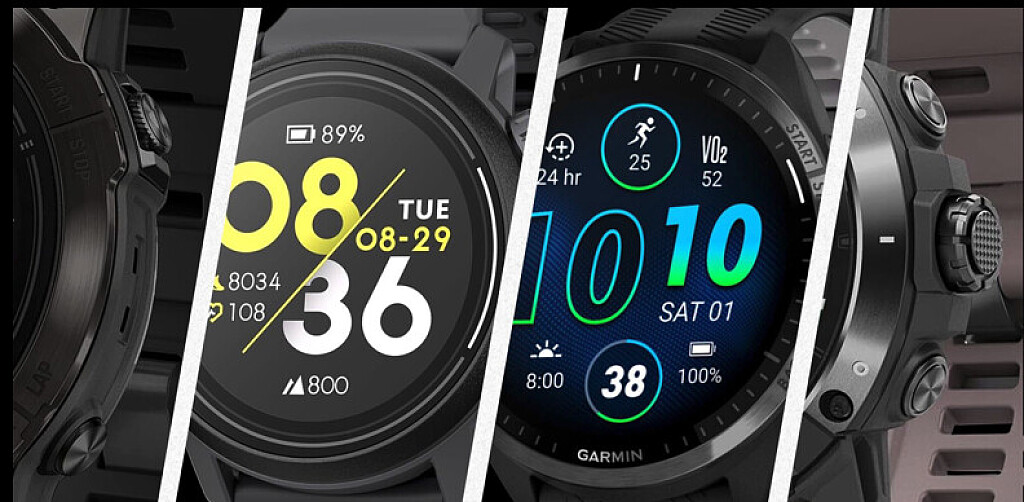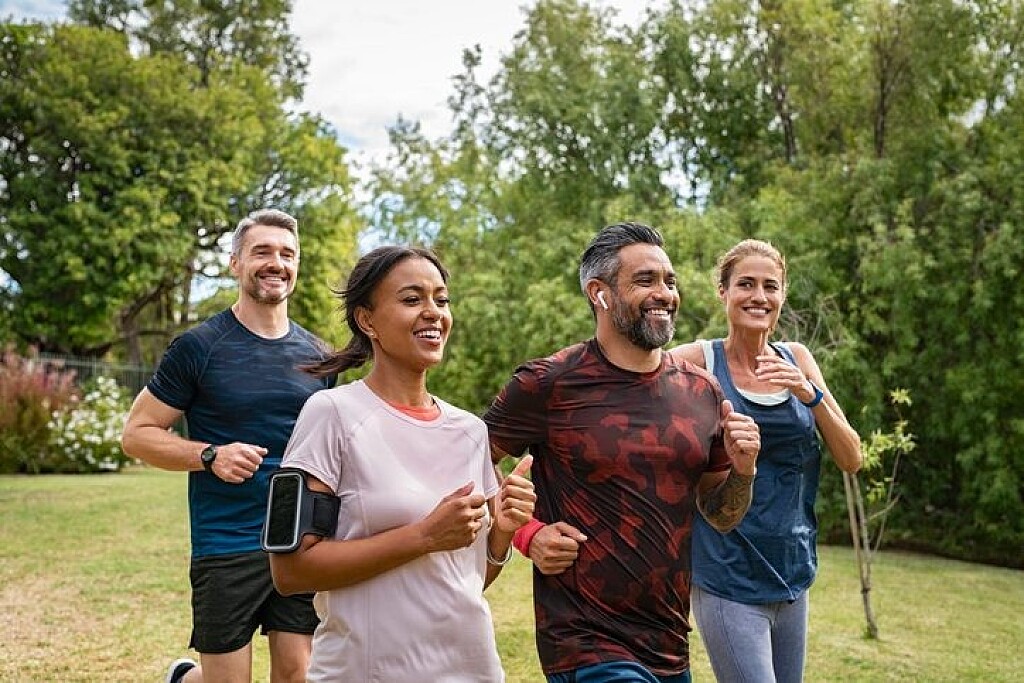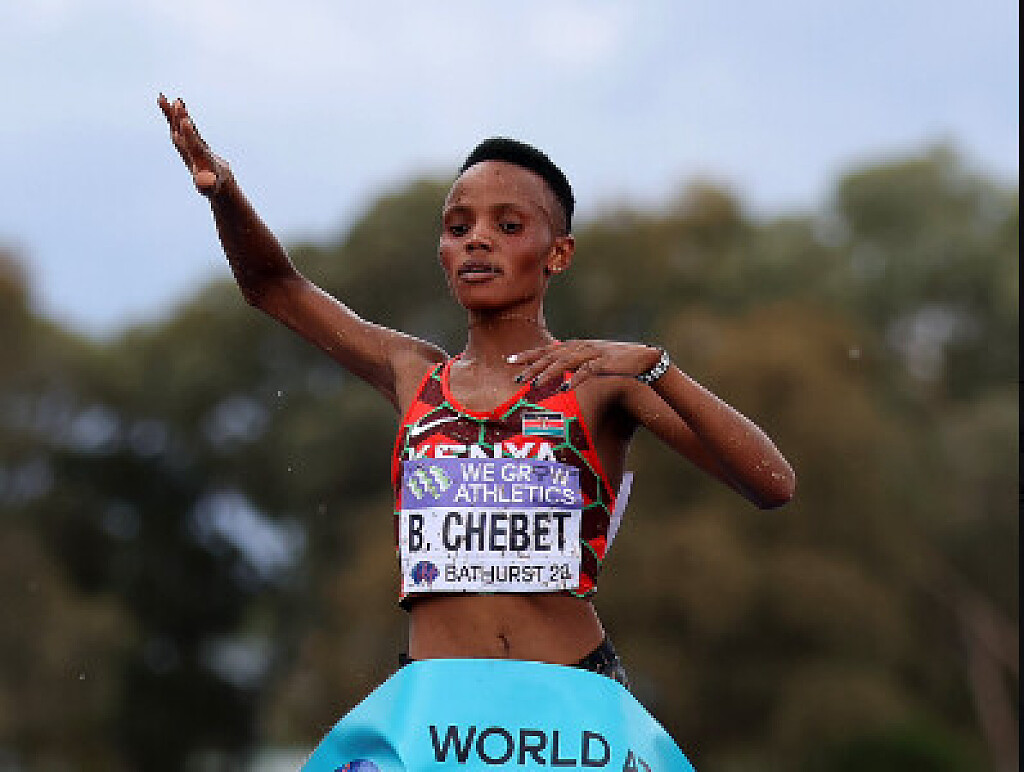Running News Daily
Running News Daily is edited by Bob Anderson in Los Altos California USA and team in Thika Kenya, La Piedad Mexico, Bend Oregon, Chandler Arizona and Monforte da Beira Portugal. Send your news items to bob@mybestruns.com Advertising opportunities available. Train the Kenyan Way at KATA Kenya. (Kenyan Athletics Training Academy) in Thika Kenya. KATA Portugal at Anderson Manor Retreat in central portugal. Learn more about Bob Anderson, MBR publisher and KATA director/owner, take a look at A Long Run the movie covering Bob's 50 race challenge.
Index to Daily Posts · Sign Up For Updates · Run The World Feed
Kenya’s Barnaba Kipkoech took the top honors at the 12th edition of the Kobe marathon
Barnaba Kipkoech took the top honors at the 12th edition of the Kobe marathon held on Sunday (19) in Kobe, Japan.
The 30 year-old who came to this race with the fastest time on paper of 2:08.21 that he got last year at the Malaga Marathon where he took the honors, live up to the race expectations as he cut the tape first in a time of 2:11.19 with the Reigning Oceania 10,000m champion, Tim Vincent of Australia who was making a debut over the distance, coming home in second place in a personal best of 2:12.05.

The 2019 Morocco’s 10,000m national champion, Hassan Toriss, who finished in twelfth place last year, made a great improvement this year, as he managed to be on the podium when he clocked 2:13.06 to wrap up the podium three finishes.
Last year’s thirteenth place finisher Ayoub Dardar of Morocco also made a significant improvement as he came home in fourth with Kenya’s Mathew Kibiwott finishing in fifth in respective time of 2:13.38 and 2:15.25.

The race course record of 2:08.46 set four years ago by Uganda’s double 5000m National Champion, Geofrey Kusuro remains standing.
(11/20/2023) ⚡AMPby John Vaselyne
Kobe Marathon
Do you know the first marathon competition in Japan was held here in Kobe? In other words, Kobe is the birthplace of marathon in Japan! The first marathon in Japan took place in 1909, in Meiji period. Since the 42.195 km standard distance had not been fixed yet, the race was approximately 32 km long. (By the way, the standard...
more...Jacob Kiplimo continued his return to racing with a stunning performance at the NN Zevenheuvelenloop
World cross-country champion Jacob Kiplimo continued his return to racing with a stunning performance at the NN Zevenheuvelenloop in Nijmegen on Sunday (19), equalling the world 15km best with 41:05.
The Ugandan was forced to miss the World Championships in Budapest and World Road Running Championships in Riga through injury, but returned to action at the end of last month with a convincing win at the Cross Country Tour Gold meeting in Atapuerca.
Today he notched up another victory, winning by 99 seconds to equal the world best set five years ago by his compatriot Joshua Cheptegei.

He started out at a relatively conservative pace, mindful of the fact there was a big climb to come between 3.5km and 5km. He reached 3km in 8:42 – 23 seconds down on Cheptegei’s pace from 2018 – and got to 5km in 14:24, by which point compatriot Rogers Kibet was already struggling to stay in touch.
Shortly after, Kiplimo was out in front alone and he passed through 8km in 22:31 with a 24-second leading margin. He hit the 10km checkpoint in 27:49, the exact same split Cheptegei recorded during his landmark run. From that point on, Kiplimo’s pace fluctuated slightly; sometimes ahead of course record pace, sometimes behind it.

A 2:31 final kilometer – his fastest of the race – brought him home in 41:05. Kibet held on to second place in 42:44, securing a Ugandan 1-2.
Although 41:05 is the fastest ever performance in a standalone 15km race, Kiplimo recorded a 15km split of 40:27 en route to his half marathon world record in Lisbon in 2021.
World steeplechase record-holder Beatrice Chepkoech was a convincing winner of the women’s race, crossing the line in 47:12 to finish 43 seconds ahead of Israel’s Lonah Salpeter.
(11/20/2023) ⚡AMPby World Athletics
The NN Zevenheuvelenloop
The NN Zevenheuvelenloop, also known as the nation's most beautiful and the world's fastest 15 kilometer race this year.The NN Zevenheuvelenloop has undergone a lot of development in the past 32 years.From a 'walk' with 500 men has grown into an event where almost 40,000 people register for it.This makes it the largest 15km race in the world and with...
more...Three winter running workouts to keep fitness at the max
These workouts will keep your fitness level high even if your mileage is low.
Many of us find it challenging to get out the door when the ground is covered in snow, or when the temperature dips so low we have to load up on layers. These workouts are short enough that your toes won’t get cold, but challenging enough to keep fitness at a max, even if your mileage is lower than usual.

1.- Surge sets
The short pace-pickups will keep your legs feeling peppy without overloading them.

Warm up with 10 minutes of easy running
Run pickup intervals (short, fast intervals), with each set of intervals at a slightly faster pace or effort: two x 90 seconds at 10K pace, with 90 seconds of recovery between each interval, four x 60 seconds at a slightly faster pace, with 60 seconds recovery between each interval, four x 30 seconds hard running with 30 seconds recovery between each interval, and finally four x 15 seconds at your hardest effort (with 15 seconds of recovery between each interval).
Cool down with 10 minutes of very easy running.
2.- 5-4-3-2-1
This fartlek-style countdown workout targets endurance and boosts your ability to run on tired legs.
Warm up with an easy 20-minute run, and then run harder intervals of five, four, three, two and one minute(s), each followed by a recovery jog of the same duration.
Cool down with 20 minutes at a steady pace to finish the session.
There’s no need to focus on hitting particular paces during your intervals in this one–simply focusing on progressively picking up the pace midrun will build fatigue resistance and improve your ability to focus midrun.
3.- One-to-one workout
This is a great simple workout, easy to tweak to make more or less challenging. Feel free to shorten your intervals to 30 seconds each, or, after you’ve mastered the one-to-one session, kick it up to two minutes on and off.
Warm up with 10 minutes of easy running.
Run one minute “on” at a faster pace, and one minute “off” at a recovery pace, repeat for 20 minutes.
Progressively increase the speed of the harder sections so that you’re running at 10K effort or pace by the end of the run.
Cool down with five-10 minutes of easy running.
Remember to follow a speed session with an easy running day or a rest day.
(11/20/2023) ⚡AMPby Keeley Milne
Heinz is Encouraging Runners to Start Fueling with Ketchup but is it a Bad Idea
The average marathoner would need to down over 60 packets to make it to the finish line.
We all have our favorite go-to gels and snacks to keep handy during a long run, but recently, one company has proposed turning to a different kind of packet to refuel during your runs—and you might have a drawer full of them in your kitchen.

Earlier this month, Heinz released an advertisement claiming that “Runners everywhere are using Heinz ketchup packets on their runs.” The ad announces new ketchup-themed running routes available on various running apps. The routes, shaped like the iconic bottle of the famed ketchup, will point out which restaurants in cities like Toronto, Chicago, and New York City carry packets of Heinz, just in case you need to restock during a run.
But is ketchup the best thing to power you through miles? New York-based nutritionist Amy Stephens would like to squash that idea.
“Ketchup packets are not an efficient fuel source for distance runners,” Stephens told Runner’s World. “Too much sodium and not enough carbs.” With just 10 calories and two grams of carbs per packet, Stephens notes that it would take a lot of ketchup to fuel the typical runner’s caloric needs. “Athletes need about 30 to 60 grams of carbs per hour during a long workout,” she says. “That’s 15 packets at a minimum per hour.”
But what about a marathon? The average marathon time, according to RunRepeat, is 4:32:49. That would mean the average runner would need to down at least 60 packets over the course of 26.2 to meet their nutritional needs. That’s a lot of tomato.
“I’ve used a couple [of packets] on a burger, but the thought of eating 60 for a marathon is not appealing,” Stephens said. She noted that while the packets still contain electrolytes like potassium, they don’t make up for the lack of carbohydrates.
Stephens says that while the ease of finding ketchup through running apps sounds appealing, the packets could be a gateway to other, less useful products for a run. “While Heinz promotes the ease of finding packets in fast food chains, you might stop in to grab some ketchup and end up with a burger or fries,” she said.
Additionally, the condiment could have an adverse effect on some runners.
“Ketchup can cause reflux, and many runners are particularly susceptible to GI issues,” Stephens said. “During a hard, sustained effort, the gut has a harder time digesting foods. That’s why gels and sports fuels are specifically designed to contain easily digestible sugars from glucose and fructose.” She added that she wasn’t sure how quickly the body can convert tomato puree and high fructose corn syrup into usable energy.
If you’re looking for alternatives to ketchup but still want to maintain a budget, Stephens recommends packets of honey for a quick boost of energy and, barring that, a quick handful of dates.
(11/19/2023) ⚡AMPby Runner’s World
One year later: the phenomenon of Uncle Chen and his chain-smoking marathon
It’s been a year since Canadian Running broke the story of Uncle Chen, who ran a 3:28 marathon while chain-smoking cigarettes. To celebrate the anniversary, here’s some behind-the-scenes information on how the story came about, the aftermath, and where Uncle Chen is now.
How it came about


Usually, come November to January in the running season, events and races in North America have slowed down, and as a writer, I am always looking for the next big story to entertain our readers. I saw that China had a few marathons in early November, so I decided to search for the word “marathon” in simplified Chinese on the popular social media app Weibo.
Within seconds, I saw a post of a man lighting a cigarette in the middle of the Xin’anjiang Marathon, gathering hundreds of comments and shares. At the time I thought it was funny, but I had no idea what would come of it. I had the same reaction as you (probably) when you first read the story. The concept of a runner smoking cigarettes during a marathon and running well is hilarious and incredible. I had to investigate.
I discovered it wasn’t the first time Uncle Chen had been lighting it up mid-marathon. I spent the day translating documents and results from simplified Chinese to English and found his name, previous photos and physical results of him smoking during races prior to the 2022 marathon. That’s when I knew we had something special on our hands.
The aftermath
When the story was published on Nov. 14, 2022, it began to make its rounds on Facebook and Twitter and within a day or two it was on every news site you could think of: Business Insider, Golf Digest, Barstool Sports, New York Post, Global News and more. I had several news agencies contacting me to speak to Uncle Chen, who seemed to be bothered by the popularity his stunt got in North America.
I reached out to Chen and his niece. Chen did not respond, and his niece sent us a message via translation that it was frowned upon to have this popularity in foreign media–that it was viewed in China as setting a bad example.
Within two weeks of the story being released, the Chinese Athletic Association (C.A.A) issued a proposal recommending that all Chinese marathons ban smoking. The proposal was put in place to promote healthy participation and to stop people from smoking at road-running events. The C.A.A. wrote that those who fail to comply with the competition rules should be disqualified.
Where is Uncle Chen now?
Uncle Chen has been flying under the radar since breaking the Internet last year, but to our knowledge, he is still very involved in his local running scene. Chen serves as the co-founder of the Zhejiang Xianju Road Running Association and the Zhejiang Provincial Marathon in his hometown of Taizhou City. According to Chinese media Nandu, Chen still loves to smoke and run, but it is his personal choice to do so.
Local media reportedly tried to contact Uncle Chen several times, but he has declined to chat about smoking or his marathons, hopes his fame will fade over time and did not want to delay things by speaking about his accomplishment.
(11/19/2023) ⚡AMPby Running Magazine
America’s Oldest Continuously-Held Ultramarathon Is Only Looking Forward
After 60 years, the JFK 50 Mile Race is sticking to its community-centered approach, and people keep showing up
Mike Spinnler cries nearly every time he recounts memories as a runner and long-time race director of the JFK 50, the oldest continuously run ultra in the country.


Such memories include the time he first ran the iconic Maryland race when he was 12 years old, or the year he cheered on his 60-year-old wife as she crossed the finish, or memories of watching his two sons racing. For him, this race is a member of the family.
In 1993, five years after his tenth JFK finish, Spinnler became the race’s second race director, where he’s been ever since. By then, he’d set the course record (5:53:05) in 1982, and added another win in 1983, for a total of five top-five and six top-ten finishes.
Thirty years later, it’s still his pride and joy. He’ll immerse in the magic of the event again on Saturday, November 18, as more than 1,000 runners take the journey through the historic route that’s so dear to his heart.
“It just keeps growing in its prestige,” he says.
The JFK 50 started in 1963, the same year President John F. Kennedy was assassinated. The president had instituted a public health program to improve the nation’s fitness, supporting the launch of a series of 50-mile races around the country. But as years went on, the only one that stuck around was the JFK 50.
“Kennedy’s mission was this: Improve your physical fitness, improve your lifestyle, improve your country,” says Spinnler. “We heeded his call and have been doing it for 60-plus years.”
The JFK 50 course is located about an hour northwest of Washington D.C., covering traditional lands of the Indigenous Massawomek and Shawandassee Tule (Shawanaki/Shawnee). One of the race’s primary appeals is that it’s a horseshoe-shaped, point-to-point course with three distinct sections: The Appalachian Trail (miles 0-15), the Canal/Tow Path (miles 15-42), and the rolling finish (miles 42-50).
The race starts in Boonsboro, Maryland, follows a few miles of paved roads before connecting with the Appalachian Trail (AT), where the course climbs more than 1,000 vertical feet in five miles, crests to the high point, and follows rocky singletrack before dropping 1,000 vertical feet halfway into the race (mile 14.5), to connect with a flat marathon distance along the C&O Canal Tow Path. The last several miles are rolling country roads, where it finishes at Springfield Middle School in Williamsport.
In 2019, Seth Ruhling, an unsponsored athlete, showed up to the JFK 50, slept in his car the night before, and won the race in a blistering 5:38:11, his debut 50-miler. Within hours of winning, he sealed a sponsorship with The North Face.
Ruhling, 29, now lives and trains in Boulder, Colorado, and he’ll be returning for his second JFK 50. Since Ruhling’s 2019 win, he has made a name for himself with a sixth place finish at the Pikes Peak Marathon in 2021, second place at Montana’s Rut 50K, first place at the Broken Arrow Skyrace 46K, and most recently, sixth at CCC 100K during the week of UTMB in Chamonix, France.
In 2020, JFK 50 was one of the only races in the country that didn’t shut down with the pandemic. Ruhling had planned on racing, but got injured. “I always wanted to go back,” he says.
Ruhling was particularly drawn into this year’s race because of its deep field of registered elites, which had at one point included 2023 Western States winner Tom Evans, Matt Daniels, Adam Merry, and Sean Van Horn—all of whom have since dropped.
His strategy for the mixed course, which requires technical trail chops as well as fast road turnover, is to attack every single section. He says that, while the JFK 50 is known more as a “track race,” it’s a mistake to discount the early trail miles. “The record is going to happen on the towpath, sure, but only if it’s set up with efficient running on the AT section,” he says.
(11/19/2023) ⚡AMPby Outside Online
The Fight Over the Olympic Trials Start Time Has Ended. But the Real Issue Runs Deeper.
Following significant athlete pushback, USA Track & Field moved the race’s start time earlier. But the governing body also needs to offer Trials host cities a better deal to prevent similar issues in the future.
It’s become a tradition of sorts that every Olympic Games needs to be preceded by stories of scandal and intrigue, so it’s perversely appropriate that the lead-up to the Olympic Team Trials marathon next February has been plagued with its own mini-fiasco.

It began this past summer, after it was announced that the 2024 U.S. Olympic Trials marathon would take place shortly after noon on February 3, 2024. Not everyone was thrilled with the late start as the Trials are happening in Orlando. For some, staging a competitive, high-stakes marathon in the middle of the day in Florida seemed like a blatant disregard for athlete health.
In September, nearly 100 Trials participants co-signed a letter from the Athletes Advisory Committee to USA Track & Field leadership requesting that the race start time be moved to 6 or 7 A.M. to protect the participants from potential heat-related illness and injury. Following a private meeting with USATF CEO Max Siegel, the Athlete Advisory Committee was initially optimistic that the start times would be changed. However, two weeks ago, the Committee publicly reprimanded the Greater Orlando Sports Commission (GO Sports), the local organization responsible for putting on the Trials race. In a letter that was shared with the public, Trials athletes expressed their chagrin that while USATF and their television partners at NBC seemed amenable to an earlier start time of 10 A.M., GO Sports was refusing to budge on a noon start, unless they were compensated to the tune of $700,000.
“It is difficult to find words capable of expressing how angry and disappointed the athletes are to hear the ultimate hurdle they face is with the Greater Orlando Sports Commission,” the letter from the athletes read. In response, the owners of Track Shack, an Orlando-based running specialty store and event management company that is co-hosting the Trials, published an open letter of their own in which they maintained that they had been unfairly “blindsided” by the eleventh-hour request to move up the start time. The local organizers had repeatedly been told by USATF that a noon start was “non-negotiable,” largely due to the economic incentives of having a live TV broadcast of the race at a desirable time slot, and had developed their business model accordingly. This week, however, USATF announced that all parties had agreed on a 10 A.M. start after all. So much for non-negotiable.
As far as scandals go, an argument over the appropriate start time of a 26.2-mile road race isn’t exactly edge-of-your-seat type stuff. When I spoke to Rich Kenah, the CEO of the Atlanta Track Club and race director for the last Olympic Trials race, he told me that while “any opportunity for our sport to be ‘above the fold’ so to speak, tends to be good, when the challenges of our business are front and center, I think it has a detrimental effect on future opportunities for the sport to grow and flourish.”
Kenah is cautious not to make too much out of the start time debacle. He says that there’s almost always some sticking point when a local organizing committee has to coordinate with USATF in a way that satisfies the needs of their Olympic and broadcast partners. For Kenah, the larger issue, and the root cause of these more minor friction points, is a Trials business model that always puts the entire financial burden on the host.
For anyone who wants a detailed analysis of why that model is not sustainable, I’d recommend Jonathan Gault’s extensive report, published last year on Letsrun.com. In brief, the problem of the current Trials model is that it appears to mimic, albeit on a vastly smaller scale, the parasitic behavior of the International Olympic Committee, which takes in billions in sponsor and television revenue, while the host city is left to bankroll the lion’s share of the Games. While the cost of hosting the Olympic Trials might “only” be around two or three million dollars, that’s a hefty price tag for a running events company like the ATC, which has few viable ways to generate revenue from the event. (The local organizer cannot secure sponsorship agreements that threaten the exclusivity of USATF and USOPC partners, which leaves them with limited options.) In addition to being on the hook for all the operational and logistical costs of staging a world-class marathon, the local organizing committee is required to pick up the bill for stuff that, one would think, could be at least partially subsidized by USATF—like athlete prize money (at more than $500,000, this is one of the larger costs of staging the event) and event promotion ($75,000 minimum). As a final insult to injury, the Trials host needs to pay USATF a $100,000 rights fee.
With both the Olympic Games and the marathon Trials, prospective hosts are of course promised that staging the event will be a boon for the local economy. (The “Request for Proposal” guidebook for the 2024 Trials estimates that the “economic impact” of the event is around $20 million for the host city.) Arguably the bigger selling point is the sheer prestige of being associated with the Olympic brand. Hosting a Trials race can potentially elevate the profile of a city’s signature marathon.
Prestige, however, is a fickle thing. It’s no secret that the chorus of pushback against the Olympics has only grown louder in recent years, as more and more prospective host cities have retracted their bids. The Trials race—frequently touted as America’s greatest marathon—seems to be in danger of a similar fate. Only two cities were ever cited as showing any interest in hosting the 2024 edition; after Chattanooga was disqualified in another mini-scandal that is still playing out, Orlando seemed to be the winner by default. This does not bode particularly well for the future.
When it comes to fixing the Olympics, one idea that is frequently proposed is to give the Games a permanent home, or to rotate it between just a few cities; the idea is that this could help reduce costs by having a pre-set infrastructure already in place. What’s more, it could eliminate the rigmarole of the bidding process. Could something similar be the salvation for the U.S. Trials marathon? At the very least, having the race in the same location each time would allow the host to fine-tune their event with each iteration-—a win for the athletes. For better or worse, we already have a de facto permanent home for the Olympic Trials in track and field, which next summer will be staged in Eugene for the fifth consecutive time.
Brant Kotch, the former race director of the Houston Marathon who oversaw the city’s hosting of the Olympic Trials in 2012, told me that when his team tried to host the event again in 2016, part of their pitch was that they wanted to “make Houston the Eugene of long-distance road racing.” When Houston hosted in 2012, the event was a massive success; they had perfect weather and big-time performances from the stars of the sport. And, thanks largely to a million dollar grant from the state of Texas to help subsidize large-scale sporting events, they were able to host the race without taking too much of a financial hit. According to Kotch, Houston had a solid bid to host the 2016 Trials (one that was apparently unanimously approved by USATF’s Long Distance Running Division), but USATF’s leadership ultimately decided to give the race to Los Angeles. When we spoke, Kotch still sounded slightly bitter about being passed over.
Houston hasn’t tried to host the race again. There are some logistical reasons for this—for one, massive downtown construction projects in the intervening years have made the 2012 course obsolete—but economics are a significant factor. As someone open to the idea of a permanent home for the Trials, Kotch says that the only way that this will work, long-term, is for the sport’s national governing body to help subsidize the race: “With respect to its Olympic Trials, USATF has to pony up some amount of money. This is distance running. You can’t sell any tickets.”
Kenah agrees. He thinks that it would be in everyone’s best interest if USATF would incite competition between prospective host cities by promising some kind of revenue share system from one of its marquee events. (USATF did not respond to a request for comment on the suggestion that it should shoulder more of the cost to host the Trials.)
“Right now, you cannot make money hosting the Olympic Trials marathon,” Kenah told me. “I don’t care who you are or where you are, it’s just not possible with the current model.”
When I floated the idea of hosting the Olympic Trials marathon in the same place every Olympic cycle, Kenah told me that he was still very much in favor of moving the event to different cities. He mentioned that his father took him to see the Millrose Games in New York City when he was a kid. There was a distinct physical thrill to witnessing professional track and field up close that made him fall in love with the sport for life. (Kenah made the U.S. Olympic Team in 2000 and ran the 800-meters at the Sydney Olympics.)
“There is nothing better than experiencing the sport in person,” Kenah says. “If we had an Olympic Trials marathon in cities around the country, big and small, we would expose the sport in a very real, experiential way that otherwise kids of the next generation would not get. But that can be only accomplished if the current business model is just blown up.”
(11/19/2023) ⚡AMPby Outside Online
World championship silver medalist suspended 30 months for evading doping test
Jamaican 400m runner and 2022 world championship silver medalist Christopher Taylor has been slapped with a 30-month suspension by the Athletics Integrity Unit (AIU) after evading an out-of-competition doping test without justification in November 2022.
After a comprehensive six-month investigation, the AIU found that Taylor violated Article 2.3 of the World Anti-Doping Agency’s (WADA) Anti-Doping Code, deeming his actions as “evading, refusing, or failing to submit to sample collection.” In November 2022, anti-doping officials attempted to conduct an out-of-competition doping test at the location Taylor had specified on his whereabouts form, but he was not present at the location and had not updated his whereabouts information.

According to the Jamaica Observer, Taylor was at the Norman Manley International Airport in Kingston when the officials arrived at his home, waiting to catch a flight to the U.S.
If an athlete is not where they say they are when anti-doping officials show up, it counts as a missed test. Typically, a first or second offense does not carry any penalty, but if an athlete misses three tests during a 12-month period, that constitutes a whereabouts violation, resulting in an automatic period of ineligibility.

Taylor was a finalist in the men’s 400m at the Tokyo Olympics and the 2022 World Championships in Eugene, Ore. He also helped the Jamaican men’s 4x400m relay team win silver at 2022 Worlds.
Twelve of the 30 months of his suspension have already elapsed; Taylor will become eligible to compete again in May 2025. His last competitive race was in August 2022.
(11/18/2023) ⚡AMPby Marley Dickinson
Barnabas Kiptum eyeing grand return at Abu Dhabi Marathon after disappointment in 2021
Barnabas Kiptum will be seeking redemption as he returns to the Abu Dhabi Marathon scheduled for December 16.
Barnabas Kiptum will be out to finish what he started when he heads to the ADNOC Abu Dhabi Marathon scheduled for Sunday, December 16.
The 36-year-old was in action during the 2021 edition of the race but unfortunately failed to finish after some challenges and he will be keen to rewrite the script when he takes on the tough opponents.

Kiptum has had a soft 2023 season, competing in one race, the New Taipei City Wan Jin Shi Marathon, and winning it. He will be hunting for his second win when he takes on the tough opponents.
He lines up as the fastest in the field with a Personal Best time of 2:04:17 and he will be banking on past experience to outshine his challengers.
The race has also attracted Uganda’s Andrew Kwemoi, also an able athlete. The Ugandan has enjoyed a great season too that saw him clinch the Miano Marathon title earlier this year.

He was also in action at the World Championships in Budapest, Hungary but failed to finish the race. However, he will use the experience from the global stage to vie for a podium finish as he competes in the marathon in the streets of Abu Dhabi for the first time.
Another athlete to watch will be Kiptum’s compatriot, Leonard Barsoton. He lines up as the third-fastest in the field with a PB time of 2:09:06 and he will be looking to outshine his opponents too.
Meanwhile, the women’s field will also bring up a huge challenge having assembled very strong women. Ethiopia’s Tirunesh Dibaba leads the charge with a PB time of 2:17:56.
The Ethiopian will be running her first marathon this year, after coming out of her maternity leave. She took a break in 2018 and has come back into competitive running this season.
She will be challenged by Kenya’s Maureen Chepkemoi who will be running her fourth marathon this season. Another one to watch will be Ethiopia’s Hawi Feysa who has enjoyed a great 2023 season and will be keen to extend her winning streak in Abu Dhabi.
(11/18/2023) ⚡AMPby Abigael Wuafula
ADNOC Abu Dhabi Marathon
The Abu Dhabi Marathon is shaping up to being first class marathon for both elite runners and average runners as well. Take in the finest aspects of Abu Dhabi's heritage, modern landmarks and the waters of the Arabian Gulf, at this world-class athletics event, set against the backdrop of the Capital's stunning architecture.The race offered runners of all abilities the...
more...How Long Do Super Shoes Last? Here’s What the Latest Data Says.
Fancy new midsole materials like PEBA make you faster, but at the cost of durability
The eternal question of how long your running shoes should last became suddenly topical a few months ago, when Tigst Assefa set a world marathon record in what Adidas billed as essentially a single-use marathon shoe. This development sparked some important discussions about sustainability, accessibility, and fairness. But it also served as a reminder of how little we actually know about the useful life of running shoes, especially in the new era of thick-foamed super shoes.

Fortunately, there’s some interesting new data in a study from researchers in Spain, led by Victor Rodrigo-Carranza of the University of Castilla-La Mancha. In the Scandinavian Journal of Medicine and Science in Sports, they compare shoes made with a modern super foam to a traditional EVA midsole before and after 280 miles, and find that the new midsole does indeed lose its magic more quickly—so much so, in fact, that the super shoe is no better than the regular shoe at that point.
Before digging into the specifics of the new study, it’s worth sketching in some context. The conventional wisdom that I’ve heard throughout my running life is that shoes typically last somewhere between 300 and 500 miles. This is based on some mix of cumulative experience and imperfect data, some of it published and some presumably locked away in shoe-company filing cabinets.
For example, there’s a 1985 study that measured shock absorption at frequent intervals between 0 and 500 miles, using a machine to simulate the impacts of running as well as two volunteers who racked up 500 real-life miles. Here’s an example of how shock absorption changed with mileage for one particular shoe:
The machine version of running obviously didn’t replicate the demands of in-person running very well, but the two human volunteers show similar patterns. Overall, the human testing found that shoes retained about 80 percent of the shock absorption after 150 miles, and 70 percent after 500 miles. You can see that the curve flattens out between about 300 and 500 miles, which is presumably where the conventional wisdom on shoe lifespan comes from. Conversely, you could argue that once you’re past 300 miles, the shock absorption isn’t going to drop much further, so if you’ve made it that far you might as well keep running in them until they (or you) fall apart. More on that below.
You might wonder whether shock absorption, as measured by a hydraulic machine, is really what matters to runners. More recent research has looked at other metrics: this 2020 study, for instance, used force-sensing insoles to measure the peak pressure on different parts of the foot, testing how it changed as a New Balance 738 shoe went from new, to 215 miles, to 430 miles. As the image below shows, the highest pressures are seen in the midfoot and forefoot:
Those pressures stayed virtually unchanged after 430 miles—but the midfoot peak pressure increased from 388 to 450 to 590 kilopascals, a 50 percent jump. It’s not clear exactly why the midfoot pressure increases. It could be that the relative lack of cushioning in the midfoot makes it less durable; it could be that the higher pressures on the rearfoot and forefoot break down the cushioning in those regions and shift load to the midfoot. Either way, it’s clear that the objective load on the foot has changed after 430 miles. And interestingly, the perceived cushioning reported by the volunteers picked up this change: those who reported feeling less cushioned in the midfoot in the worn shoes did indeed tend to have the highest peak midfoot pressures.
So the overall picture in the pre-super-shoe era was fairly muddy, but basically supported the view that shoes progressively lose their cushioning and reach bottom somewhere in that 300 to 500 mile range. Then came Nike’s Vaporfly in 2017, using a carbon fiber plate and a thick layer of cushioning to promise better running economy in exchange for a few hundred bucks—and, in the footnotes, less durability. The unsourced number that I frequently heard floating around after the Vaporfly’s release was that you should trust them for 100 miles or so.
It’s worth pausing here to say a few words about running shoe foams. Carlos Sánchez at RunRepeat has an impressive and exhaustive primer on the huge range of high-performance foams now on the market, which is worth digging into if you’re interested. A highly simplified history is that most running shoes used to use EVA (ethylene-vinyl acetate), then in 2013 Adidas’s Boost made TPU (thermoplastic polyurethane) popular, and then in 2017 Nike’s Vaporfly made PEBA (polyether block amide) the state-of-the-art. One study found that energy return was 66 percent for EVA, 76 percent for TPU, and 87 percent for PEBA.
While there’s been plenty of chatter about carbon-fiber plates, the weight of evidence is increasingly that most of the magic in super shoes comes from the foams. Unfortunately, the very property that makes them so good—their ethereal lightness—also makes them less durable. Of the more than three-dozen modern foams that Sánchez reviews, the main differences arise from the tweaks manufacturers make to trade off performance and longevity (along with price, of course). That makes it hard to issue general guidance about how long super shoes last: it depends on the shoe and the foam.
Still, one data point is better than zero, which brings us back to Rodrigo-Carranza’s study. The shoes he used were special prototypes manufactured for the study by On, almost identical except that one set had an EVA midsole while the other had a PEBA midsole. Both versions had a curved carbon-fiber plate. Twenty-two volunteers performed a running economy test to measure how much energy they burned at a given pace, once in fresh shoes and once in pre-worn shoes. (The researchers themselves ran exactly 280 miles in each pair of shoes to pre-wear them.)
One key finding: energy consumption in the new PEBA shoe was 1.8 percent lower than in the new EVA shoe. That bolsters the case that the foam itself is a big part of the magic, since both shoes had carbon fiber plates. (Not all PEBA foams are created equal, so we don’t know if On’s foam is as good as Nike’s ZoomX.) The other key finding: after 280 miles, there was no significant difference between the two shoes. The EVA shoe didn’t lose anything at all, whereas the PEBA shoe got 2.2 percent worse.
It’s not worth making any grand extrapolations from a single datapoint about when one type of shoe gets better than the other. Who knows what happens after 280 miles? For that matter, who knows what happened after 26 miles? Moreover, there are lots of other factors that might be relevant. One of the interesting claims in Sánchez’s review is that super foams maintain their properties even in frigid winter conditions, while EVA-based foams get much more rigid. In some shoes, firmness more than doubled after Sánchez’s freezer test. Maybe a worn-out super shoe is still a better bet than a newer EVA shoe for those of us who are latitudinally challenged. He also notes that shoe foams take more than 24 hours to recover from a run, and some recover faster than others, so it makes sense to alternate different pairs in order to maximize both comfort and shoe lifetime.
My own approach to shoe durability is, admittedly, not one that’s easy to generalize. I generally have two or three pairs on the go at any given time, and I run in them until they start to feel flat. It’s a noticeable sensation, especially if one of the other pairs in my rotation is relatively new and bouncy. Then, in the spirit of that graph above showing a plateau after about 300 miles, I keep running in them—but I pay more attention to how I feel during and after runs, and to whether the wear on the outer sole is changing the angle of my footstrike. Once I start to feel a few aches and pains, I retire the flat shoe. That approach works pretty well to keep me healthy, but the new data suggests that it’s probably not maximizing my performance. Anyone want to buy a pair of gently used six-year-old OG Vaporflys?
(11/18/2023) ⚡AMPResearch Compares Running Therapy to Depression Medication With Promising Results
The study author explains the major benefits of running for your mental health.
In a study that compares running therapy to antidepressants, researchers found that 16 weeks of a running program can offer similar benefits to these medications.


The running intervention involved expert guidance from trained therapists, as it can be harder to keep consistent.
Experts explain that several factors go into depression treatment—and medication is a crucial part of that—but lifestyle factors may also play a key role.
For better depression management, research has often suggested exercise as a way to ease symptoms and optimize therapeutic approaches—for example, one study notes that exercise may improve how you respond to antidepressants. But a recent study, published in the Journal of Affective Disorders, stacks exercise like running directly up against medications to see which is more effective.
Turns out, they have similar benefits, but running led to other physical health improvements while antidepressants had the opposite effect.
Researchers recruited 141 patients with diagnosed depression and/or anxiety and offered them the choice of either selective serotonin reuptake inhibitors (SSRIs), an antidepressant medication, or group-based running therapy for 16 weeks—45 chose medication while 96 selected running.
The running group exercised in a therapeutic setting at least twice a week, guided by mental health practitioners who were trained as running therapists. While these experts didn’t offer direct talk therapy, they did offer guidance on things like connecting to the body and physical boundaries. At the beginning of the program, the experts also discussed past experience with exercise and shared information on things like food, fatigue, injuries, sleep, and recovery.
The running sessions lasted 45 minutes, including a 10-minute warmup, 30 minutes of jogging, and a five-minute cooldown. Each participant wore a heart rate monitor and the goal was to jog at an intensity of 50 to 70 percent of heart rate reserve for the first four weeks, and 70 to 85 percent in the final 12 weeks.
At the end of the trial, around 44 percent in both groups showed improvement in depression and anxiety, but only those in the running group had additional benefits in terms of better blood pressure, heart function, and waist circumference. Those in the antidepressant group showed slight deterioration in these metabolic markers.
“The most important takeaway is that we showed running therapy and antidepressant medication are equally effective in treating depression and anxiety disorders when looking at mental health outcomes, including remission and response rates,” said lead researcher Josine Verhoeven, Ph.D., researcher in the department of psychiatry at Vrije University in Amsterdam.
Verhoeven said the exercise itself likely led to the favorable outcomes for those in the running group, but also factors like being outside, getting exposed to daylight, and setting and reaching goals also likely helped to enhance the mental benefits.
“When looking at somatic health outcomes [those relating to the body], running therapy outperformed antidepressant medication, as it had several beneficial effects for somatic health, while antidepressant medication’s side effects actually decreased somatic health variables,” Verhoeven added.
That’s because antidepressants have known side effects that include weight gain, increased blood pressure, and decrease heart rate variability, she told Runner’s World.
Despite the findings of this recent study, this shouldn’t cause people who need antidepressants to veer away from medication, which can be very helpful in treating certain forms of depression, said Lindsey Law, M.D., psychiatrist at Colorado-based Prairie Health. She told Runner’s World that many factors go into diagnosis and treatment of depression, including the role of lifestyle behaviors and the use of medication.
Also, if you’re currently on antidepressants and want to try easing off that medication with a strategy like exercise, definitely check in with your healthcare provider because you need to reduce those meds gradually rather than stop them suddenly, according to Law.
In general, doing more exercise like running can be an effective complement to depression therapy, but it’s important to tailor your approach based on your individual situation—and to get guidance from health professionals along the way.
“One interesting aspect of our research was that most patients chose running as an intervention, but many found it difficult to complete the 16 weeks,” said Verhoeven. “I think this shows how difficult it is to change behavior and that’s true for everyone, but especially when depressed. That’s why we’re now offering running therapy for patients with depression, so they have personal guidance when trying this intervention.”
(11/18/2023) ⚡AMP6 Nutrition Podcasts to Help Fuel Your Next Run or Race
Nutrition can be the toughest part of training for many runners. These podcasts offer advice you can listen to on the run.
If you’re the type who likes to listen to podcasts on your runs (or while working or performing everyday tasks), you’ve probably turned to a running podcast or two. These days, you can find podcasts that cover the sport from a range of views, including interviews with pro athletes, everyday runners, or experts dishing out advice, making it hard to narrow down your selection.

Health and wellness, specifically nutrition is no exception, as virtually every running podcast out there will touch on it in some form or another. Nutrition advice can be key to training, though, as it’s often an overlooked aspect that can help you get to the start and finish line of a race with energy.
Here, we’ve rounded up six nutrition podcasts that not only offer fueling advice for runners, but provide the info in an entertaining and easy-to-understand format.
1. If you’re looking for specific, expert-backed fueling advice...
Eat for Endurance
The Eat for Endurance podcast is not only hosted by a board-certified sports dietitian, but registered dietitians also make up the majority of the show’s guest list. Host Claire Shorenstein covers how athletes can fuel themselves for longevity in their chosen sport both by interviewing fellow experts, profiling high-performing athletes, and imparting relevant advice in solo episodes.
The show covers everything from fueling for road races, triathlons, and ultra distances to navigating peri- and post-menopause.
2. If you’re looking for nutrition advice geared toward women...
Female Athlete Nutrition
Hosted by sports dietitian Lindsey Elizabeth Cortes, whose clients include NCAA, professional, and recreational athletes, Female Athlete Nutrition caters to the needs of female athletes, as the name of the show implies.
Because nutrition needs for male and female athletes can vary drastically, especially if a female athlete has dealt with issues like low iron or an eating disorder, it can often be a game-changer for female runners to turn to an expert who is well-versed in those needs. The podcast covers all aspects of fueling for performance, as well as how things like body image and mindset can come into play.
3. If you want more entertainment with your nutrition tips...
The Run Eat Sleep Show
It’s safe to say content creator and influencer Tommie Runz has his nutrition down pat, having brought his marathon PR down to 2:46 at this year’s Boston Marathon from his first marathon, which he clocked in 3:13:30 in 2019 and after only starting to run in 2018, a year after getting sober.
As the name of his podcast implies, eating habits are a core aspect of any runner’s progress. In addition to being very open about his vegan lifestyle, he frequently interviews experts like registered dietitians in addition to professional athletes about their fueling.
4. If you want solid nutrition advice, as well as other topics...
The Running Explained Podcast
The Running Explained Podcast, hosted by RRCA Level 1-, UESCA-, and USATF Level 1-certified coach Elisabeth Scott, covers a wide variety of info about a healthy running lifestyle for athletes of all abilities and training levels. This includes nutrition—from how to fuel your overall training to preventing bone injuries—with advice coming straight from experts like registered dietitians and physical therapists.
5. If you want to focus on injury prevention...
The Injured Athletes Club
The “injured athletes club” is a club no runner wants to be a part of, but one nearly every runner can relate to at some point in their journey. This show, hosted by health and fitness journalist (and Runner’s World contributor) Cindy Kuzma and mental performance consultant Carrie Jackson, covers resources and personal stories from athletes on how to physically and mentally navigate and overcome injuries. But they also answer athlete questions and interview relevant experts to cover related topics, including how one’s nutrition can play into their injury prevention.
6. If you want a longer wellness deep dive...
The Rich Roll Podcast
With most episodes lasting around two hours long, it’s safe to say Rich Roll’s show dives deep into the wellness topic at hand, which frequently includes nutrition.
Roll, a vegan ultra-endurance athlete in his own right, knows a thing or two about sports nutrition himself, but his show serves as an extended opportunity for experts and fellow athletes alike to educate and inspire listeners through their perspectives on health and wellness topics, including nutrition.
(11/18/2023) ⚡AMPby Runner’s World
Shorter Days Often Equals More Night Running—Here’s How to Do It Safely and Successfully
Dial in your nutrition, gear, and more with this expert-approved advice. With the sun setting earlier and the shortest day of the year quickly approaching, there’s not much time left after work to get in a run. To make matters more complicated, if you’re not a morning runner or have too many pressing responsibilities first thing in the day, you might be left with little to no light at the end of the day to squeeze in some miles.
In fact, many runners opt to take their workout inside on the treadmill this time of year, and that’s understandable. In a recent Runner’s World Instagram survey of 5,200 runners, 38 percent of runners avoid running outside if it’s dark because of safety concerns or the risk of injury.


However, with the right preparation and gear, you can still get in those miles after work. And with this advice from seasoned run experts who frequently run at night and in the dark, along with a dietitian, we have all the info you need on how to make night running enjoyable, safe, and effective.5 Tips to Make Night Running Successful
1. Start With the Right Gear
Perhaps most important to successfully running at night is having the gear for it. Much like you wouldn’t go out on the hottest day without sunglasses, sunscreen, and extra hydration, there’s important gear to make night running more comfortable and safe.
“The most important thing is to be seen—any kind of light or reflective gear is useful,” says USATF level II coach, Jamie Brusa who has been leading a weekly Tuesday evening run in Bozeman, Montana since 2017.
Brusa prefers running with a lighted belt around the waist, like the Ultraspire LED waist light, and recommends to wear a headlamp so you can see (and it helps others spot you too), Brusa tells Runner’s World.
Ewen North, director and head coach of Revolution Running who leads an evening run group in Boulder, Colorado echoes the importance of gear that makes you visible and suggests a lighted vest that illuminates around the chest and back. North also suggests looking for reflective gloves—the more points you can have visible, the better, he says.Keep in mind that you could be more prone to slippery conditions like black ice when running at night, because it’s colder this time of year and obviously more difficult to see in the dark. For that reason, it’s smart to opt for a trail shoe for added grip in snowy or icy conditions. If you’re dealing with potential ice though, North recommends hobnails, which are short nails attached into the soles of shoes that increase the traction of the shoe. North also recommends the brands La Sportiva and Icebug for trail shoes.
“I use ⅜-inch flat head sheet metal screws and just drill them into the bottom of the shoes,” says Rachel Topf, UESCA Certified ultrarunning coach at The Mountain Project in Bozeman, Montana, who has always studded her shoes herself to easily adapt them for different terrain.
2. Plan Out Your NutritionYour fueling may change a bit if you’re getting your miles in at night as opposed to first thing in the morning. To make sure you’re fueled for your night run, without getting an upset stomach, pay closer attention to what you’re eating during the day.
“Eating enough at lunch time is essential for evening runners’ energy, blood sugar, and ability to complete training runs or workouts,” says Starla Garcia RDN, a registered dietitian and owner of The Healthy Shine in Houston. “The biggest concern I hear for evening runners is having enough energy for their training and avoiding stomach issues. I always recommend creating structure and choosing items that are easy to eat and take little time to heat.”
While you want to make sure you have enough to eat at lunch, avoid foods that can cause or lead to stomach issues like cramping, urgent bowel movements, and gas, Garcia says. This includes big salads, lentils, legumes, hummus, broccoli, cauliflower, kale, cabbage, and brussels sprouts. Instead, opt for foods like arugula, carrots, tofu, lean animal proteins, or go for avocado as a dip instead of hummus.
If you like fruit as a mid-afternoon snack, Garcia says to avoid apples (as they can be harder to digest and cause more gas and cramping) before your run, and instead opt for more easily digestible fruits like kiwis, berries, bananas, or an orange.
When you’re running later in the day it’s important to feel satiated before you head out so you’re not running on empty, but you also don’t want to eat too close to your run time. With that in mind, if you’re running within the hour and need a quick snack, aim for an easy-to-digest option with about 15 to 30 grams of carbs like fruit snacks, a cup of juice, two graham cracker sheets, or a sports drink.
If you have a little more time—like over an hour to 90 minutes—pair the carb with protein, like peanut butter. If your run isn’t for another two hours, you can pair up to 45 grams of carbs with protein. That might look like oats with nut butter, cereal with milk and nuts mixed in, or half a turkey sandwich, Garcia says.
Finally, you should also pay attention to your postrun nutrition. If you’re running in the evening and eating dinner late that doesn’t mean you should be eating less. “I do not necessarily recommend a smaller meal, but rather a meal that is easier to digest,” Garcia says.
Her dinner suggestions for after a night run:
Veggie soup with beans mixed in and avocado toast
An omelet with veggies and cheese, plus fruit and yogurt
A protein smoothie and turkey sandwich
Tuna or chicken salad with crackers and fruit
Chicken or tofu spring rolls and a cup of soup
Two chicken quesadillas and fruit or canned refried beans on the side
3. Find a Safe Space to Run and Have a Plan
If you’re running in the dark by yourself, Brusa recommends finding a well-lit parking lot or track to run, if you don’t feel safe on the streets or sidewalks. She typically takes her group to a parking lot on a nearby college campus (running laps makes intervals easy!), and running with a group is always a good option when clocking miles at night, too.
Also, consider driving the route you plan to run at night during the day to get a feel for your surroundings, and determine if it feels safe for you.
If you don’t have any of these options, let someone know where you’re planning to run before you head out. Many running watches also have safety features that can offer some confidence on the run, including LiveTrack and Incident Detection on Garmin and Fall Detection on Apple Watch. Strava subscription users can also use the Beacon feature, which sends your location via text to trusted friends and family so they can keep tabs on your location (they don’t need a subscription to access your whereabouts).You can also consider carrying something to protect yourself, like the Birdie Safety Alarm or pepper spray.
4. Reframe Your Expectations
When you’re heading out for a run in the dark it’s important to remember you may not be quite as speedy as you are in the daytime. Keeping an eye on your footing, especially if you’re running on trails, can slow you down, Topf says.
Brusa agrees, saying many runners notice, in general, that the first half of their run might feel slower as the body is warming up, compared to the second half, which is often even more pronounced in the winter. Regardless of temperature, though, running in the dark requires adjusting to your surroundings and you may not see quite as clearly, which can also affect pace, she adds.
If you’re not accustomed to running in the dark at night, and the cold too, remember to give yourself grace. North says just acknowledging that it’s going to be cold and dark and maybe not the best run ever takes the pressure off so you can just chase those miles.
Brusa adds that you should focus on how you feel and not if you’re running a few seconds slower per mile than you normally do in daylight. Embracing effort-based training is the way to go in this case.
5. Lean Into the Fun
Once you’ve made the decision to get out there at night, remember to have fun! Enjoy the colorful lights that are often on display this time of year, and take pleasure in seeing your neighborhood from a different perspective.
“In the winter, we try to have more fun with running, rather than it being hard and fast and serious,” North says of his running group, which averages about four to six miles on an evening run. That can mean letting go of pace, distance, and just being more mindful of enjoying the moment, and certainly being proud of yourself for braving the dark.
If you’re running with friends make a plan to grab a bite to eat after you run, and who knows, that might help you start a new routine that keeps you going out for more miles throughout winter.
“Especially in the winter, I think it can be really nice to have those dark evening runs and to see the snowy trails in a different way than during the daytime,” Topf says of the unexpected perks of night running.
(11/18/2023) ⚡AMPby Runner’s World
Ethiopian legend Kenenisa Bekele confirmed for Valencia Marathon
Kenenisa Bekele is the latest entrant into the Valencia Marathon scheduled for December 3.
Legendary marathoner Kenenisa Bekele is not hanging his spikes anytime soon as he gears up for the Valencia Marathon scheduled for December 3.
The 41-year-old has been in the game for more than 20 years and he will be hoping to maintain his legacy once he takes on the starting line of the event.

He opened his season at the London Marathon where he failed to finish the race and he will be hoping to rise from the ashes in the streets of Valencia. The 2019 Berlin Marathon champion will be facing off against a very quality field.
Uganda’s Joshua Cheptegei will be making his debut in the streets of Valencia with the hope of a podium finish.

The Kenyan charge will be led by former world half marathon record holder Kibiwott Kandie, Titus Kipruto, and Alexander Mutiso who triumphed at the Prague Marathon earlier this year.
Bekele will be joining his compatriots Sisay Lemma and Leul Gebresilase and the trio will seek to finish in the podium bracket.
Bekele will have his work cut out considering he is yet to win a race since reigning supreme at the Vitality Big Half Marathon in 2020. He finished third at the Berlin Marathon and sixth at the TCS New York Marathon.
In 2022, the Ethiopian legend finished third at the Great North Run and went ahead to finish fifth at the Berlin Marathon when Eliud Kipchoge broke the world record.
Kelvin Kiptum’s course record time of 2:01:53 that he set last year could be in danger with the quality field that has been assembled.
(11/17/2023) ⚡AMPby Abigael Wuafula
Elite runners confirmed for 5th Abu Dhabi Marathon
Abu Dhabi: Abu Dhabi Sports Council has announced the star-studded line-up of international runners for the fifth ADNOC Abu Dhabi Marathon 2023.
An estimated 23,000 runners are expected to take part in the Dec. 16 event competing in the marathon (42.195 km), marathon relay, 10 km, 5 km, and 2.5 km races.

All races will commence at different locations near the ADNOC headquarters on Corniche Road and finish at the ADNOC Campus, near Bainuna public park.
Uganda’s Andrew Kwemoi, winner of the 2023 Milano Marathon — where he hit a personal best of 2:07:14 — will be joined by Kenya’s Kiptum Barnabas, who finished first in both the 2019 Hong Kong Marathon and the Buenos Aires Marathon in 2017. Barnabas’ compatriot, Leonard Barsoton, will also be competing in this year’s race, having set his own personal best of 2:09:06 in 2023.

The women’s race will feature Ethopia’s Tirunesh Dibaba, the 10 km Olympic champion 2017 Chicago Marathon winner. Joining her in the strong elite female line-up, also from Ethiopia, will be Hawi Feysa (2:23:38), and Maurine Chepkemoi from Kenya, the 2022 Enschede Marathon winner.
Suhail Al-Arifi, executive director of the events sector at Abu Dhabi Sports Council, said: “We are thrilled to welcome a group of top international runners for the upcoming fifth edition of the ADNOC Abu Dhabi Marathon next month.
“Their participation highlights the event’s significance locally and globally. The presence of well-known runners in this year’s line-up reaffirms Abu Dhabi’s and the ADNOC Abu Dhabi Marathon’s success in gaining international recognition in long-distance running.
“We’re delighted to invite people from all walks of life and diverse backgrounds to join us in celebrating physical fitness.
“Regardless of your fitness level, there’s a distance tailored just for you. We encourage everyone to be part of this enriching sports day on the streets of Abu Dhabi, the global capital of sports,” Al-Arifi added.
This year’s Marathon Village will again be located at ADNOC headquarters and will be accessible from Dec. 12 up until race day on Dec. 16.
(11/17/2023) ⚡AMPADNOC Abu Dhabi Marathon
The Abu Dhabi Marathon is shaping up to being first class marathon for both elite runners and average runners as well. Take in the finest aspects of Abu Dhabi's heritage, modern landmarks and the waters of the Arabian Gulf, at this world-class athletics event, set against the backdrop of the Capital's stunning architecture.The race offered runners of all abilities the...
more...Bethwel Yegon out to make amends at Fukuoka Marathon
Bethwel Yegon failed to finish the race during last year's edition of the Fukuoka Marathon and will be returning to the Japanese city to right his wrongs next month
Bethwel Yegon will be out to heal last year’s heartbreak as he gears up for this year’s Fukuoka Marathon.

During last year’s edition of the marathon, Yegon failed to finish the race but he will be heading to this year’s event with a goal to finish in the podium bracket.
He opened his season at the Publix Atlanta Half Marathon where he finished sixth before securing second place at the Vienna Marathon. He then went on to finish sixth at the Runkara International Half Marathon last month.

Yegon will be joined by compatriot Abel Kirui who finished fifth during last year’s edition of the marathon. Kirui is the oldest athlete in the field but he will be banking on his experience to improve his performance.
Commonwealth Games marathon bronze medalist Michael Githae will also be in the mix with the hope of making an impact.
The Kenyan charge will be challenged by Ethiopia’s Abebe Negewo Degefa, who is the only athlete in the field to have gone under the 2:05:50.
The race will prove to be a battle of titans since there are six athletes on the entry list, who have run sub 2:07 and they will be going for the course record of 2:05:18 that was set four years ago by Ethiopia’s Tsegaye Kebede.
The field also includes the 2017 winner Sondre Nordstad Moen of Norway, who will be hoping to get under 2:10 for the first time since 2020 after a good 1:00:20 half marathon in Malaga two weeks ago.
Shaohui Yang will lead the home charge and holds the countries second fastest-ever time of 2:07:49 that he got early this year at the Wuxi Marathon.
(11/17/2023) ⚡AMPby Abigael Wuafula
Fukuoka Marathon
The Fukuoka International Open Marathon Championship is one of the longest running races in Japan, it is alsoan international men’s marathon race established in 1947. The course record is held by Tsegaye Kebede of Ethiopia, running 2:05:18 in 2009. Frank Shorter won first straight years from 1971 to 1974. Derek Clayton set the World Record here in 1967 running 2:09:37. ...
more...Try 30-20-10 running to get fit fast, with less effort
Interval training is a simple, effective way for runners to add speed, and the 30-20-10 method (sometimes called 10-20-30) is a popular way for runners to boost performance by sprinting short distances. The method involves runners beginning with an easy 30-second run, kicking up the pace for the next 20 seconds, and blasting into a 10-second sprint. It has been demonstrated to improve runners’ performance time dramatically while requiring fewer miles.
New research from the University of Copenhagen’s Department of Nutrition, Exercise and Sports (NEXS) suggests that you do not necessarily need to run full-speed in the final 10-second sprint to reap the benefits of the workout. Researchers had 19 participants run either three or four, five-minute blocks of interval training.

Half of the participants were instructed to max out on their sprint, while the other half were told to sprint at only 80 per cent. The participants who had been instructed to perform at only 80 per cent during the final sprint achieved as much progress in their running performance and fitness as the group that sprinted with 100 per cent effort.
“The result of the study really came as a surprise,” says Jens Bangsbo, a professor of physiology and science at the University of Copenhagen. “We think that it is related to the fact that training at 80 per cent of one’s maximum still gets the heart rate up significantly higher than a runner’s typical training. A higher heart rate leads to improvements in heart function and circulation, as evidenced in their times and fitness levels.”

Get started with a 30-20-10 workout
Warm up with 10 minutes of very easy running.
Run easy for 30 seconds, kick up the pace to what feels like a moderate effort for 20 seconds, and sprint for 10 seconds. Immediately repeat the cycle four more times, cycling through continuously for five minutes.
Recover with easy running for two minutes. Then repeat step the five-minute cycle two or three more times.
Cool down with 10 minutes of easy running.
This type of training has also been shown to lower blood pressure and LDL cholesterol, even if you don’t feel like maxing out on effort.
(11/17/2023) ⚡AMPby Keeley Milne
World champion Noah Lyles wins award for best U.S. track and field athlete for third time
The world 100m and 200m champion is only the second U.S. athlete to win the Jesse Owens Award three times.
The 2023 season has been one to remember for double sprint world champion, Noah Lyles, who became the first sprinter since the renowned Usain Bolt in 2015 to win both the 100m and 200m events at a World Athletics Championships. On Wednesday, he added one more award to his impressive list of accolades, winning the 2023 Jesse Owens Award for the best U.S. male track and field athlete.
This is Lyles’s third time winning the prestigious award given annually by the U.S.A. Track and Field (USATF), putting him in elite company with only Michael Johnson as the only other athlete to win the award three times.

Lyles was the most dominant sprinter in the world this year, winning gold medals in the 100m, 200m and 4x100m relay this past summer at the 2023 World Athletics Championships in Budapest. The three world titles were added to the previous three he won at the 2022 World Athletics Championships in the 200m and in 2019 in the 200m and 4x100m relay.
“It’s an honor to receive my third Jesse Owens Award and to be associated with such a legendary athlete,” said Lyles in his acceptance speech. “I want to thank USATF for this award, as well as my coach, Lance Brauman, my family and everyone who supported me on this historic season. I couldn’t have done this alone and I can’t wait to pick up right where we left off for 2024.”

The Jackie Joyner-Kersee Award was also awarded by the USATF to the top female athlete of the year, which went to newly-crowned world 100m champion Sha’Carri Richardson. Richardson is the first female 100m sprinter to win the Jackie Joyner-Kersee Award since Carmelita Jeter in 2011.
Richardson and Lyles were both nominees for World Athletics’ Athlete of the Year. Lyles was announced as one of the five finalists for the award earlier this week.
(11/16/2023) ⚡AMPby Marley Dickinson
Kenyan Abel Kirui focused on finishing on the podium in Fukuoka Marathon
Double world marathon champion Abel Kirui will highlight the Fukuoka Marathon.
The former Olympic Games marathon silver medalist said he will be targeting the podium this time round after failing last year due to an injury.

Kirui finished 5th in 2:07.38 during the race won by Israeli Maru Taferi last year in 2:06.43. Kenyan duo Vincent Raimoi (2:07.01) and Michael Githae (2:07.28) took second and third positions respectively.
“It has been 18 years of running and I am still keen to improve on my last year’s position. Unlike last year when I had an injury, this time round, I am all set,” he added.

The former Chicago Marathon champion said he has been in the career for long because of his discipline and hard work.
“I have trained well this time around here in Iten under the guidance of veteran coach Renato Canova and I have this good feeling that I will finish in the top three positions,” he said.
Kirui, who won the 2012 Olympic Marathon silver medal, said his ambition to represent the country at next year’s Olympic Games in Paris, France is still alive. He said he is still keen to qualify for the Summer Games.
His prayer is to run well in Fukuoka and even get a slot for the Tokyo Marathon next year.
The Olympic Games are a huge opportunity for any athlete and urged his compatriots to take the opportunity seriously if granted the chance.
“If you are selected in Team Kenya please strive to get medals because that is why you are there. This is an opportunity of a lifetime,” he said.
The man, who won back-to-back world marathon titles in 2009 and 2011 in Berlin and Daegu respectively, urged Athletics Kenya to support the athletes by offering better logistical plans.
“Paris will be very competitive and we must all plan early enough,” said Kirui who won the Chicago marathon in 2016 before finishing second the following year.
The senior police officer said he has been able to run for a long time because he is never driven or excited with the earnings.
(11/16/2023) ⚡AMPby Emmanuel Sabuni
Fukuoka Marathon
The Fukuoka International Open Marathon Championship is one of the longest running races in Japan, it is alsoan international men’s marathon race established in 1947. The course record is held by Tsegaye Kebede of Ethiopia, running 2:05:18 in 2009. Frank Shorter won first straight years from 1971 to 1974. Derek Clayton set the World Record here in 1967 running 2:09:37. ...
more...Marathon legend Eliud Kipchoge set to receive honorary doctorate degree
Marathon great Eliud Kipchoge is set to be conferred with a prestigious honorary doctorate degree from a Kenyan university for his outstanding contribution to humanity.
Marathon legend Eliud Kipchoge is set to be awarded an honorary doctorate degree by the Jomo Kenyatta University of Science and Technology (JKUAT) during the institution’s 41st graduation ceremony on December 1.
In a notice issued by JKUAT, the five-time Berlin Marathon champion will receive the degree in honor of his “outstanding and commendable humanitarian and philanthropic contributions to humanity.”

“Widely regarded as the world’s greatest marathoner, Eliud Kipchoge has met the requirements by the Honorary Degree Committee, the University Senate, and Council for the award of the degree. Kipchoge will be conferred with the prestigious honorary degree of Doctor of Humane Letters (Honoris Causa),” JKUAT said in the notice.
This will be the second such degree for the former world marathon record holder after being conferred with an honorary doctorate degree from the Laikipia University for his contribution to sports in 2019.

That was after he had won the London Marathon before becoming the first man to run a marathon under two hours when he clocked 1:59:40 in Vienna, Austria in a race dubbed INEOS 1:59 Challenge.
Kipchoge has had a mixed 2023 season, finishing fifth at the Boston Marathon in April before winning in Berlin in September although he watched youngster Kelvin Kiptum break his world record following his 2:00:35 feat in Chicago in October.
The 39-year-old was also honored by his sponsors Nike with a running track named after him in the European headquarters in the Netherlands, coming days after his statue was unveiled by the giant American kit manufacturer in Oregon, USA.
(11/16/2023) ⚡AMPby Joel Omotto
Is running better than walking? New research says yes
Exercise of any kind has both physical and mental health benefits, and walking is a fantastic way to get your aerobic engine going. But is running even better? Researchers suggest walkers looking to reap even more benefits may want to move just a little bit more quickly, The New York Times recently reported. Here’s what you need to know to win all the walking vs. running debates with your friends.
How scientists calculate benefits
There are two factors researchers consider when looking at the health benefits of an activity: the effect on your fitness (how a workout improves the efficiency of your heart and lungs) and whether the activity increases longevity. VO2 max, a measurement of how much oxygen your body uses during regular exercise, is a helpful standard for assessing fitness and predicting life span.

Any movement is better than none when it comes to VO2 max, but moderate activity, including faster walking, is better: picking up the pace helps your heart and lungs become more efficient. Taking that effort level up a notch, to vigorous, will increase the rewards of exercise in less time.
Running equals efficiency plus energy

Running is simply more efficient than walking, Dr. Duck-chul Lee, a professor of physical activity epidemiology at Iowa State University, explains. Running also requires more energy and power than walking, since it involves a series of bounds.
In a study out of Taiwan, scientists concluded that regular five-minute runs equaled 15-minute walks as far as boosting longevity. Participants who completed 25-minute runs, or 105-minute walks, had a 35 per cent lower risk of dying in the following eight years. Dr. Lee and his team similarly discovered that regular runners, even very slow ones, were 30 per cent more fit than walkers, and had a 30 per cent lower risk of dying over the next 15 years.
Don’t be ashamed of your walk breaks
Do you enjoy walk breaks or hiking as a component of your running routine? Don’t rush to eliminate them, or feel discouraged. Dr. Lee suggests looking at walking and running as being on a continuum. “The biggest benefit occurs when moving from none to a little” exercise, he says. Consistency is key for walking or running, and once an established routine is in place, adding some vigorous boosts in pace to your routine will multiply the benefits.
(11/15/2023) ⚡AMPby Keeley Milne
Despite Mud, Joshua Cheptegei Continues Prep For Valencia Marathon Debut
Joshua Cheptegei is running 140 to 160 kilometers a week in preparation for his marathon debut in Valencia on December 3, through relentless mud in Uganda.
At his training camp in Kapchorwa, Uganda, about 33 kilometers west of the Kenya border, Joshua Cheptegei is running 140 to 160 kilometers a week in preparation for his marathon debut in Valencia on December 3. A disciplined athlete with a usually sunny demeanor, the 27 year-old Ugandan is facing a challenge beyond tired legs, fatigue, and sore muscles: relentless mud.
"Normally we are used to go to the forest for these runs," Cheptegei told reporters on a conference call today which was delayed by a power outage. Speaking on a shaky phone line he continued: "We cannot do that because it's getting muddy, not better. It's still horrible, it's still chilly. But, we've done most of the work. It should be OK."
Cheptegei, who won the World Athletics 10,000m title in both 2022 and 2023 and is the world record holder for the distance (26:11.00), can expect dry and sunny conditions for the Maratón Valencia Trinidad Alfonso two weeks from Sunday. He chose to debut there because of both his relationship with the city, where he set two world records, and because of the favorable date. Consulting with his coach Addy Ruiter and his management team at Global Sports Communications, Valencia made the most sense, he said, because it allowed him adequate recovery time both after the 2023 track season and before his 2024 track preparations begin. He also just feels good running there.

"Valencia is the 'City of Running,'" Cheptegei said, repeating the tagline used by the marathon's organizers. "When I thought of the marathon I spoke to my team... and you know what? It had to be Valencia because of the history of running there." He continued: "When I went to Valencia in 2019 when I set the world record on the roads (for 10-K), and in 2020 during COVID I set the world record on the track. For me, that brings up the excitement and expectations. It can give you a good motivation, at least."
When asked about his goals for his first marathon, Cheptegei said he was trying to keep it simple. It's a new event for him and he's got a lot to learn.

"I'm not actually looking to run fast the first time," he said. He added: "For me, I want to learn. The best for me is to see myself being on the podium, whether I run 2:03 or 2:04. I don't know what will take me to the podium. For me what is important is to enjoy the race and see what happens after 35 kilometers."
Cheptegei gets at least some of his training advice from two Olympic Marathon champions, Kenya's Eliud Kipchoge and Uganda's Stephen Kiprotich. He said these men were two of his "pillars" in athletics. He was only 15 years-old when Kiprotich was the upset gold medalist at the 2012 Olympic Marathon in London. Cheptegei, who was on summer holidays from school, remembers watching the race on television.
"I remember so much," he said. "I was actually in high school." He continued: "It affected me positively. One day I want to become world champion and be a national hero like him."
Kiprotich advised Cheptegei to remain on the track and not jump to the marathon too soon, he said. The marathon in December would give Cheptegei a new and exciting goal in the near term, and help prepare him for the Paris 2024 Olympics where he hopes to upgrade his 10,000m silver medal from Tokyo to gold. He might also try to defend his 5000m title, but he has not decided yet whether he should double.
"Stephen told me to stay longer on the track, focus on the marathon, then come back to the track again," Cheptegei said. "Stephen has been one of the guiding pillars. He gave me the green light."
In addition to logging long days on his feet, Cheptegei is trying to master some of the marathon's technical challenges. For instance, he is learning as much as he can about hydration, a critical factor in marathon success. His previous training didn't involve so many long runs, something he considered "tiresome" in the past but which is now "part of life."
"First and foremost, because of the marathon what I really lack is especially (knowledge) about hydration," he said. "You really need to learn how to hydrate."
He is also being careful about his choice of shoes. He plans to use one of Nike's Vaporfly models, a shoe he is comfortable with, instead of the more radical Alphafly series.
"For me about the shoe, normally I like to run in a shoe I'm comfortable with," he explained. "For me, I'm still looking to run in the Vaporflys. He continued: "I'm more familiar with the Vaporflys. I still need more time to learn the Alphaflys."
Cheptegei confirmed that he is committed to the track for 2024 and the Paris Olympics are his highest priority. As excited as he is about his marathon debut, he seemed equally excited to return to the track.
"It's a new adventure that I'm really looking forward to," he said of the marathon. He continued: "I still want to go back in Paris and win the 10,000m."
(11/15/2023) ⚡AMPby David Monti
VALENCIA TRINIDAD ALFONSO
The Trinidad Alfonso EDP Valencia Marathon is held annually in the historic city of Valencia which, with its entirely flat circuit and perfect November temperature, averaging between 12-17 degrees, represents the ideal setting for hosting such a long-distance sporting challenge. This, coupled with the most incomparable of settings, makes the Valencia Marathon, Valencia, one of the most important events in...
more...U.S. Olympic Trials marathon start time moved over heat concerns
The start time of the 2024 U.S. Olympic Trials marathon in Orlando has been moved to 10:00 a.m. local time from its original noon schedule over runners' heat concerns, the organizers said on Wednesday.
Some of the United States' top marathon runners met with USA Track and Field (USATF) CEO Max Siegel in October in hopes of changing the noon start time over concerns about the heat in host city.

"In collaboration and consultation with feedback from the athletes regarding concerns around weather conditions, it has been agreed that the start time for the event will be moved to 10:00 a.m. ET," the statement read.
"The earlier start time will help provide an improved experience for athletes, spectators, and event staff, ensuring the comfort and safety of all involved."
Nearly 100 runners signed a Sept. 15 letter to USATF that outlined concerns for the increased risk to athletes' health prompted by a noon start time.
The race will take place on Feb. 3, 2024 and will welcome elite male and female long-distance runners to compete for the chance to represent Team USA at the 2024 Summer Olympics in Paris.
(11/15/2023) ⚡AMPby Reuters
2024 US Olympic Trials Marathon
Most countries around the world use a selection committee to choose their Olympic Team Members, but not the USA. Prior to 1968, a series of races were used to select the USA Olympic Marathon team, but beginning in 1968 the format was changed to a single race on a single day with the top three finishers selected to be part...
more...Leading ultra-marathon runner banned for using car in 50-mile race
A leading British ultra-marathon runner has been banned for 12 months by a UK Athletics disciplinary panel for using a car during a 50-mile race and then accepting a trophy for third place.
Joasia Zakrzewski admitted that she had jumped into her friend’s vehicle during the 2023 GB Ultras Manchester to Liverpool race on 7 April, but claimed she only did so after telling marshalls that she was injured and was no longer competing.
The 47-year-old, who finished 14th in the 2014 Commonwealth Games marathon and set a new world 48-hour distance record of 255.668 miles in February, had also denied deliberately cheating. Instead, she said that arriving from Australia the night before had left her unable to think straight, and had led to her wrongly accepting a trophy at the end of the race.
However, that explanation was rejected by a UKA disciplinary panel who have now banned Zakrzewski from competing in any UKA licensed races, representing Great Britain, or coaching or managing for a year, after finding her guilty of breaching the UKA code of conduct for senior athletes.

In a written decision, the panel said that Zakrzewski’s claims were “contrary to the evidence of the marshals, evidence which the respondent did not seek to challenge or contest, by way of cross-examination at the hearing”.
Evidence showed that Zakrzewski – who has competed for GB numerous times in ultra-distance events, won multiple world 100km medals, and managed GB teams – had travelled around 2.5 miles in a car. According to GPS data, one of those miles was covered in one minute and 40 seconds.
In a letter to the panel, Zakrzewski wrote: “I accept my actions on the day that I did travel in a car and then later completed the run, crossing the finish line and inappropriately receiving a medal and trophy, which I did not return immediately as I should have done”.

However, she continued to insist that she had told the marshalls that she was injured and had decided to keep going on a non-competitive basis. The marshalls, however, told the panel a different story.
They said that while Zakrzewski had talked to them about withdrawing, she had been persuaded to continue “and when doing so … this was on a competitive basis”. They also denied that she had informed them that she had completed part of the course in a car.
The panel also noted that Zakrzewski had only disclosed using the vehicle when challenged by the race organiser. “The respondent sought to defend this by claiming she was embarrassed, but ultimately she chose not to disclose what had happened rather than embarrass herself,” it said.
“Further the claimant had collected the trophy at the end of the race, something which she should have not done if she was completing the race on a non-competitive basis.”
The panel said it had taken Zakrzewski’s claims about her state of mind into account, but pointed out that she “had ample opportunity to remedy the situation which she failed to do”.
“Even if she was suffering from brain fog on the day of the race, she had a week following the race to realise her actions and return the trophy, which she did not do,” it said.
“Finally, she posted about the race on social media, and this did not disclose that she had completed the race on a non-competitive basis.”
(11/15/2023) ⚡AMPby Sean Ingle
Three treadmill workouts to fire up your legs
There are times when a treadmill workout is a necessary evil (or delight, as you’ll look at it after these workouts). Weird weather, travel, or needing to fit in a very late or early workout can drive you indoors. Instead of dreading a session on the mill, we suggest giving one of these spicy workouts a try. Your legs will burn and time will fly by–you may even find yourself eagerly anticipating your next treadmill run.
Speed-focused interval workout
Warm up with a ten-minute easy jog, followed by three minutes of running drills.

Run two minutes of hard effort (don’t worry about hitting a specific pace for this one), followed by a one-minute easy run for recovery. Repeat four times.
After the fourth round, take a three-minute recovery run (or fast walk).
Run two minutes of hard effort followed by a 30-second recovery run, repeat four times.

After the fourth round take a 3-minute recovery run.
Finish off your legs with four, 40-second intervals at your fastest pace (can be a full-on sprint), followed by a 40-second recovery run.
Cool down by running at a very easy pace for five-10 minutes.
Endurance interval workout
Build up slowly to a speedy pace in this endurance-based session. Before you start this one, find the fastest pace (or effort) you can maintain for one minute of running with zero incline: you’ll start the workout portion of this session at around half of that pace or effort. Don’t worry if that’s tricky to figure out–just go for a rough estimate.
Warm up with a ten-minute very easy run, followed by some drills to kick your legs into action (performed off of the treadmill).
Run for five minutes, increasing your speed by 0.5 km-per-hour per hour each minute. Follow with a two-minute recovery jog.
Repeat these steps six times, starting each set at a starting speed of 0.5 km-per-hour more than your original starting pace.
Run very easily for five to 10 minutes to cool down.
HIIT treadmill session
Warm up with a 10-minute run at a very easy pace, followed by running drills. Take note of what pace your easy run is on your treadmill in order to adjust your pace throughout this session.
Run six 30-second sprints that are 1.5 to 2.5 km-per-hour (faster, if this isn’t challenging enough) more quickly than the comfortable pace you ran to warm up, with a 90-second recovery jog between each sprint.
Cool down with a 10-minute very easy run.
Remember to follow a speedwork day with a recovery or very easy running day.
(11/15/2023) ⚡AMPby Keeley Milne
Runner’s knee requires more tailored treatment, new study shows
Patellofemoral pain, also known as runner’s knee, is common among runners. Not only is it painful, but it can be difficult to get rid of, and in many cases, it can become a recurring problem. Reasons why runner’s knee is so difficult to cure permanently have remained a mystery, but new research has shed some light on where we might be going wrong. According to a new study from the University of Connecticut, traditional rehabilitation methods for chronic knee pain may not be targeting the right muscles. This research highlights the need for personalized rehabilitation to effectively address patellofemoral pain.
The study
The study, published in Physical Therapy in Sport, aimed to identify the commonly weaker muscles in patients with chronic patellofemoral pain. Previous research indicated that the glute and quad muscles were the main targets for treatment, so the researchers expected those muscles to be smaller in size in injured runners compared to healthy runners.

Surprisingly, the researchers found no significant differences in the size of these muscles between patients with patellofemoral pain and patients without. Instead, they discovered that the muscles at the front of the hips, the deep external hip rotators and hamstrings were smaller. They also found that not all patients had impairments in the same muscles.
What does this mean for runners?

These findings have important implications for runners dealing with knee pain. The traditional approach of targeting the quads and hip muscles may not be sufficient for all individuals.
“I think it demonstrates the need to individualize patients’ treatment,” says lead researcher Neal Glaviano. “We, as clinicians and researchers, need to quantify which muscles have impairment and target those in a patient’s treatment.”
Glaviano’s next step will be to investigate how therapists and sports medicine practitioners can better tailor rehab programs to individuals, so they target the specific muscles that are causing the injury.
The takeaways
While the need to tailor rehab programs to the individual isn’t groundbreaking information, this study highlights that the current approach to treating patellofemoral pain in runners isn’t being tailored enough, and in many cases, may not be focusing on the right muscles. The traditional focus on the quads and hip muscles may only be effective for some individuals.
By identifying and targeting the specific muscles that are weaker in each patient, rehabilitation interventions can be better tailored, potentially improving long-term outcomes and the overall quality of life for those experiencing chronic knee pain.
(11/14/2023) ⚡AMPby Brittany Hambleton
World Athletics unveils finalists for 2023 World Athlete of the Year
On Tuesday, the finalists for the 2023 World Athlete of the Year award were unveiled on World Athletics’ social media pages. This award showcases the remarkable performances of the 2023 season that captivated the track and field audience.
The 10 finalists, representing eight countries, have left their mark on the world of athletics. Their stellar accomplishments spanned various disciplines, from triumphs at the 2023 World Athletics Championships in Budapest to setting world records at one-day meeting circuits, road races and other prestigious events across the globe.

Here are the five male and five female finalists.
Male finalists:

Neeraj Chopra (IND) – Javelin
World champion
Asian Games champion
Ryan Crouser (USA) – Shot Put
World champion
World record holder (23.56 meters)
Mondo Duplantis (SWE) – Pole Vault
World champion
Diamond League champion with a world record (6.23 meters)
Kelvin Kiptum (KEN) – Marathon
London and Chicago Marathon winner
Men’s marathon world record (2:00:35)
Noah Lyles (USA) – 100m/200m
World 100m and 200m champion (first man to win the double at worlds since 2015)
Undefeated in six finals at 200m
Female finalists:
Tigist Assefa (ETH) – Marathon
Berlin Marathon winner
Women’s marathon world record holder (2:11:53)
Femke Bol (NED) – 400m/400m hurdles
World 400m hurdles champion
World indoor 400m record holder (49.26 seconds)
Shericka Jackson (JAM) – 100m/200m
World 200m champion and 100m silver medalist
Diamond League 100m and 200m champion
Faith Kipyegon (KEN) – 1,500m/Mile/5,000m
World 1,500m and 5,000m champion
Set world records over 1,500m, mile and 5,000m (3:49.11/4:07.64/14:05.20)
Yulimar Rojas (VEN) – Triple Jump
World champion
Diamond League champion
The finalists were chosen through a three-way voting process involving the World Athletics Council, the World Athletics Family and track and field fans online. Fans had the opportunity to cast their votes online through World Athletics’ social media platforms, contributing to a record-breaking two million votes.
Canadian decathlon world champion Pierce LePage was one of the 11 nominees for the award but did not advance from the voting process. Voting concluded on October 28.
The World Athletes of the Year award will be named on Dec. 11, as part of the 2023 World Athletics Awards in Monaco.
(11/14/2023) ⚡AMPby Marley Dickinson
Edward Cheserek sheds light on why he made a switch to the full marathon
US-based Kenyan runner Edward Cheserek has explained why he made the switch to the full marathon after years of dominating the track.
Cheserek, a multiple NCAA champion, revealed that he had been running on the track for a long time and he was losing his speed.
He further noted that he made a switch to the roads and started with the shorter races but then eventually decided to make his debut. He debuted at the New York City Marathon where he finished eighth after clocking 2:11:07.

“I’ve been running on the track for a long time and I felt like I was losing my speed. I decided that it was the best option to slowly move back and switch to the roads," he explained.
"I started with the 5km and 10km and I noticed that I was running a bit slower…it wasn’t like back in the day when I used to run in the 800m and 5000m,”

Cheserek added that he noticed the change back in 2019 and after the Covid-19 pandemic, he decided to try out road running. However, he explained that it was something normal and did not freak him out.
Meanwhile, Cheserek also made a revelation that his father was the one who convinced him to try out running. Before then, he was a football player.
“Back in the day, my father encouraged me to switch from football to running. However, I hated running but I decided to just give it a try,” he said.
(11/14/2023) ⚡AMPby Abigael Wuafula
TCS New York City Marathon
The first New York City Marathon, organized in 1970 by Fred Lebow and Vince Chiappetta, was held entirely in Central Park. Of 127 entrants, only 55 men finished; the sole female entrant dropped out due to illness. Winners were given inexpensive wristwatches and recycled baseball and bowling trophies. The entry fee was $1 and the total event budget...
more...Elaine Thompson splits with coach less than a year before Olympic Games
Jamaica's Elaine Thomspon has split with her coach Shanique Osbourne less than a year before the Paris Olympic Games.
As reported by Radio Jamaica Sports, Thompson’s agent Marvin Anderson could not be reached for comment and her coach, Osbourne declined to field questions when she answered her telephone late Monday night.

She only noted that she was not accepting any media to her training base. The specific reason for the split has not been disclosed, but speculation is that both parties could not agree on remuneration.
Meanwhile, Thompson had been struggling from an Achilles tendon injury, which saw her placing fifth in the 100m final with 11.06 seconds at the Jamaican Championship on July 7.

The Jamaican missed out on an individual slot at the World Championships in Budapest, Hungary, and did not even compete in the final of the 4x100m relay team.
After the World Championships, Thompson headed to the Diamond League Meeting in Zurich where she clocked 11.00 to finish third. She posted her first sub-11 performance at the Gala dei Castelli where she clocked 10.92 to win the race.
She then clocked 10.84 seconds at the Diamond League Meeting in Brussels on September 8, before ending the season with 10.79 seconds on September 16 at the Prefontaine Classic, the Diamond League Final Meeting.
(11/14/2023) ⚡AMPby Abigael Wuafula
Paris 2024 Olympic Games
For this historic event, the City of Light is thinking big! Visitors will be able to watch events at top sporting venues in Paris and the Paris region, as well as at emblematic monuments in the capital visited by several millions of tourists each year. The promise of exceptional moments to experience in an exceptional setting! A great way to...
more...Hellen Obiri explains why the New York City marathon course is tougher than Boston
Hellen Obiri has shared reasons why she thinks the New York City Marathon course is more difficult than the Boston Marathon course.
Reigning New York City Marathon champion Hellen Obiri has admitted that the New York City Marathon is the toughest course she has competed on since making her debut over the full marathon.

Obiri made her debut last year in the streets of New York City, and managed a sixth-place finish, clocking a Personal Best time of 2:25:49.
This year, she opened her season with a dominant win at the Boston Marathon, clocking 2:21:38 to cross the finish line.

However, her time will not be recognized by World Athletics as a credible Personal Best time since the Boston course does not meet the rules of a standardized course by World Athletics.
Obiri then returned to the Big Apple and this time around, she clinched a win, in what seemed to be a very easy run for her.
The World 10,000m silver medalist clocked 2:27:23 to cut the tape. However, she has insisted that the course is a bit more difficult than the one in Boston.
“The New York course is harder than Boston…when you reach Central Park, there are a lot of hills and valleys unlike Boston where it was a bit flat towards the end,” Obiri said.
The two-time World 5000m champion added that she was competing in the streets of New York City to just win the race and not break any record because of the nature of the course.
(11/13/2023) ⚡AMPby Abigael Wuafula
TCS New York City Marathon
The first New York City Marathon, organized in 1970 by Fred Lebow and Vince Chiappetta, was held entirely in Central Park. Of 127 entrants, only 55 men finished; the sole female entrant dropped out due to illness. Winners were given inexpensive wristwatches and recycled baseball and bowling trophies. The entry fee was $1 and the total event budget...
more...Kenya's Edwin Kiptoo wins 40th Athens Marathon with new course record
Edwin Kiptoo of Kenya set a new course record at the 40th Athens Marathon in 2:10:34 on Sunday, slicing three seconds off of the previous record of 2:10:37 set by fellow Kenyan Felix Kipchirchir Kandie in 2014.
"I was not well prepared for the race. I did not expect to break the record. I thank my family for giving me ample time to prepare for this marathon," said the 30-year-old who shook off his main challengers over the second half of the course and ran the last 10 kilometers alone.

Kiptoo's compatriots Rhonzai Lokitam Kilimo and Felicien Muhitira of Rwanda finished second and third in the men's event. Moroccan Soukaina Atanane finished first in the women's category in 2:31:52, followed by Kenya's Caroline Jepchirchir and local Gloria Privileggio.

The event attracted some 70,000 runners from 140 countries and regions in the 42km course, as well as the 10km, 5km and kids' races, setting a record high of participants, according to the Hellenic Athletics Federation. The 42km classic course from Marathon city to Athens follows in the footsteps of ancient soldier Pheidippides who inspired the race.
The Athens Marathon has a relatively hilly route, which somehow makes it almost impossible for runners to set a world record here, with the course rising almost continuously between the 17th and 32nd kilometers before descending most of the rest of the way.
(11/13/2023) ⚡AMPAthens Marathon
The Athens Classic (authentic) Marathon is an annual marathon road race held in Athens, Greece, normally in early November. The race attracted 43.000 competitors in 2015 of which 16.000 were for the 42.195 km course, both numbers being an all-time record for the event. The rest of the runners competed in the concurrent 5 and 10 kilometers road races and...
more...You shouldn’t try to make up a missed workout–here’s why
It can be challenging to fit consistent running along with a busy life, and sometimes you may have to miss a scheduled run, or several. The nagging guilt when your running plans go awry can be insidious, but don’t let it tempt you into cramming the missed runs back into your schedule. You risk injury, overtraining and burnout. Here’s what you need to know about missing some scheduled training.
Don’t overload to compensate

Just don’t do it. It can be incredibly tempting to try to “make up” your missed workouts by doubling up on time and effort. Most runners already don’t focus enough on rest, and a few extra recovery days will not only not cause a huge setback in your training–you might just find that you feel stronger because of it.
Training plans are designed to be dynamic and adaptable, even though many runners feel like they are set in stone. If you miss a specific workout, it doesn’t mean that progress is lost. Tweaking your future workouts to accommodate the missed session (adjusting the actual running that is scheduled, ie. shifting your plan back a week if you can) can be more beneficial than trying to cram in extra training. If you are really concerned, talk to an experienced runner or coach to help you adjust your training. Just don’t squeeze more running in-adding more stress to an already overwhelmed schedule is a recipe for disaster.

Adjust your mindset
Running is all about the long game. While at the time, missing a few workouts may seem like a setback, in the long run, a bit of extra rest is probably the exact thing your body and mind need. Our bodies don’t differentiate between physical and mental stress, and it’s likely that whatever derailed your training has some form and amount of added stress.
Know that the break you are taking now, while perhaps uncomfortable, will likely be beneficial to you in the long run, and at the very least not detrimental. After all, you probably want to run for years and decades to come. Learning how to successfully navigate challenging times and missed workouts will become one more tool for you to boost your running longevity.
Reflect and move forward
Let that sh*t go, as they say. Recognize that you are doing the best that you can with the skills and supports available to you, even if that doesn’t look the way you’d like it to. Dwelling on what you’ve missed or worrying about lost fitness may actually set you back, as it contributes to burnout.
What can be useful is to look at why, exactly, you missed your workout (s). Were you sick, or were you simply not wanting to run? (Either reason is a valid one, you’re aiming to have no self-judgment here.) Maybe you were dealing with unexpected family or work stress–these challenges happen to everyone, even the pros, who also, you guessed it–occasionally can’t fit in planned runs.
Looking to the future, can you plan to give yourself more grace and cope more easily through the inevitable challenging times that life throws at us? Maybe there is a plan you can have in place to adjust your training temporarily to accommodate a different schedule, like hitting up a local 24-hour gym for a few sessions (if you must–missing workouts is normal and OK) or simply heading out for shorter runs just to get that healthy physical and mental boost. Make sure that you aren’t overdoing it–the most important thing to remember is that a few missed running days are not worth stressing over.
(11/13/2023) ⚡AMPby Keeley Milne
Edinah Jebitok and Ronald Kwemoi reign in Seville
Edinah Jebitok and Ronald Kwemoi achieved a Kenyan double at the Cross Internacional de Italica, the fourth World Athletics Cross Country Tour Gold meeting of the season, held on the outskirts of Seville on Sunday (12).
Making their debuts at the event, Jebitok and Kwemoi claimed the titles on a sunny and pleasant afternoon after respective sprint finishes against Ethiopia's world U20 champion Senayet Getachew and Kenya's Hillary Chepkwony.
In the absence of pre-race favourite Beatrice Chebet, who withdrew on the eve of the event because of illness, the women's 9918m contest opened at a brisk pace set by Jebitok, who only had her compatriot Winnie Jemutai, Ethiopians Getachew and Wede Kefale, and Uganda's Annet Chelangat for company just one minute into the race. Way back, Britain's Amelia Quirk, Kate Axford and Phoebe Barker led the chasing group alongside Spain's European U20 champion Maria Forero and her compatriot Carolina Robles.

Jebitok broke away from the rest of the lead group at the start of the second 2450m circuit and built a five-second margin over Getachew midway through that lap. Getachew was another four seconds clear of Jemutai and gradually she reeled in Jebitok, until they were running together at the helm midway through the race. Jemutai was a lonesome third, while Kefale and Chelangat were further back. Behind them, Quirk and Forero took turns leading their group, followed by Robles and Axford.
Throughout the penultimate loop, Jebitok and Getachew tried to lose each other but neither managed to do so. By the bell, the pair had built a 20-second margin ahead of Jemutai, while Forero and Quirk were in sixth and seventh place, and would fight to be the first European home.

Already on the closing lap with the clock reading 25:40, Jebitok unleashed another kick and was able to leave Getachew behind for the second time, opening a six-second margin with 1000m remaining. Much to the delight of the large crowd watching, the Ethiopian bounced back and passed Jebitok with some 500m remaining. Jebitok then found another gear and reached the narrow final bend a few metres ahead, but to the astonishment of the crowd she stopped in the belief that she had crossed the finish line.
Getachew took advantage and overtook her, entering the home straight in the lead, but Jebitok – a 1500m specialist – didn't surrender and passed her rival in the final metre to win by the narrowest of margins. Both athletes were credited with a finishing time of 32:39, well clear of Jemutai who was third in 33:37. Chelangat was fourth and Kefale fifth, while 20-year-old Forero got the better of Quirk to secure sixth.
“I'm so satisfied with my European tour as I have won twice and was runner-up in Atapuerca,” said Jebitok. “My main goal is to be the overall victor of this season's Cross Country Tour.”
Kwemoi maintains momentum
The men's race was also held over 9918m and witnessed an early lead by the in-form Kwemoi, as the 28-year-old – who set the world U20 1500m record in 2014 – set a brisk pace that could only be followed by his compatriots Chepkwony and Ishmael Kipkurui, the world U20 champion, plus Burundi's Rodrigue Kwizera and Uganda's Martin Kiprotich. The opening lap was covered in 7:07, with the lead group also featuring the Spanish pair of world 5000m silver medallist Mo Katir and Abdessamad Oukhelfen, the 2019 European U23 cross country bronze medallist.
Clocking 7:17 for the second lap, Kiprotich, Kwemoi and Kwizera took on most of the pacing duties and Kipkurui and Chepkwony tucked behind. Some 6.7km into the race first Oukhelfen and then Katir could not live with the increasingly quick lead pace and lost ground. By the bell (7:13 for the penultimate lap), five men remained in contention while Katir and Oukhelfen travelled five and seven seconds in arrears, respectively.
The closing lap became more than thrilling as Kwizera pushed hard, trying to avoid a massive sprint, but the Burundian’s efforts only managed to leave Kiprotich behind, while Kwemoi, Kipkurui and Chepkwony, who ran conservatively always at the back of the main group, remained at Kwizera's shoulder.
The next casualty was Kipkurui and the race turned into a fascinating three-horse battle. Chepkwony moved to the front for the first time with around 500m remaining and his change of speed could not be replicated by Kwizera. Chepkwony reached the final bend still ahead of Kwemoi, but the latter finally prevailed after an epic battle for the win.
(11/13/2023) ⚡AMPby World Athletics
Cross internacional de Italica
The Cross Internacional de Itálica is an annual cross country running competition it will be held on 21st of November in Santiponce, near Seville, Spain. Inaugurated in 1982, the race course is set in the ruins of the ancient Roman city of Italica. As one of only two Spanish competitions to hold IAAF permit meeting status, it is one of...
more...Lisbon Half Marathon postponed
The 33rd edition of the Lisbon Half Marathon has been postponed by one week, from the 10th to the 17th of March, due to the call for legislative elections, following the dissolution of the Assembly of the Republic, announced today the organisation.
“In view of the decision of the President of the Republic, communicated on 9 November, to call legislative elections for March 10, 2024, the Maratona Clube de Portugal is forced to postpone the EDP Half Marathon of Lisbon and Vodafone 10K for one week, for March 17, 2024”, reads the statement from the organising club.
The Lisbon Half Marathon is one of the world's main distance races, holding the world record since 2021 when Ugandan Jacob Kiplimo completed it in 57.31 minutes, but it is also a relevant popular race, allowing approximately 30 thousand people to cross the April 25th Bridge, among participants in this race or in the mini-marathon.
Also according to Maratona Clube de Portugal, Saturday's races are also postponed to the following week, to 16 March, and registrations made are automatically transferred to the new dates.
“We regret in advance all the inconveniences that this change may cause to athletes already registered, and we ask for everyone's understanding in the face of this situation with which we were faced and to which we are unaware”, explained Carlos Moia, president of Maratona Clube de Portugal.
Contacted by Lusa, the organisation said it already had around 15,000 registered for the various distances of the race.
However, it will postpone the publication of the dissolution decree, allowing the final global vote on the State Budget for 2024, scheduled for 29 November, which is guaranteed approval due to the absolute majority of the PS.
(11/13/2023) ⚡AMPby The Portugal News
EDP HALF MARATHON OF LISBON
EDP Lisbon Half Marathonis an annual internationalhalf marathoncompetition which is contested every March inLisbon,Portugal. It carries World Athletics Gold Label Road Racestatus. The men's course record of 57:31 was set byJacob Kiplimoin 2021, which was the world record at the time. Kenyanrunners have been very successful in the competition, accounting for over half of the total winners, withTegla Loroupetaking the...
more...Ethiopians sweep women's B.A.A. Half Marathon, Kenyan wins men's race
The 2023 B.A.A. Half Marathon presented by Dana-Farber Cancer Institute and the Jimmy Fund took place today, November 12, starting and finishing within Boston’s Franklin Park. Personal bests and fast times were achieved on a chilly fall day. Preliminary results can be found here.
In the professional open divisions, Fotyen Tesfay (Ethiopia) and Abel Kipchumba(Kenya) took home the women’s and men’s titles respectively, while Jenna Fesemyer and Hermin Garic, both of the USA, captured the wheelchair division victories. American Paralympian Liz Willisset a world record in the T61-64 division (lower limb impairment) in a time of 1:45:19. Among today’s finishers were more than 600 athletes representing the Dana-Farber Cancer Institute and Jimmy Fund, raising more than $700,000 to defy cancer.

Warming up through the early miles, Tesfay and a sizeable lead pack passed 5 miles in 27:10 and 10 miles in 53:17. The race began to intensify as Tesfay, American record holder Keira D’Amato, B.A.A. 5K champion Senbere Teferi, and World Cross Country Championships silver medalist Tsigie Gebreselama covered the hilly course along Boston’s Emerald Necklace Park System.
While it was a pack with 5K to go, Tesfay was all alone entering White Stadium, breaking the tape in 1:08:46. In her Boston debut, Tesfay not only conquered the competition but also the cold temperatures.
“The pack was so big, but I managed to move ahead of them as I got close to the finish to take the win,” said Tesfay. “This is my first time running a half marathon in Boston and the coldest race I have ever run, so I am very happy to win.”

Teferi (ETH) and Gebreselama (ETH) rounded out the podium in 1:09:00 and 1:09:06, followed by D’Amato as the top American in 1:09:12.
In the men’s race, Kipchumba was determined to improve upon a ninth place finish a year ago. Running with Australian Olympian Pat Tiernan and defending champion Geoffrey Koech (Kenya) through five miles, Kipchumba began to break away little by little. At six miles it was a seven second lead, then at 10 miles the gap stood 30 seconds.
Kipchumba’s broke the tape all smiles in 1:01:32 with a hard-charging Tiernan second (1:01:56) and Yemane Haileselassie third in 1:02:17. Sam Chelanga, who won a silver medal in the 10,000m at the Pan Am Games on the track last week, was top American, seventh in 1:02:49.
“Today was difficult because it was very cold. And as we know, Boston has a lot of hills. But I managed to win the race, so I am happy,” said Kipchumba. “I like the crowds. They cheered me and I got a lot of energy to push the pace.”
(11/12/2023) ⚡AMPB.A.A. Half Marathon
Dana-Farber and the Jimmy Fund have partnered with the B.A.A. in the Half Marathon for 13 years as the race’s presenting sponsor. Through this relationship, team members have collectively raised more than $5 million to support groundbreaking cancer research, and enabled Dana-Farber scientists and clinicians to positively impact the lives of cancer patients around the world. Dana-Farber runners often participate...
more...Harvard physics professor destroys transamerica speed record
Harvard physics professor Jenny Hoffman just crushed the cross transamerican speed record, running from San Francisco to New York in 47 days, 12 hours and 35 seconds, more than a week under the previous record (54d 16h 24m, set by Sandra Villines in 2017).
Cambridge, Mass. based Hoffman, 45, kicked off her nearly 3,000-mile (4,828 km) run in September, aiming to average just over 60 miles (100 km) per day. Hoffman had her sights set on the transamerican record and the women’s transcontinental Guinness World Record. Pending verification, she’s nailed those goals with time to spare.

The Trans American FKT (fastest known time) has a long and storied history. Before Villines broke the women’s record (by more than two weeks), it had not budged since 1978, with South African runner Mavis Hutchinson claiming a record 69d 2h 40m. Ultrarunner (and friend to Hoffman) Pete Kostelnick holds the men’s record of 42d 6h 30m, set in 2016.
“This morning I walked from New York City Hall to the Atlantic Ocean at Coney Island,” Hoffman posted on Strava on Friday. “My daughter and I took off our shoes and waded in. Total mileage from sea to shining sea is 3,048 miles.”
Hoffman rowed on the varsity crew team as an undergraduate student at Harvard, and began to run marathons in her senior year. From there she progressed to triathlons and ultras. She won the national title in the USA Track and Field National Championship 24-hour run in 2014, 2015 and 2016, and was selected as the USATF athlete of the week in Sept. 2016. She also competed on the gold medal-winning team at the IAU 24-Hour world championships in Belfast in 2017.
The runner’s accomplishment is a redemption of sorts: she also made an attempt at securing the transamerica record in 2019, before ending her run prematurely in Cleveland, Ohio, after she injured her knee. In that attempt, Hoffman ran 2,560 miles in 42 days, averaging 61 miles per day (six days under world record pace). “Through surgery and rehab and pandemic and work and family life, I have dreamed every single day for 4 years about redoing and completing this run,” Hoffman wrote on her blog.
Hoffman shared parts of her journey on her blog, titled Run, Jenny, Run–a nod to the fictional Forrest Gump and its main character, who also made a cross-country run. Her run was also documented on the FKT website, and she shared a daily journal on Strava.
“It’s a beautiful country filled with beautiful people,” Hoffman said post-run.”God Bless America.”
(11/12/2023) ⚡AMPby Running Magazine
Keith and Kiprop claim Cardiff Cross Challenge crowns
Megan Keith secured a clear win while Keneth Kiprop prevailed after a sprint finish at the Cardiff Cross Challenge – a World Athletics Cross Country Tour Gold event – on Saturday (11).
European U23 5000m champion Keith built on her fifth-place finish at the Cross Internacional de Atapuerca last month, beating a strong international field to win the 6.4km senior women's race by 17 seconds.

The 21-year-old, who started her year by finishing third at the CrossCup de Hannut and then raced for Great Britain at the World Athletics Cross Country Championships in Bathurst, clocked 20:35 to win unchallenged on the muddy but relatively flat and winding course at Llandaff Fields.
Behind her, Ethiopia’s Likina Amebaw – who started as one of the leading contenders thanks to her Cross Country Tour Gold wins in Albufeira and Amorebieta this year – clocked 20:52 to secure the runner-up spot, seven seconds ahead of her compatriot Asmarech Anley.
Their fellow Ethiopian Meseret Yeshaneh, the world U20 steeplechase bronze medallist, was fourth a further three seconds back, while Britain’s Jessica Warner-Judd, who won in Cardiff in 2017, placed fifth.
“That was great fun. I’ve run here before, this is my third year now. Every year I love this course and I love coming here and running really hard so it was just another really good day out,” said Keith, who will be targeting a place for the European Cross Country Championships in Brussels next month.
“I love Cardiff as a box to check on my way to Liverpool (British trial race).”
While Keith opened a considerable advantage over her rivals, the senior men's race was much closer and the end of the 9.6km contest came down to a head-to-head battle.
Uganda’s 18-year-old Kiprop, who was sixth in the U20 event at the World Cross Country Championships in Bathurst, led for much of the race, establishing a lead in the opening stages and staying ahead until Kenya’s Vincent Mutai attacked.
Kiprop placed 15th in the road mile at the World Road Running Championships last month and he used some of that speed to respond to Mutai’s challenge, with the finish line in sight.
Mutai – who won the Cardiff Half Marathon in October – had been tracking Kiprop but as he tried to pass him in the closing stages, Kiprop kicked again and won in 28:32, three seconds ahead of Mutai.
Ethiopia’s Abele Bekele Alemu was third, half a minute behind them, with Britain’s Zak Mahamed fourth and Burundi’s Egide Ntakarutimana fifth.
“I enjoyed winning this race in Cardiff because it was my first time to run in Europe in cross country,” said Kiprop. “I thought that the sprint was going to win this race.”
(11/12/2023) ⚡AMP
by World Athletics
Should You Take Pain Relievers for Exercise-Induced Aches?
When to take cues from your body and rest, and when to treat soreness with pain relievers
For some athletes, taking pain relievers like Tylenol (acetaminophen) or Advil (NSAID) to ease muscle soreness after a hard workout is second nature. However, while pain relievers may have their place in lessening discomfort, pain can also be an important signal from the body that you’ve overdone it.

So, how do you know when to take an occasional Advil for an achy knee, and when to see a professional for help?
One of the most common reasons people feel sore after a workout is due to delayed onset muscle soreness, or DOMS. This can feel like tenderness in the muscles, stiffness, or mild swelling. For instance, if you had a tough leg workout, you might spend the next few days walking funny up and down the stairs. You can still exercise when you experience this kind of soreness as long as the tenderness doesn’t affect your movement. However, if you can’t properly execute an exercise without shifting form, then it’s wise to take it easy. It’s always important to warm up before a workout, especially if you’re feeling muscle fatigue. This can decrease the chance that your soreness will get in the way of your routine.
Dr. Hallie Zwibel, Doctor of Osteopathic Medicine, the Director of the Center for Sports Medicine, and Assistant Dean of Clinical Operations at the New York Institute of Technology, says that this kind of soreness is typical and shouldn’t be cause for concern. “After exercising, our muscles are inflamed,” he says. “If there’s no larger injury, this is normal and healthy. When the muscle heals after inflammation, it becomes stronger.”
In cases such as this, you can take an anti-inflammatory (such as ibuprofen) until DOMS subsides. Take note, however, of how often you’re doing this. Dr. Reuben Chen, MD, a Board-Certified Sports Medicine Physician, Holistic Pain Management Expert, and the Chief Medical Advisor at Sunrider International, notes that DOMS isn’t necessarily reoccurring, and thus you shouldn’t need to be popping pain relievers after every workout. In fact, as you progress in your physical fitness, DOMS should go away completely within a few weeks to a month.
“If there’s occasional swelling in the knee joint, for example, then taking an anti-inflammatory would be appropriate,” says Chen. “But if you notice the need to take an anti-inflammatory every time you exercise because of swelling and pain, then it’s time to seek professional help.”
To differentiate between injury and DOMS, you should pay attention to how the painful spot feels when you move around. With DOMS, the pain should lessen when you warm up and move your body. Injuries, however, usually become more painful with movement. Instead of soreness, an injury will feel like localized sharp pain and bruising that doesn’t go away.
Chen makes it clear that, while NSAIDs can be helpful for short-term pain management, continuous use can be dangerous. Research shows that long-term usage can impair healing, make someone more prone to injury, and create health problems down the line. He adds that, if you really need a pain reliever, it might be best to take Tylenol, which has been shown to produce fewer GI issues in the future.
“Try some other over-the-counter (OTC) medications, like Tylenol, about 30 to 60 minutes before you hit the gym,” Chen advises. “Also, be sure to consult with your doctor on any OTC meds you take and stay hydrated by drinking fluids before and during any workout.”
Chen, who has a background in traditional Chinese medicine, recommends also considering some Eastern medicine modalities for managing aches and pains. He adds that acupuncture is a beneficial holistic pain reliever alternative. Studies suggest that it’s effective at treating various forms of pain, including osteoarthritis and myofascial pain syndrome.
“Modalities like controlled breathing, ice, and osteopathic manipulative medicine (OMM), are safe, inexpensive, and effective ways to reduce pain,” Zwibel says. “They also empower patients by allowing them to feel more involved in their own care.”
Food, as we know, can often be the best medicine. Turmeric, for example, has been studied for its anti-inflammatory effects on irritable bowel syndrome, psoriasis, atherosclerosis, and other diseases. Hydrolyzed collagen, fatty fish, and ginger also have anti-inflammatory properties. The good thing about these options is that you can consistently take them, unlike NSAIDs that, over time, may cause issues with your heart, kidney, liver, and blood circulation. It’s always a good idea to look into alternatives before opting for pills. Overall, it’s best to avoid regular use of pain relievers like Advil and Tylenol after a workout to ease sore muscles.But if you need to occasionally take the edge off muscle aches and soreness, Tylenol is the best option.
Most importantly, remember to listen to the signals your body is giving you. If that aching isn’t clearing up, or seems more sharp and pronounced, it’s time to see a doctor.
(11/12/2023) ⚡AMPby Outside Online
Should You Exercise While Under the Weather?
While a light jog or quick weights session might help clear out lingering congestion, there are times when exercise might actually do your body (and others) more harm than good
If you are consistently active, you probably feel strong, healthy and at times utterly invincible. This can make it doubly painful when your body does succumb to illness which, let’s face it, happens to the best of us. Not only do you feel icky when you’re sick, but you’re also discouraged from doing the one thing that makes you feel great: exercise.

There are a number of infections we can pick up throughout the year, some worse than others. While we’ve always been told to avoid working out while sick, it’s tempting to ask how sick is sick, and what counts as “working out”? Is a light walk OK, or should you avoid any activity altogether? Can you do weights at home? Here’s the real question: When (if ever) is it OK to exercise while you’re sick?
As it turns out, the question of whether you should work out while sick may depend on what you’re sick with and the severity of your symptoms. While a fever and upset stomach would stop most of us from even thinking about touching a weight, a stuffy nose and headache might actually benefit from a few minutes of movement. Here’s what you need to know to decide whether you should be working out while sick.
Under “normal” conditions, exercise is an acute stress that can temporarily suppress your immune system. As Kristina Kendall, Ph.D., lecturer at Edith Cowan University’s School of Medical and Health Sciences, explains, this really isn’t as bad as it sounds. “Your body’s immune system usually recovers within a couple of hours, assuming you are healthy and not already battling an infection,” she says. Over time, this pattern can actually build a stronger immune system.
However, when your immune system is already compromised (i.e., when you’re already sick), exercise will only make things worse. “Rarely would I recommend working out while sick, especially if it is a viral illness,” Kendall says. Viral infections can be spread through the air or on surfaces, while bacterial infections are spread through direct contact. Since working out while sick puts you in close proximity to others touching the same equipment, it’s best to stay out of the gym when you’re sick, both for your own health and for others.
“Working out while experiencing symptoms of a cold or flu not only can slow down the recovery process, but it also can put those around you at risk,” Kendall says.
How much rest you take also depends on the type of illness you have. If you’re experiencing a sinus infection or a head cold, for example, you can start working out once your primary symptoms (headache, sinus pressure, etc.) subside. You may feel good enough to go for a walk or a light bike ride after five to seven days, although in some cases, cold symptoms can last up to two weeks.
As long as you’re not battling below-the-neck symptoms like fever, tightness in the chest, sore throat or stomach ache, a light workout might even help clear up some of that lingering congestion. On this point, Kendall agrees. “Once the heavy symptoms are gone, getting some fresh air, sweating a bit, increasing blood flow and moving your body can actually feel pretty nice,” she says.
Infections that affect your respiratory system — chest cold, flu, pneumonia — are a whole different story. These types of illnesses can make breathing very difficult during exercise, so Kendall recommends waiting to work out until symptoms have passed completely. This is also another instance when your health can affect the health of those around you. If you have a respiratory infection and are coughing and contagious, stay away from public gyms. Nobody wants your germs.
Another thing to consider when weighing whether to work out is whether other factors might be off. As Kendall points out, in addition to making you feel crummy, illness can throw your sleep schedule, hydration and eating patterns off.
“Poor sleep, inadequate nutrition and dehydration only compound the negative effects of working out while sick,” she says. So not only will your performance during the workout suffer, but you’ll also probably do more harm than good and lengthen the time it takes your body to recover.
The take-away message? You really won’t see any improvements in performance and/or physique if you exercise while sick. Use this forced downtime to sleep, hydrate and recover. According to Kendall, if you allow your body to fully rest and recover, you’ll gain back any fitness losses more quickly than if you try to push through.
“Rest does a body good,” she says. “If you let your body fully heal, it’s also less likely you’ll catch another cold/virus in a couple of weeks.” So take a week off — big deal! You’ll gain back any fitness that you lost pretty quickly once you’re feeling better.
If you absolutely must exercise, you can get outside (not in a public gym where you can spread germs) and do some light exercise once your symptoms subside. When in doubt, check with your doctor for his or her recommendations and to learn how long you might be contagious for. This will definitely let you know when you can safely return to the gym.
(11/12/2023) ⚡AMPby Outside Online
Which Shoe Brand Won the NYC Marathon?
We scored the race like an XC meet. Here are the results.One problem with pro running is that there’s no real team system to create legit rivalries and wild fan support. The major sports have figured this out—grown men wear Detroit Lions jerseys to Costco. Nobody’s slipping on a Hansons-Brooks singlet to hit up the Home Depot.
That could be in part because there is no league. Casual fans can’t throw their undying faith behind NAZ Elite and root for them to beat up on OAC during a showdown in the summer road racing season. Plus, there aren’t really any competitions where teams square off for bragging rights and team trophies—well, maybe USATF Cross Country Championships.


With XC in mind, let’s apply that kind of scoring to the NYC Marathon and manufacture some team drama.
In another article, I looked at the top 10 shoes from the marathon. But what happens when we go a bit deeper and look behind the pros? Which brand’s team is the best?Standing on the sidelines, I snapped photos of runners until the packs became too thick for me to capture everybody clearly. Then I sat with the results and matched runners to their shoes based on their bib numbers.
The elite fields were fairly small this year, so I left the pros in the scoring mix. Congrats, David Puleo from New York City, you were actually on Team Adidas with Tamirat Tola this year.
This is meant to be a fun look at shoes but, to be fair, there are many holes that can be poked into this scoring system. Nike and Adidas have bigger budgets and brought in more ringers. Likewise, because there were so many people wearing Nike, more were bound to make it to the finish line—Cam Levins (Asics) and Reed Fisher (Adidas) both dropped out but would certainly have scored well for their squads.
SWOOSHES EVERYWHERE
First, let’s take a look at the stunning number of Nikes that dotted the course. Here’s a count of the shoes among the top 250 runners. Nearly ⅔ of these runners had the swoosh.The ratio of Vaporfly and Alphafly to other shoe models got even more skewed as the times slowed. Of the final 35 runners I tagged, only 4 weren’t wearing Nike—1 Hoka, 1 Saucony, and 2 Adidas.SCORING
Now, on to the race results. Given the sheer number of Nike runners, it seemed inevitable that they’d win this meet in 2023. But, are other squads competitive? How close are they? And how strongly do the smaller brands compete on the streets?
A primer on XC scoring: In traditional cross-country, teams can have 7 runners, but only 5 actually figure into their own team’s score. But the 6th and 7th runners on a team can have a huge impact in the standings, because their place can affect their opponents’ scores. If they finish in front of another team’s 5th runner, that pushes the opponents’ score one point higher.
Let’s illustrate that with our top two teams.Not every brand in the race had enough runners across the line to yield a team score. This is only because I stopped keeping score when roughly 250 men had run by me at the 24-mile mark. They all certainly would have had five runners, in a field of 51,933 runners. But, by that time, the packs of runners became too thick for me to reliably capture bib numbers and shoes so that I could match them with their final standing later. I even peeped MarathonFoto for a few runners that I missed—some second-wavers ran really fast times!—but it was a painfully slow process and the images are too low res to accurately tell shoes apart unless they were garish neon colors that instantly gave away the brand. So I abandoned the exercise at 250 men.
(For this same reason, I was unable to score the women’s race. I made an attempt, but bib numbers were blocked too consistently to reasonably get enough data.)
Once I had the top finishers matched with their shoe brand (team), I omitted any who had finished outside their team’s top 7. In some XC races, you can run a big team, but runners 8 and up are yanked from the results for team scoring purposes.Interestingly, New Balance athletes ran in a tight pack, with the team’s 7th man finishing 31st. But they just didn’t have the pro-caliber runners needed at the front of the race to hang with the teams that made our podium.
MORE CHOICES, BUT ONE CLEAR LEADER
The takeaway from all this? There are many brands building great racing shoes right now, as evidenced by the parity in the top finishers of marathons. But, further back in the pack, Nike still dominates with competitive runners. That stands to reason, as they had a few years head start on everybody else in the super shoe race.
How will these standings look in a few years, after other brands have had more time for their innovations to proliferate? If it follows suit with the pro field, expect to see some of the also-rans make a strong challenge for the podium and team title.
(11/12/2023) ⚡AMPby Runner’s World
The Queen of Pain Dauwalter Shares Her Secrets for Going Long
WITH COURTNEY DAUWALTER, WHO HAD ONE OF THE MOST LEGENDARY YEARS IN TRAIL-RUNNING HISTORY IN 2023, BECOMING THE FIRST PERSON TO WIN THE TRIPLE CROWN OF 100-MILE RACES IN A SINGLE SEASON.
LET ME EXPLAIN (1) Comfort is key! I prefer [shorts with] long inseams because I am most comfortable in them. We should all wear the clothes that make us feel our best when we’re out trying hard things. (2) I love any type of route, really, but loops definitely feel like big adventures. Not knowing what’s around each corner or what view you might be rewarded with is exciting. (3) Early mornings feel so simple and peaceful. I love to drink my coffee and watch the sun rise while I plan out my day. (4) Smiling always helps! (5) Staying in the moment, focusing on taking the next step, and repeating a positive mantra are things I try to do during the toughest moments of any run.

How to use time off to make you a stronger and faster runner
New Brunswick-based coach Stephen Andersen explains how to use time off to make you a stronger, faster runner.
The fall racing season is coming to a close, and if you’re not already there, the off season is at your doorstep. Whether you appreciate taking some time off training or you loathe getting out of your regular running routine, one thing is certain: downtime is an important part of your training plan. We spoke with coach and agent Stephen Andersen of Fredericton, who explained how runners can maximize their downtime so they come back healthier and stronger for their next training block.
For starters, Andersen doesn’t like the term “off-season:” “Running is a year-round sport, despite the sometimes crummy weather we get in Canada,” he says. “Instead, I like to frame it as taking downtime.”

This downtime, he says, should usually follow a big goal race or tough training block. For example, he says it’s important to take some time off after a marathon, because it allows your body to rest and recover. He adds that taking some downtime can also help your body absorb your previous block of training, so you can return to running feeling rested and ready to work hard. It also helps to mentally reset and prepare for your next goal.
How long should your downtime be?

This, Andersen says, will vary from runner to runner, and will depend on several factors, including what kind of race you’re training for, what your cross-training is like and how your body is feeling. “It is very contextual and individualistic,” he says. “For some people, one week of downtime is plenty. Others need a couple of weeks to a month of downtime before ramping back up into training.”
He notes that even two-time Olympic champion and former world record-holder Eluid Kipchoge takes it easy for about a month following a big goal marathon.
Should you run during your downtime?
Again, this depends. Andersen says the important thing is that runners keep moving during their downtime, since not moving can lead to tendon issues and other injuries when you start running again. Being too sedentary during downtime is one of the biggest mistakes he sees runners make.
“It will shock the system when you return to run,” he says. “Think of a gas fireplace. You leave the pilot on for most of the year, so when you need to turn up the heat, you are able to do it seamlessly and quickly, usually with no issues.” Turning that pilot off for too long, on the other hand, can lead to trouble.
He encourages runners to incorporate cross-training to maintain some base fitness during their downtime, such as cycling, pool running, swimming, cross-country skiing or using the elliptical. “This takes some of the impacts off the body, but also ensures you are keeping your muscles and tendons active, so there isn’t a shock when you return to running,” he says.
This doesn’t mean you can’t do any running at all during your downtime. If you’re taking more than one week off training, Andersen says you can incorporate one or two short, easy runs per week to keep your body used to the impact of running. “If someone is taking three weeks of downtime, the first week off I may suggest running once, the second week two or three times, and the third, three or four runs, with some easy elliptical and biking mixed in during each of those weeks,” he says.
You can also try participating in other sports during your downtime, which can help you develop skills that will make you a better runner, such as explosiveness, mobility and stability. Just be careful that you don’t get injured playing a different sport if you have a big running goal on the horizon.
The bottom line
Taking downtime to allow your body to rest and recover is an important part of your training plan and shouldn’t be neglected. As long as you continue moving and then return to running gradually so your body has time to adjust, a little time off will make you a better runner.
(11/11/2023) ⚡AMPby Brittany Hambleton
Three ways to build a strong running base this winter
While it’s exciting to be training toward a very distinct goal race or distance, it’s important to have a strong running base before you begin to direct your effort toward something more intense. Having a strong aerobic and structural foundation to build on helps prevent injuries, and your body will adapt more easily when you introduce race-specific training. Even experienced runners should consider inserting a base-building block (or several) into their training.
The colder months are a great time to focus on your base before ramping up your training for the spring race season–a running base is usually built over a minimum of four weeks. Here’s how, and why, you can build a strong base this winter.

What exactly is base-building?
On his website, McMillan Running, renowned endurance coach Greg McMillan explains there are five goals of base-building. Runners work toward building aerobic efficiency, improving musculoskeletal durability, improving their ability to burn fat rather than carbohydrate as fuel, improving the endurance of fast twitch muscle fibres and creating a tireless mental state. While that list might seem daunting, the key components are actually as simple as going back to basics, which essentially means lots of easy running.

1.- Keep your runs at a conversational pace
While speedwork is essential when prepping for a race, base-building is a time to keep your runs easy and comfortable. You should be able to talk easily throughout your run, and your effort should consistently feel very manageable. Slow running builds muscular strength and teaches your cardio, respiratory and muscular systems to work more efficiently. It also increases the quantity and size of mitochondria, improving oxygen use and glycogen stores.
If you struggle with keeping to an easy pace, adding strides—short accelerations of 80-100 metres, or 20 to 30 seconds—a couple of times a week after a routine easy run can ease restless legs. A speedy parkrun or faster-paced session tossed into your training is OK, just keep the focus on finessing that easy pace.
2.- Add mileage slowly
After a race, reduce mileage to a range that is comfortable for you–your peak mileage, or the amount of running you do right before your pre-race taper, is not what you should return to post-race, as tempting as it may be.
Once you’ve established a starting point, adding between five and 10 per cent every other week is a rough guideline for building gradually while decreasing your risk for injuries. Everyone has an individual range, so if you’re an experienced athlete, you may be comfortable adding more, and newer runners may want to increase mileage at an even more conservative rate.
3.- Master the art of recovery
Most runners are reluctant to focus on their recovery days. After all, rest days are as simple as not running, right? Recovery days should actually be considered as essential as any peak training workout, and runners should take time to focus on prioritizing good sleep hygiene and top-notch fuelling. Don’t skimp on meals just because you aren’t running–rest days are the perfect time to prepare and enjoy nutritious, energy-packed meals (meal-prepping for the week is a great idea, if you have extra time). Make sure to head to bed early, and focus on de-stressing and self-care.
(11/11/2023) ⚡AMPby Keeley Milne
Caroline Jepchirchir headlines Athens Marathon
The reigning Iten Marathon champion, Caroline Jepchirchir will be the star to watch at the 40th edition of the Athens Classic Marathon scheduled for this Sunday (12) in Athens, Greece.

The 35 year-old comes to this race with a personal best 2:26.11 that she got last year at the Enschede Marathon where she finished in fourth place.

Jepchirchir will battle for honors with eleven time Lithuania’s National champion, Vaida Zusinaite-Nekriosiene, who comes to this race with a life time best of 2:32.50 that she got in 2016 at the Hannover Marathon.
Jepchirchir will be targeting to lower the race course record of 2:31.06 set thirteen years ago by Lithuania’s Rasa Drazdauskaitė.
(11/11/2023) ⚡AMP
by John Vaselyne
Athens Marathon
The Athens Classic (authentic) Marathon is an annual marathon road race held in Athens, Greece, normally in early November. The race attracted 43.000 competitors in 2015 of which 16.000 were for the 42.195 km course, both numbers being an all-time record for the event. The rest of the runners competed in the concurrent 5 and 10 kilometers road races and...
more...6 Common Causes of Back Pain in Runners and How to Avoid the Aches
These are the common causes of back pain in runners, according to experts.
If you want to solve a problem, you have to go to the source. The only problem: Pinpointing the source of your back pain can be somewhat tricky. The discomfort can stem from your running, but also activities beyond your workouts, like lifting something that’s too heavy or sleeping on a brand new mattress.

To help find the common causes of back pain in runners, though, researchers of a study published in Pain Research and Management surveyed 800 marathon runners to better understand how they experience lower back pain and identify potential risk factors. Of the marathoners who reported pain, risk factors included an insufficient warmup, fatigue, poor running posture, and even the environmental temperature.
While these may cause you to experience aches in your back, we asked a physical therapist and sports physician for other surprising and common causes of back pain—plus what you can do to avoid all of these risk factors for discomfort.
1. You’re Not Strength Training
A weak core—or any weakness along your kinetic chain, including in the muscles around your feet, ankles, knees, or hips—can affect your body’s ability to absorb the impact of running.
“If a runner’s body isn’t absorbing shock well or efficiently, there will be excess impact forces that are transmitted through the legs and up into the spine or lower back, which can cause low back pain or discomfort,” Daniel Giordano, D.P.T., C.S.C.S., physical therapist and cofounder of Bespoke Treatments, tells Runner’s World.
This is why it’s so important to strength train at least twice a week, so you can build stronger running muscles for the road. For runners with a weak core or hips, practicing planks and lunges can help stabilize these muscles, says Giordano. Other moves to target typically weak areas of runners include single-leg calf raises for stronger ankles, lateral banded walks for knee strength, and glute bridges for stronger hips.
Muscle weakness can also cause runners to overcompensate in other areas of the body, which can result in poor running form and also contribute to back pain, Giordano adds. For example, a weak core can cause a runner to slouch or lean forward which places extra stress on the low back and can disrupt running mechanics.
The best way to zero in on weaknesses and compensations is to visit a professional, like a physical therapist, sports physician, or orthopedist, who can use technology like a 3D gait analysis to assess your running form and measure your ability to absorb shock, and motion analysis to measure your joint range of motion, says Giordano.
2. You Don’t Warmup
You need to warmup before every workout to properly prepare your muscles for what’s to come, especially if you spend a lot of time sitting throughout the day.
“If you’re sitting all day, your hips are probably going to be tight,” says Giordano. “Then, if you’re not warming up after sitting and just going straight into a run, you’re not going to be ready to run.” Essentially, your body won’t be able to get through ideal gait mechanics without overcompensating.
For example, “tight hips can limit your range of motion and force other parts of your body, such as your back, to compensate for the restricted movement, which can also result in pain and discomfort,” he explains.
To fix this, Giordano suggests doing a dynamic warmup, which requires actively stretching your hips, glutes, hamstrings, quads, calves, and rotating your spine to ensure your muscles are ready to go at run time. To target these areas and activate these muscle groups, try bodyweight squats, mini band lunges, pogo jumps, and standing spinal rotations. Also, jog in place or walk for a few minutes before you start picking up the pace, he adds.
3. You’re Wearing the Wrong Shoes
Finding the right pair of running shoes will help improve shock absorption, which can decrease back pain.
When determining which shoes to choose, it’s all about your running gait, Aaron Mares, M.D., associate professor at the University of Pittsburgh Medical Center and associate medical director for the Pittsburgh Marathon tells Runner’s World. You may need more or less cushion depending on your biomechanics.
More specifically, your level of pronation—the inward movement of your foot as it rolls optimally to distribute the force impact as you run—will contribute to the kind of running shoe you need, says Mares.
A running gait analysis can also help identify the shoe that’s best for you. For example, if the analysis determines you overpronate, you might want to consider insoles or a stability shoe.
Also, look for a lightweight shoe with cushion, as this can not only help you avoid pain but also keep you from slowing down, says Giordano. Heading to your local running store to test shoes before you buy them is always a smart move.
4. You Increase Your Mileage Too Quickly
“If you’re increasing your volume or your intensity too fast, and your body’s not equipped to handle it, that will lead to excessive force on your lower back,” says Giordano.
That’s why it’s important for you to slowly increase your training volume by 10 to 15 percent each week, so your body can build strength and endurance, he explains. This means if your longest run is five miles but your goal is to run 10 miles, you’d increase your longest run by about 0.5 miles each week until you reach your goal.
Also, you may want to consider where you’re running, especially if you frequently run on concrete or up hills, as this can also contribute to your pain. “If you’re running on a really hard surface, you’re going to put a lot more impact force up through your kinetic chain versus if you run on soft dirt, fine gravel, or a trail,” says Mares.
A change of scenery can offer a simple fix—head out to the trails or softer paths like grass—but you also might want to consider dialing back your frequency or intensity. Cross-training with cycling or swimming, especially if running somewhere else isn’t an option, is also a smart option for sidestepping aches when your back asks for it, Mares adds.
5. You're Not Recovering Properly
“If you’re not sleeping well and not recovering, your body’s never healing. You're constantly in a state of stress, and probably should take more days off,” says Giordano.
Your body needs complete rest days mixed into your schedule so it can properly heal before your next workout. Adequate rest days will prevent you from overtraining, therefore helping you decrease your chances for muscle issues, like back pain, that can stem from an overuse injury.
Ideally, you want to have one full rest day a week, and get at least seven to nine hours of sleep each night.
6. You’re Not Drinking Enough Water
Believe it or not, inadequate hydration levels can also contribute to the risk of back pain. “If you’re not well hydrated, your muscles can become tight and it can lead to strains or sprains, including those in your lower back,” says Giordano.
To avoid this, aim for the Institute of Medicine’s recommendation of men taking in at least 3.7 liters (or 125 ounces) and women 2.7 liters (or 91 ounces), per day, from fluids and water-containing foods.
(11/11/2023) ⚡AMPby Runner’s World
U.S. Secretary of Transportation Pete Buttigieg Treasures Time on His Feet
He has toddler twins and a very big job, but the cabinet member makes running a priority.
When you’re a “transportation guy,” as Pete Buttigieg calls himself, there’s no better place to run than Gravelly Point Park, in Arlington, Virginia, under the flight path of planes on final approach at Reagan Washington National Airport.


“It feels as though the planes are trying to land right between your eyes, and then you watch them go over your head,” said Buttigieg, the 41-year-old U.S. Secretary of Transportation. “It’s just really fun and motivating.”
Buttigieg—who in 2021 was sworn in as the youngest member of President Biden’s Cabinet—is (with all respect due to a government leader) a bit of a dork when it comes to planes.
“There it is!” he said, as a United Airbus passed close overhead. “You hear that swizzling noise in the air? That’s wake turbulence!”
“Turbulent” is a word Buttigieg uses regularly, although his political career has been mostly smooth sailing. In 2011, he was elected mayor of his hometown of South Bend, Indiana. Eight years later, he entered the Democratic presidential race as a longshot candidate and won the Iowa caucuses. He ended his bid in March 2020 and endorsed the man who’s now his boss, Joe Biden.
Recently Buttigieg squeezed a midmorning run with this reporter into a typically hectic day at the helm of a 53,000-employee department: getting his two-year-old twins fed, dressed, and off to daycare; meeting with the German minister of transportation; welcoming the newly confirmed FAA administrator to his post; meeting with colleagues at the Commerce Department; talking permitting processes at the White House; and then attending a state dinner for the Prime Minister of Australia. Wardrobe requirements included a suit, running clothes, and a tuxedo.
On days like that, running is a source of satisfaction and stress relief. As a cabinet secretary, Buttigieg is required to train with security; his detail trails behind him on a bike while he runs, or waits by the water’s edge while he swims. (When members of Buttigieg’s open-water swimming group tried to correct a hitch in the Secretary’s stroke, his security team protested, “Don’t fix that! It’s the only way we know which one is him!”)
For Buttigieg, knowing Secret Service members’ jobs revolve around his workout schedule is the ultimate in accountability. “It’s definitely kept me from hitting the snooze button more than once,” he said.
Apart from this interview, conducted at sub-10-minute-mile pace, and the occasional bit of bipartisan “jogging diplomacy,” as he calls runs with members of Congress, Buttigieg tends not to mix work with training. He runs about five days a week, usually early in the morning, when most people are too focused on their own workouts to recognize him.
“I get spotted a little bit, but not enough to disrupt my training,” Buttigieg said. “Once in a while somebody wants to take a selfie when I’m mid-run, and I’m never sure how to handle that. Usually I just do it.”
Humble run beginnings
As a teenager, Buttigieg did not take to running naturally.
“It’s difficult to overstate how unathletic I was,” said Buttigieg, who joined the track and cross-country teams at St. Joseph’s High School in South Bend. “I was the kid who was so far behind at a cross-country meet that I might take a wrong turn because there was nobody left on the course. So it meant a lot to me, years later, when I got to be speedier.”
His progression from back-of-the-packer to one of the fittest members of the executive branch took years. As an undergrad at Harvard, Buttigieg would run on the treadmill or along the Charles River, but never more than three to four miles. At Oxford, where he was a Rhodes Scholar, Buttigieg added rowing to his endurance repertoire. By his mid 20s, running had become a “comfortable habit”—and a gratifying one.
“There’s a level of coordination that I may never have to be good at basketball,” he said. “But running—the more you do it, the more rewarding it becomes.”
When Buttigieg joined the U.S. Naval Reserve in 2009, he excelled at the 1.5-mile run that was part of the requisite fitness test, getting close to a perfect score of 9 minutes flat.
“For a while I was the fastest guy in my unit, which felt great because I was always the slowest guy in my high school,” he said.
In 2014, during a seven-month deployment as a counterintelligence officer in Afghanistan, Buttigieg ran a half marathon at the U.S. base in Bagram. In addition to the typical instructions about course markers and fluid stations, the pre-race briefing included warnings to participants about the potential for rocket attacks. He ran his current PR of 1:42.
A triathlon two years in the making
Buttigieg continued to run throughout his mayorship of South Bend and his 2019–20 presidential run. In 2021, his first year as transportation secretary, he was training for a half-Ironman in Michigan when he and husband, Chasten, adopted premature newborn twins, Penelope and Gus. Suddenly, instead of miles, Buttigieg was counting ounces of formula. Long training runs were scrapped during sleepless nights and Gus’s hospitalization with RSV.
It took until this year before Buttigieg could try another tri. Preparing for a half-Ironman (1.2-mile swim, 56-mile bike, 13.1-mile run) is a major undertaking for anyone. But when you’ve got 2-year-olds, Buttigieg said, “physically redirecting and restraining them is a huge part of parenting.” He followed a 16-week training plan he got online and relied on Chasten to hold down the fort with their kids on weekend mornings while he did long runs or four-hour bike rides.
“I would try to make up for it later in the day, but there’s no way I could’ve done this without Chasten being very supportive,” Buttigieg said. “While there’s an ethos of self-discovery and self-reliance in endurance sports, it really does bring out how dependent you can be on others to support you.”
During the race, held in mid-September in Michigan, Chasten and the kids hung out at a nearby playground—“we were playing with fire when it came to naptime”—and were at the finish line when “Papa” crossed in 6 hours and 31 minutes, largely on the strength of a 2:05 half marathon leg.
“It was pretty thrilling, although there was a fair amount of pain,” Buttigieg said. “But the kids really got into it, and that’s part of why you do this, to be in good health for the people you love.”
Buttigieg said he was wrecked for a couple of days post-race, but he now hopes to take his fitness out for an occasional spin—perhaps a run at a half marathon PR. But he won’t undertake another 6-hour race anytime soon.
“I don’t think I can do something this time intensive again while I’ve got this job,” he said. “It’s too much to ask of Chasten.”
A runner’s perspective on infrastructure
After he averaged about 25 miles per week during his triathlon buildup, now it’s back to shorter workouts for Buttigieg. And with more than 100 miles of traffic-separated pathways up and down the Potomac, the nation’s capital is an endurance athlete’s paradise. “There are few better places to run in the whole world, I would argue,” he said.
The Washington area represents the kind of well-connected, accessible and pedestrian-friendly infrastructure the Department of Transportation wants to build more of through its National Roadway Safety program. For Buttigieg, helping communities around the country build separate paths for running and biking is about a population’s safety as much as its fitness.
“I worry sometimes that a path like this is viewed as purely ornamental,” he said. “I would argue that the recreational case is pretty compelling, but also fundamentally, safety is on the line. The very layout of our roads can either incentivize or discourage active transportation, and they can either make it safer or more dangerous.”
Buttigieg formed a new perspective on road design in 2016, when he was part of a group of U.S. mayors who traveled to Denmark. Buttigieg saw 1970s-era photos of Copenhagen, which now rivals Amsterdam for highest rate of bike commuting, and recognized the look of a lot of car-dependent American cities.
“That’s when the lightbulb went off,” he said. “It’s not some immutable Nordic cultural characteristic that changed things. It was some conscious decisions made by planners to make it more attractive and safer. By doing that, they reduced congestion, they reduced pollution, and over the long run, they increased safety.”
Buttigieg has a lot of priorities beyond encouraging active transportation. He wants to train more air traffic controllers. Strengthen HazMat requirements for railroads. Build more roads and bridges. Budget cuts or a government shutdown would make it harder to accomplish those projects.
When political roadblocks lead to frustration, he works through it with exercise. He is a transportation secretary who gets to where he needs to be, psychologically and physically, by putting one foot in front of the other.
“Especially in the early morning when the dawn’s just breaking over the river here, it’s hard not to feel even in our troubled Washington that there’s some magnificence to our nation’s capital,” Buttigieg said. “You count your blessings after a run, if not always during one.”
(11/11/2023) ⚡AMPby Runner’s World
For 48 Years, Robert “Raven” Kraft Ran the Same Eight Miles. Every Single Day.
Raven has organized his life around a run streak on Miami’s South Beach, inspiring countless runners along the way. Now, it’s coming to a close.
When Raven answered his landline, he told me he was “hanging in.” Me, too, I told him, thinking about the impending pickups for my three kids and a long list of to-dos. But no, he was hanging in, engaged in an isometric hang to help ease some of his back pain.

It’s that unrelenting back pain, which he thinks started in earnest after helping a fellow runner move in 1995, that has driven Robert “Raven” Kraft, 73, to scale back his eight-miles-on-the-beach run streak. Since 1975, Raven has run an out-and-back eight miles on South Beach in Miami, starting at the 5th Street Lifeguard Station.
(In 2020 he spent two weeks running on the roads, which nearly destroyed his ailing back. Local authorities gave him the okay to return; they told police that Kraft was patrolling the miles of empty beach amidst the pandemic.)
“My body is forcing me to do this,” Kraft told me of his plans to run five miles instead of eight. “I truly don’t want to, but my streak will continue, as the longest in the world on the sand.”
Kraft started running when he was 19. He wrote a song during his time trying to make it as a country artist in Nashville, but he says he didn’t know anything about copyright. Later, he heard the song on the radio, played by another artist.
“I had a few angry years,” Kraft previously told Runner’s World. A friend encouraged him to start running. That friend dubbed Kraft, “Raven.”
“You always wear black, you’re up late at night, and you write sad songs,” Kraft recalled what his friend said.
But running helped. He worked his way up from a couple of miles to five miles to eight miles. On New Year’s Eve 1975, he vowed to run every day. This New Year’s Eve will mark 49 years.
The streak is going to look different. Sunday, November 5, was the last day Kraft ran his eight-mile route. I can hear the pain in Kraft’s voice when he talks about just missing the 49-year-mark of running eight miles.
“It breaks my heart.”
But eight miles was always arbitrary, Kraft admits; it’s not even his favorite number.
“Everyone can do a 10K. Seven was too short. Nine was too long,” he says, sounding like a less chipper Goldilocks.
On Sunday, nearly 40 runners, including a 5- and 8-year-old, joined Raven for his last eight-miler.
“No one said anything negative to me, like, ‘So you’re cutting down to five miles?’” Kraft says. Anyone who knows him knows this decision was not taken lightly.
The shorter run will free up more than an hour a day—I hate to stop running eight, but running five might keep me alive, Kraft says, pointing out, poetically, that five miles is (just about) eight kilometers.
Less time running means Kraft can spend more time writing and performing music.
That’s all he’s ever wanted to do: run on the beach, work out, and write music. Last month he came out with his first album: An Unkindness by Raven and the Dark Shadows. (An unkindness is a flock of ravens, by the way.) Dave Abbruzzese of Pearl Jam is featured on the song, “Dracula.”
“My whole life has been built around [this streak],” Kraft told me. “I’ve had to give up a lot of things, weddings, parties. I have a strict schedule. I have to get back here. I’m always looking at my watch.”
It was at this moment that it hit me; this wasn’t just a get-the-miles-where-you-can daily run streak. Kraft starts at 5:30 p.m. (4:30 p.m. during standard time) from the same spot and runs the same eight-mile route. I asked him if he had any regrets.
He paused.
“Unlike you, I have no family. No kids. I didn’t make a whole lot of money working security
Kraft has run with nearly 3,700 people over the past five decades. He keeps a log, and everyone he runs with gets a nickname. And just because Kraft has to cut back to five miles, to become an official Raven Runner, anyone who joins him has to run the full eight. (“Sorry,” he says.)
Kraft says his daily runs have taught him to be more accepting.
“I’ve changed,” he says. “I’m easier to be around. Running has been my savior. I don’t want to give it up. I was shy as a kid. A loner. An outcast. Running got me out of my shell and brought out the best in me.”
Death aside, Kraft says there might be one reason he’d break his streak: accepting a Country Music Association Award in Nashville.
“I’ve never been on a plane,” he says. But then he pauses.
“Maybe I’d send somebody in my place. Or do a video thing. Zoom or something.”
MORE FROM RUNNER'S WORLD ON APPLE NEWS
jobs. I’m hoping my songs might change that.”
And except for the debilitating spinal stenosis and sciatica, “I’m in pretty good shape.” Kraft says he felt less worse after Monday's five-miler, which is a good sign. He’s already considering running eight miles on special occasions, like the 49th anniversary on December 31. What’s more, perhaps, is that Kraft felt the burden of the eight-mile streak being lifted.
(11/11/2023) ⚡AMPby Runner’s World
Garmin Vs. Coros: Which Sports Smartwatch Is Right for You?
Both brands offer state-of-the-art fitness tracking and outdoor adventure features, but beyond that they diverge down very different paths.When it comes to discussion on the best high-end, advanced-use sports watches, Garmin and Coros are frequently mentioned in the same breath. Both provide features for outdoor sports, packing their various product lines with an array of features to support not only everyday fitness endeavors like weight training and running, but outdoor activities like hiking, triathlon and marathon training, cycling, golf, skiing, swimming, diving, and even pickleball. Both brands are known for their durable design, intuitive user experience, and better-than-average battery life, earning high scores from tech critics and users alike.
That being said, Coros and Garmin fitness trackers, smartwatches and heart monitors fill different roles in your day-to-day life. If Garmin smartwatches are designed to track essentially everything throughout your day from fitness to sleep to menstrual cycles—a kind of do-it-all sports watch for general health and sports enthusiasts—Coros targets dedicated athletes who are looking to hone their training to expert levels.Which is right for you comes down to a few considerations about how you intend to use a particular tracker and what kind of athlete you are. To demystify the matter of Coros vs. Garmin, let’s take a look at how a few of each brand’s most popular models fare against each other.


Garmin versus Coros smartwatches and fitness trackers
Best for most runners: Garmin Forerunner 965 vs. Coros Pace 3
Best advanced: Garmin epix Pro vs. Coros Vertix 2
Best lightweight: Garmin Forerunner 745 vs. Coros Pace 3
Best heart monitor: Garmin HRM-Pro Plus vs. Coros Heart Rate Monitor
Best accessories: Garmin watch bands vs. Coros watch bands
Key differences between Garmin and Coros sports watches
How we compared
Over the past several years, I’ve experimented with nearly all of the major releases from both Garmin and Coros. I’ve worn them through all manner of activities, from weightlifting to running, swimming to cycling, to plenty of backcountry hikes and trail runs and more, and I’ve tested their fitness tracking and metrics thoroughly.
I’ve strapped them on as day-to-day watches, comparing their smart features and their user experiences. And I’ve compared my findings with those of other expert reviewers to determine why you might prefer one or the other.
Garmin vs. Coros: Best for runnersThe Coros Pace 3 is one of the best running watches on the market, especially if you’re seeking advanced tracking without breaking the bank. Renowned for offering some of the most accurate and atomized run metrics you can find, the Pace 3 tracks all the usual factors like speed, distance, pace, calories burned, and so on, but gets further detailed by analyzing factors like running and form power, ground time, left/right balance, stride ratio, and more. While its smart features are fairly minimal, this is an outstanding watch for serious runners looking to shave seconds off their race times.
The Garmin Forerunner 965 is a fantastic tracker as well, but you’re definitely paying for that greatness. For its price, you’ll enjoy the stunning AMOLED screen, smart features like contactless pay, onboard Spotify, quality sleep tracking, offline maps, and even a flashlight, along with some serious run tracking chops.
While its metrics aren’t quite as granular as those of the Pace 3, it still provides plenty of useful data, like heart rate variability, which will show how your cardiovascular system evolves over the course of training.
Garmin vs. Coros: Best advancedThe Garmin epix Pro is just about as advanced as a watch gets. It does pretty much everything a smartwatch can do, tracks possibly the most expansive range of fitness metrics out there, and has a vivid display. It’s durably built and looks impressive.
New running features like a hill score (which measures your ability to charge up hills) and an endurance score (which combines your running and hiking capabilities to determine your fitness for long-distance running) will be appealing to avid runners. No matter which of the three sizes you choose it’s a pretty huge watch, and it’s definitely expensive, but for a sports watch that does pretty much everything, it’s hard to beat.
The Coros Vertix 2 is similarly enormous and pricey (though not as pricey), but it’s also similarly expansive in terms of what it has to offer. With more than enough fitness metrics for advanced trainers, a solid array of smart functions, and a competitively wide, bright screen, it’s an extremely capable sports watch.
Where it really sets itself apart, however, is the battery life. 60 days in smartwatch mode and 140 hours in GPS mode is outstanding. It’s also built tough and has an appealingly rugged vibe.
Garmin vs. Coros: Best lightweightAs far as running trackers go, the Garmin Forerunner 745 is a great option all around, and it’s the lightest in Garmin’s lineup to boot. While it offers all of the expansive running and fitness tracking capabilities that the Forerunner lineup is known for, it’s also more affordable than its namesakes of different numbers.
Its smartwatch functionality is decent for a lightweight watch geared toward running, and the recent addition of incident detection helps keep you safe on runs. Battery life is pretty poor and it could use a few more sleep metrics, but for a watch this light and affordable it has a lot to offer.
For the lightweight champion of the Coros lineup, we return to the Pace 3. At 30 grams, it’s the lightest on the list by far, and it feels like you’re running with nothing on your wrist at all. And for a watch this trim, it sure does offer a lot of fitness metrics, famously getting as granular as can be. It falters a bit in terms of smart features, but if you’re looking for pure running greatness at a low price, the Pace 3 is a winner.
Garmin vs. Coros: Best heart monitorIn recent years Garmin’s heart rate monitoring has received high praise for its accuracy across all its lines, and its HRM-Pro Plus takes that accuracy to a whole new level. It also captures a range of running dynamics like vertical oscillation, ground contact time, and stride length to help you improve your form.
Unlike many other heart rate monitors it’s capable of tracking distance and pace on the treadmill. Extremely comfortable with an outstanding battery life, this Garmin is a great addition to a serious runner’s routine.
While most heart rate monitors are worn on the chest, Coros’ monitor is placed on the arm, providing an alternative that is one of the most comfortable you can find. Not only does the strap adjust easily for the perfect fit, but its nylon/spandex material feels great on the skin.
This monitor is highly accurate at tracking a wide range of metrics, though it’s not as feature-rich as some of the pricier HRMs around. One major plus is that it can be used via any Bluetooth device and doesn’t have to be linked to the wider Coros ecosystem, unlike Garmin, which essentially requires that you pair its HRM with a Garmin watch.
Garmin vs. Coros: Best accessoriesGarmin watch bands
Garmin offers bands in a wide range of colors and materials including silicone, nylon, metal, and sometimes even leather. Its bands are as durable as they come and are reliably comfortable (except for the leather options, which some reviewers have said can feel a bit off). With so many options, Garmin makes it easy to customize.
Coros watch bands
Coros is somewhat more limited when it comes to bands. Watch bands are model-specific, and are available in a smattering of colors but not as many as Garmin offers. They’re also more limited in terms of materials, keeping things narrowed to nylon and silicone. While the selection may be somewhat more limited, they are all extremely comfortable.
(11/11/2023) ⚡AMPby Runner’s World
Two easy interval sessions for beginner runners
Not sure how to introduce speedwork to your running routine? Here's how to get started.
Experienced runners love to throw around terms and acronyms that can be intimidating to those who are new to the sport. Intervals and speedwork can sound daunting, and new runners often avoid tackling them until they’ve been logging regular miles–sometimes for years! But speedwork can be a game-changer in terms of your race results. While most of your runs should be run at an easy, conversational pace, shorter, faster sessions will help your legs (and your mind) get used to the faster paces required when racing. You’ll also boost your heart and lung efficiency, and switching things up will make your run fly by.

If you’ve been running regularly for six months and are injury-free, it’s safe to start incorporating short interval sessions into your training once a week, progressing to twice a week after a few months, provided you don’t develop any injuries. As you get more comfortable, you can add repeats or lengthen intervals. You can run intervals on the road, trails, track, or treadmill.
1.- Intro to intervals

This workout is perfect if you’re new to intervals, or finding your way back after a break from running. It can be tempting to run very hard in the first few seconds or minutes of your faster intervals, but aim to find a challenging pace that you can sustain through all five repeats. This may take practice, and don’t be discouraged if you don’t nail it on your first few tries. Feel free to run fewer (or more) repeats, or add more recovery time if needed.
Warm up by running very easy for five to 10 minutes (and walk breaks are OK).
Run at a moderate effort for one minute, then run or walk at a very easy pace for two minutes to recover. Repeat the three-minute interval cycle four more times.
Cool down by running easily or walking briskly for five to 10 minutes.
2.- Pick up the pace
Once you become comfortable with adding some speed to your training, level up with these harder intervals. Don’t worry about pace during your run–stay focused on your effort.
Warm up by running or walking at an easy pace for five to 10 minutes.
Run at a hard effort (almost as hard as you can go) for 30 seconds, then recover by running at a very easy pace (or walking) for 30 seconds. Repeat this one-minute interval cycle three more times, and finish by running at a very easy pace for two minutes.
Run at a hard effort for one minute, then run or walk very easy for one minute. Repeat this two-minute interval cycle two more times.
Cool down by running at a very easy pace (or walking) for five to 10 minutes.
Follow speedwork or a more challenging running day with a very easy session or a rest day.
(11/10/2023) ⚡AMPby Keeley Milne
Beatrice Chebet ready to star in Seville
The Cross Internacional de Itálica in Santiponce on the outskirts of the Spanish city of Seville – the fourth Gold standard meeting in the current World Athletics Cross Country Tour – always boasts a mouth-watering line-up, and this year’s race on Sunday (12) is no exception.
Entries for the women’s race, contested over 9.9km, are headed by Kenya’s world cross-country and 5km champion Beatrice Chebet. The 23-year-old triumphed in Atapuerca two weeks ago and will be looking for her first victory here after her runner-up place in 2020 and a third place the following year.

The world 5000m bronze medalist will be joined by her compatriot Edinah Jebitok, who was eighth at the World Cross in Bathurst and third in Atapuerca. The 1500m specialist was also a clear winner in San Sebastian last weekend.
World U20 cross-country champion Senayet Getachew and fellow Ethiopian Wede Kefale – who was 15th in the senior women’s race at this year’s World Cross – will also be in contention for a podium place.

Uganda's Anne Chelangat, 13th at the World Cross and third last week in San Sebastián, is another strong contender.
World and Olympic finalist Nadia Battocletti will be racing in Santiponce for the first time. She recently placed fifth in the 5km at the World Road Running Championships in Riga, finishing just 10 seconds shy of Chebet, so will be trying her best to stay in contention with the Kenyan on Sunday.
The line-up also includes Spanish steeplechasers Irene Sánchez-Escribano and Carolina Robles plus European U20 cross-country champion María Forero and Britain's Amelia Quirk, who was 25th in Bathurst.
The men’s 9.9km contest looks set to be a three-way battle between the Kenyan pair of Ronald Kwemoi and Ishmael Kipkurui plus Burundi's Rodrigue Kwizera.
The 28-year-old Kwemoi will compete for the third consecutive time on Spanish ground after his runner-up spot in Atapuerca two weeks ago and a narrow win over Kipkurui last Sunday in San Sebastián. On that occasion, world U20 cross-country champion Kipkurui pushed hard for most of the race but he couldn't avoid being overtaken by world U20 1500m record-holder Kwemoi in a thrilling sprint finish with the two men being separated by one second.
Their Kenyan compatriot Hillary Chepkwoni, fresh from a huge PB of 58:53 at the Valencia Half Marathon three weeks ago, will also be on the start line.
Kwizera, co-winner of the 2022-2023 World Cross Country Tour, finished eighth at the World Cross Country Championships in Bathurst at the start of 2023. More recently he placed third in Atapuerca where he was beaten by Kwemoi over the closing stages but grabbed an easy victory last weekend in his Spanish base of Castellón at a low-key cross country race.
Eritrea’s Aron Kifle, the 2018 world half marathon bronze medalist, will be making his 2023 cross country debut on Sunday. He’ll be joined by compatriot Merhawi Mebrahtu, the world U20 5000m silver medalist, who finished second in Amorebieta and ninth in Atapuerca the following week.
Uganda’s 2022 world 5000m bronze medalist Oscar Chelimo, who recently finished third in San Sebastian, will contend for a top-five finish on Sunday. The 21-year-old will be joined by his compatriot Martin Kiprotich, who finished 18th at the World Cross in Bathurst.
The Spanish contingent will be headed by Mohamed Katir. The world 5000m silver medalist has been training in the altitude of Sierra Nevada since mid-October and will be back there right after the race for another week. He has planned a quiet cross-country campaign with only a few appearances.
Other Spaniards in the line-up include the in-form Abdessamad Oukhelfen, who was fourth in San Sebastian behind Chelimo, 2017 European cross-country silver medalist Adel Mechaal and national silver medalist Sergio Paniagua.
Adrian Ben, who finished fourth over 800m at this year’s World Championships, could also be in contention. The 25-year-old was a 1500m specialist at the beginning of his career and there's talk of a potential move back up in distance ahead of the Paris Olympics. Ben is fresh from a cross country victory over 5km in his native Lugo last Sunday when he defeated steeplechaser Víctor Ruiz.
Other noteworthy middle-distance specialists in the line-up include European U20 1500m and 5000m champion Niels Laros of the Netherlands and Britain's newly-minted world mile silver medalist Callum Elson.
Famous previous winners in Santiponce include Kenenisa Bekele (2003, 2004 and 2007), Fernando Mamede (1984 and 1985), Paul Kipkoech (1987 and 1988), Paul Tergat (1998 and 1999), Moses Kipsiro (2008 and 2009), Leonard Komon (2010 and 2011), Linet Masai (2010 and 2012) and Paula Radcliffe (2001), among others.
Weather forecasters predict a sunny and windless day with temperatures in the 20-22C range by the time of the event.
(11/10/2023) ⚡AMPby World Athletics
Cross internacional de Italica
The Cross Internacional de Itálica is an annual cross country running competition it will be held on 21st of November in Santiponce, near Seville, Spain. Inaugurated in 1982, the race course is set in the ruins of the ancient Roman city of Italica. As one of only two Spanish competitions to hold IAAF permit meeting status, it is one of...
more...

